Risk factors for transition from suicidal thoughts to attempts
 Photo for illustrative purposes only. ©iStock/Geber86 (01/03/2019)
A team co-led by a VA San Diego Healthcare System researcher identified characteristics that differed between service members who contemplated suicide and those who went on to make a suicide attempt. As part of the Army STARRS study, researchers surveyed more than 10,000 soldiers. They found that, compared with soldiers without suicidal thoughts, those with suicidal thoughts had higher rates of interpersonal violence, relationship problems, major depressive disorder, PTSD, and substance use disorder. Soldiers with combat trauma in the past 12 months, intermittent explosive disorder, or any college education were less likely to have suicidal thoughts. Of those with suicidal thoughts in the past 30 days, those with PTSD had higher risk of suicide attempt. Those with intermittent explosive disorder or some college education were less likely to have attempted suicide. The results show that PTSD, intermittent explosive disorder, and education should be considered when studying what makes suicidal ideation transition into suicide attempts. (Depression and Anxiety, Dec. 14, 2018)
|
Carpal tunnel syndrome treatment varies widely in VA
 Photo: ©iStock/PeopleImages (01/03/2019)
Nonsurgical therapy use for carpal tunnel syndrome varies widely within the Veterans Health Administration, according to a study by VA Ann Arbor and Palo Alto researchers. Of nearly 80,000 patients diagnosed with carpal tunnel syndrome, 8 percent had surgery. Across different facilities, between 0 and 93 percent of surgical patients received physical therapy, occupational therapy, or an orthotic. Between 1 and 67 percent of nonsurgical patients received these types of therapy. Between 0 and 100 percent of surgical patients had electrodiagnostic studies (such as X-rays or CT scans), while between 0 and 55 percent of nonsurgical patients had diagnostic scans. The results suggest that clinical practice guidelines are needed to improve the uniformity and efficiency of carpal tunnel care, say the researchers. (Journal of Hand Surgery, Dec. 19, 2018)
|
Probing the evidence for probiotics
 Illustration: ©iStock/wildpixel (01/03/2019)
Evidence suggests that several probiotics are effective to treat various conditions, found a study by an Edward Hines, Jr. VA Hospital researcher and colleagues. Probiotics are live bacteria and yeast that promote a healthy microorganism balance in the digestive tract. While many probiotics are on the market, evidence is lacking on their effectiveness. Researchers reviewed the current medical literature and consulted experts in the field about which probiotics have been shown to be effective. They found enough evidence to suggest that 22 different types of probiotics are effective at treating different conditions. Some probiotics had strong evidence for treatment of conditions such as antibiotic-associated diarrhea, pediatric acute diarrhea, and inflammatory bowel disease. The researchers stress that it is important to pick the correct strain, formulation, and dose of a probiotic to match a specific disease. (PLoS One, Dec. 26, 2018)
|
Intimate relationships may buffer against suicide
 Photo for illustrative purposes only. ©iStock/ljubaphoto (12/26/2018)
Strong intimate relationships could help protect service members from suicide, according to a VA Ann Arbor Health Care System study. Researchers surveyed 712 National Guard members after they returned home from deployment. The found that lower relationship satisfaction and more depressive symptoms at six months after deployment were linked to greater risk of suicide 12 months after deployment. Couple satisfaction was related to suicide risk for service members with PTSD, depression, and anxiety. The results show that the strength of an intimate relationship could serve as a buffer against suicide for patients who have these conditions, say the researchers. (Suicide and Life-Threatening Behavior, Dec. 3, 2018)
|
Molecular brain damage after blast exposure
 Illustration ©iStock/kh_art (12/26/2018)
A team including researchers from the Bedford VA Medical Center in Massachusetts have shown molecular changes in brain cells that occur after a mild traumatic brain injury. The researchers used a mouse model to simulate exposure to low-intensity blasts, analogous to those experienced by many service members. They found changes in interactions within cells for more than 2,000 different proteins. The brain cells showed mitochondrial dysfunction, as well as other structural damage. This damage negatively affected cell growth, development, and other functions. Understanding what molecular changes occur after mild traumatic brain injury could help scientists better identify and treat brain injuries. (Journal of Neurotrauma, Nov. 28, 2018)
|
Adding fish oil to a statin did not lead to better cardiovascular health in Veteran study
 Photo: ©iStock/solidcolours (12/26/2018)
Adding fish oil to statin treatment did not improve cardiovascular outcomes in a Fargo VA Health Care System database study that included nearly 1,000 patients. Statins are the standard drugs prescribed for high cholesterol. Past research has shown that fish oil could help prevent major coronary events in patients with high cholesterol. The researchers looked at data for Veterans prescribed either a statin alone or statins and fish oil together. They did not find any difference between the group in number of cardiovascular events—such as heart attack or stroke—or in rates of any-cause death. The results suggest that adding fish oil to statin treatment does not lower the risk of cardiovascular problems. (Federal Practitioner, October 2018)
|
Lowering of blood pressure medication linked to fewer falls in long-term care
 Photo: iStock/Toa55 (12/20/2018)
Deintensification, or lowering, of blood pressure medication could lead to fewer falls in older adults in nursing homes, found a study by researchers from several VA facilities. Researchers looked at data on more than 2,000 VA nursing home residents whose records suggested evidence of overly aggressive blood pressure treatment. Eleven percent of patients had had their medication lowered prior to the study. Those whose medication levels were lowered had a significantly lower risk of recurrent falls than other patients. The results suggest that steps should be taken to deintensify overly aggressive treatment for high blood pressure, say the researchers. (Health Services Research, December 2018)
|
Lab study suggests heart benefits from widely used diabetes drug
 Photo: iStock/dra_schwartz (12/20/2018)
An international lab study that included a VA San Diego Healthcare System researcher showed that congenital heart disease (CHD) and obesity can lead to heart failure, but treatment with metformin, a widely used diabetes drug, can prevent the condition. CHD is the most frequent birth defect worldwide. Researchers found that the combination of CHD and a high-fat diet in mice led to heart failure. Giving mice the drug metformin prevented this heart dysfunction. Early treatment with metformin may prevent or delay the onset of heart failure in patients with CHD, say the researchers. (Molecular Metabolism, Nov. 15, 2018)
|
Prolonged exposure therapy, medication equally effective at treating PTSD in new study
 Photo: iStock/KatarzynaBialasiewicz (12/20/2018)
PTSD treatment with prolonged exposure therapy and with the anti-anxiety drug sertraline (sold as Zoloft) showed similar effectiveness, in a study including several VA researchers. Researchers treated 223 Veterans with PTSD with one of three treatments: prolonged exposure therapy plus a placebo, prolonged exposure therapy plus sertraline, or sertraline plus a medication management program. After 24 weeks, patients in all three groups had significantly decreased PTSD symptoms. No significant symptom differences existed between groups. Prolonged exposure therapy, a type of psychotherapy, is a preferred PTSD treatment within VA. The researchers expected that therapy and sertraline together would prove the most effective. The results suggest that adding medication to prolonged exposure therapy does not further improve PTSD symptoms, according to the researchers, although they say more study is necessary. (JAMA Psychiatry, Dec. 5, 2018)
|
Robotic heart procedure shown to be safe and effective
 Photo: ©iStock/3alexd (12/12/2018)
Robotic percutaneous coronary intervention is as safe and effective as manual PCI, found a study including VA San Diego Healthcare System researchers. In PCI, surgeons use a catheter to place a stent in blood vessels in the heart. Manual PCI procedures can expose the surgeon to radiation from the X-ray machine, as well as other occupational hazards. Using a robotic platform can protect surgeons from these hazards. To see how well robotic PCI works compared with manual procedures, researchers looked at outcomes from 108 robotic and 226 manual PCIs. They found no differences between the procedures in adverse cardiovascular events after six and 12 months. The results show that robotic PCI can be similarly effective to manual PCI while offering protection to the surgeons. (Catheterizations and Cardiovascular Interventions, Nov. 19, 2018)
|
Two DNA sites linked to PTSD risk
 Photo: ©iStock/Gio_tto (12/12/2018)
A team including a VA San Diego Healthcare System researcher identified two genome sites that may influence a person’s risk for PTSD. While trauma exposure often leads to PTSD, not everyone who experiences trauma develops PTSD. To explore why that is, researchers looked at the genomes of trauma-exposed people with and without PTSD. They found that those with PTSD had more methylation at two specific genome sites: NRG1 and NGS. Methylation is when a chemical compound (methyl) attaches to the DNA molecule. It can change how the DNA segment acts. Future research should focus on whether this DNA activity existed prior to trauma, making it a risk factor for PTSD, or whether PTSD causes the activity, say the researchers. (Epigenomics, Nov. 20, 2018)
|
Cisplatin superior to cetuximab for cancer treatment
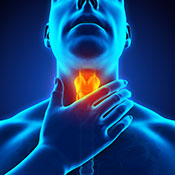 Illustration: ©iStock/Nerthuz (12/12/2018)
The drug cisplatin was superior to cetuximab in treating head and neck cancer along with radiation therapy, in a study by researchers from the Michael J Crescenz and James J. Peters VA medical centers. Both cisplatin and cetuximab are commonly given along with radiation therapy to treat head and neck squamous cell carcinoma. The researchers looked at 4,520 cancer patients over a period of three years. They found that those on cetuximab had significantly inferior overall survival, compared with patients taking cisplatin. The results suggest that cisplatin is the most appropriate drug partner for radiation therapy, say the researchers. (Cancer, Oct. 20, 2018)
|
Large genome study leads to better understanding of high blood pressure
 Photo by Jeff Bowen (12/04/2018)
A large international genetic study that included several VA researchers has identified more than 500 new gene locations that affect blood pressure. The project is the largest genetic study of blood pressure to date, involving more than 1 million participants. It included data from VA’s Million Veteran Program. By comparing participants’ genetic data, researchers identified 535 new locations on the human genome that influence blood pressure. The researchers calculate that the new findings increase the knowledge of inheritable blood pressure traits by 27 percent. They call the findings “an important step forward” in understanding how genes affect blood pressure. (Nature Genetics, October 2018)
|
Program improved staff interactions with residents
 Photo for illustrative purposes only. ©iStock/monkeybusinessimages (12/04/2018)
A training program improved interactions between staff and VA community living center residents, in a study by researchers at several VA facilities. The intervention centered on observations, huddles, and a focus on the positive. Researchers surveyed 62 residents and 308 staff members after the staff behavioral change program. Results showed increased communication and decreased negative staff intervention with residents after the training. Staff members credited the program with helping them to understand the importance of engagement and improving the quality of their interactions with residents. (Gerontologist, July 13, 2018)
|
White matter damage could explain chronic headaches after TBI
 Photo: ©iStock/wenht (12/04/2018)
Researchers with the VA San Diego Healthcare System have identified white matter abnormalities in the brains of patients with mild traumatic brain injury that may help explain their chronic headaches. The study used brain imaging data from 12 patients with TBI and chronic headache, compared with healthy controls. The TBI patients had abnormalities of the white matter in two brain tracts: the left superior longitudinal fasciculus, and the right anterior thalamic radiation. These tracts link different parts of the brain. This disruption of communication within the brain could be partly responsible for chronic headaches often experienced by patients with TBI, say the researchers. (Molecular Pain, Oct. 16, 2018)
|
Mouse study: Aspirin may slow multiple sclerosis
 Photo by Jerry Daliege (11/29/2018)
Low-dose aspirin could suppress multiple sclerosis symptoms and slow the disease, according to a mouse study by Jesse Brown VA Medical Center researchers. Mice with a condition similar to MS were given small doses of aspirin orally. Mice given aspirin show reduced symptoms for both relapsing-remitting and chronic forms of the disease. The aspirin also seems to have prevented destruction to the myelin sheath in the spinal cord caused by destructive T-cells. The researchers found that aspirin reversed the depletion of regulatory T-cells that occurs in MS, which may have helped stop other T-cells from attacking nerve fibers. While more study is needed, the results suggest that low-dose aspirin regimens could help patients with MS, say the researchers. (Science Signaling, Nov. 27, 2018)
|
Rural, urban ICUs perform similarly in VA system
 Photo: ©iStock/PeopleImages (11/29/2018)
Rural intensive care units (ICUs) in VA facilities perform similarly to their urban counterparts, found an Iowa City VA Health Care System study. Researchers looked at data on nearly 10,000 rural patients and almost 66,000 urban patients. They found that patients treated at rural ICUs had similar mortality rates, despite rural locations having lower-complexity facilities. Rural patients were less likely to have respiratory illnesses and more likely to have sepsis than urban patients, and they had higher illness severity scores. Rural patients also had fewer inter-hospital transfers and shorter ICU length of stay. The results indicate that being part of a national health care system may have benefits for rural facilities that should be explored outside the VA system, according to the researchers. (Journal of Critical Care, Oct. 19, 2018)
|
Study explains gene mutation’s link to ALS
 Photo: ©iStock/imaginima (11/29/2018)
Researchers at the VA Lexington Medical Center and University of Kentucky have shown how a gene mutation may contribute to the development of amyotrophic lateral sclerosis (ALS). Mutation to a gene called fused in sarcoma (FUS) are known to contribute to some cases of inherited ALS. The researchers showed that this mutation can suppress protein translation and interfere with how RNA functions in the body. The mutated proteins generated by the FUS gene disrupt an RNA quality-control pathway, which damages neuronal maintenance and function. Because this mutation suppresses how proteins are translated within cells and disrupts how RNA regulates cell activity, it likely contributes to the motor cell death seen in ALS. According to the researchers, the results will add to the understanding of both how this specific mutation can lead to inherited ALS, and more generally how ALS develops. (Proceedings of the National Academy of Sciences, Nov. 19, 2018)
|
Patients more likely to use psychotropic medication in suicide attempts when they have a prescription
 Photo: ©iStock/DNY59 (11/21/2018)
People at high risk for suicide who had a psychotropic medication prescription were more likely to use that type of drug in suicide attempts than those without a prescription, found a study including a Rocky Mountain Regional VA Medical Center researcher. The study looked at health insurance data for nearly 23,000 people who had attempted suicide. Those who had prescription access to a psychotropic drug were 1.7 times more likely to use that drug to attempt suicide than those without a prescription. People with antipsychotic or mood stabilizer prescriptions had the highest odds of using their prescription drug in a suicide attempt. Antianxiety drugs were the most common class of drugs used, regardless of prescription status, accounting for 59 percent of overdose attempts. The results show that people at risk for suicide with psychotropic prescriptions should be targeted for safety interventions, say the researchers. (Journal of Clinical Psychiatry, Nov. 6, 2018)
|
High cholesterol linked to lower risk of death in chronic kidney disease patients
 Photo: ©iStock/lbodvar (11/21/2018)
High cholesterol was linked to lower risk of death in chronic kidney disease patients, but higher risk of death in other patients, in a VA Long Beach Healthcare System study. Researchers looked at data on more than 2 million Veterans. They found that, in patients with chronic kidney disease, patients with cholesterol levels higher than 200 mg/dL had lower risk of all-cause death. However, patients without chronic kidney disease had a higher risk of death from cardiovascular conditions when their cholesterol was above 200 mg/dL. More research is needed to explore the seemingly paradoxical relationship between chronic kidney disease and cholesterol, according to the researchers. (American Heart Association Scientific Sessions, Nov. 10, 2018)
|
Reasons for trauma-focused therapy drop-out
 Photo: ©iStock/asiseeit (11/21/2018)
Minneapolis VA Healthcare System researchers explored why some Veterans with PTSD drop out of prolonged exposure and cognitive processing therapy, the two main forms of psychotherapy that VA uses to treat the condition. About one-third of Veterans who begin prolonged exposure and cognitive processing therapy do not complete treatment. Researchers interviewed 60 patients who completed treatment and 68 who did not to look for differences. They found differences between the groups in the strength of the working relationship between patient and therapist, patients’ ability to cope with increased distress, and internal motivation. Treatment buy-in, logistical factors such as transportation, and beliefs about treatment did not appear to influence the drop-out rate. (Annual Meeting of the International Society for Traumatic Stress Studies, Nov. 9, 2018)
|
Diabetes prevention program equally effective online and in person
 Photo: ©iStock/Wand_Prapan (11/14/2018)
Diabetes prevention programs delivered in person and online can be similarly effective for both older and younger Veterans, found a VA Ann Arbor Healthcare System study. Researchers looked at data from 378 Veterans enrolled in a weight management program either in-person or online. Over 70 percent of participants completed eight or more sessions within six months. A higher percentage of the online group completed at least eight sessions. Both online and in-person groups saw similar weight loss. Weight loss was the same for both younger participants and participants 65 or older. The results show that online programs may be an good way for diabetes prevention programs to reach older adults, say the researchers. (Diabetes Care, Oct. 30, 2018)
|
Benzodiazepine use linked to greater hospitalization, suicide risk in those with PTSD
 Photo: ©iStock/happyphoton (11/14/2018)
Patients with PTSD who were prescribed benzodiazepines, such as Valium or Xanax, had higher health care utilization and suicide risk than similar patients not given the drugs, in a study by VA Salt Lake City Health Care System researchers. They looked at data on more than 240,000 Veterans with PTSD. About 7 percent of those were prescribed benzodiazepines during the 14 years examined in the study. Patients prescribed benzodiazepines had more hospitalizations, as well as outpatient and mental health visits, than those not on the drug. Benzodiazepines users had a significantly greater risk of death from suicide, and were more likely to have suicide attempts or suicidal thoughts. The study strengthens the evidence against use of the drugs in Veterans with PTSD, according to the researchers. (Journal of Clinical Psychiatry, Oct. 23, 2018)
|
Household paints likely to contain rash-causing allergen
 Photo: ©iStock/gece33 (11/14/2018)
Household paints frequently contain isothiazolinones, despite claims on safety data sheets, according to a study featuring Minneapolis VA Medical Center researchers. Isothiazolinones are commonly used as preservatives in household products, but can cause allergic reactions. The researchers tested 47 common paints. All 47 contained at least one isothiazolinone. Concentration varied based on the type of isothiazolinone present. Isothiazolinones were present even in paint specifically advertised as being preservative-free. Safety data sheets, which are supposed to disclose potential allergens, were inaccurate and insufficient to warn against possible contact dermatitis, say the researchers. (Dermatitis, Oct. 20, 2018)
|
Omega-3 fatty acids boost neurological health after stroke in mice
 Photo: ©iStock/BlackJack3D (11/07/2018)
Omega-3 fatty acids were shown to improve neurological health after stroke, in a mouse study by VA Pittsburgh Health Care System researchers. The researchers gave mice food supplements of omega-3 polyunsaturated fatty acids, including from fish oil, for 35 days after a stroke. Mice given omega-3 had better cognitive function and neurovascular healing than those not on the supplements. Omega-3 was not as effective at improving cognitive function in older animals as in younger animals, although older animals did improve some. The results suggest that omega-3 fatty acid could be a promising therapy after stroke, say the researchers. (Neurobiology of Disease, Sept. 12, 2018)
|
Battlefield acupuncture effective in both groups and individually
 Photo by Robert Turtil (11/07/2018)
Battlefield acupuncture was effective in treating back pain in both group and individual settings, in a West Haven VA Medical Center study. In battlefield acupuncture, needles are placed in specific sites in the ear to influence the nervous system. The researchers treated 284 Veterans with back pain in either a group or individual setting, for a total of close to 800 treatment sessions. Patients self-reported a decrease in pain after 82 percent of treatments. Patients reported no change after 10 percent of treatments, and reported increased pain after 8 percent of the sessions. Both group and individual treatment had similar rates of effectiveness. The results confirm that battlefield acupuncture could be a useful treatment to relieve pain, whether administered in a group or individually. (Medical Acupuncture, Oct. 1, 2018)
|
Study reveals how lungs protect against damage from cigarette smoke
 ©iStock/bagi1998 (11/07/2018)
A study by VA Pittsburgh Healthcare System researchers explored mechanisms that protect the lungs from oxidants and how smoking can damage these processes. The researchers looked at two parts of the lungs’ defense system: an enzyme called GPx3 and a hormone receptor called PPAR-gamma. They found that GPx3 expression was decreased in the lungs of patients with chronic obstructive pulmonary disease (COPD). The study showed that PPAR-gamma responds to oxidative stress from cigarette smoke by increasing GPx3 production, which helps protect the lungs from damage. However, the researchers also found that cigarette smoke makes the relationship between GPx3 and PPAR-gamma less effective. They believe that the results could be useful in the development of more effective treatments for COPD. (Free Radical Biology and Medicine, October 2018)
|
Small molecule has potential as non-opioid pain drug
 Photo: ©iStock/kasto80 (11/02/2018)
A team featuring several VA researchers have discovered a non-narcotic drug that has potential to reduce neuropathic pain. The team designed and synthesized a small molecule that disrupts protein exchange in calcium channels in nerves. Calcium channels control the flow of molecules between nerve membranes, and have been shown to affect how pain is perceived. The channel targeted by the new molecule is important for the release of pain neurotransmitters in the spinal cord. When given to rodents, the molecule lowered their neuropathic pain response. This discovery has potential to be developed into a non-opioid pain medication, according to the researchers. (Proceedings of the National Academy of Sciences, Oct. 24, 2018)
|
Brain stimulation technique no better than sham version in depression study
 Brain illustration: ©iStock/cosmin4000 (11/02/2018)
In a trial sponsored by VA’s Cooperative Studies Program, Veterans receiving repetitive transcranial magnetic stimulation for major depression did not show greater signs of remission than those not undergoing the treatment. In TMS, an electromagnetic coil is placed on the head to stimulate a specific brain region. The researchers treated 164 Veterans with treatment-resistant major depression with either TMS or sham treatment. Of those receiving TMS, 41 percent saw remission of depressive symptoms. In the sham group, 37 percent saw remission. The difference was not statistically significant, say the researchers. The results do not support previous studies in civilians showing TMS to be effective for major depression. In fact, the FDA has approved TMS to treat depression that doesn’t respond to other treatments. The VA researchers believe the difference could be that Veterans often have multiple mental health conditions, making treatment more complex. They point to the fact that patients in the TMS group without PTSD were more likely that those with PTSD to achieve remission in the study. The researchers also note that the remission rate for both the TMS and sham groups was higher than seen in previous studies. They say this could be because Veterans had higher expectations of recovery and because their medications and other treatments were closely monitored. (JAMA Psychiatry, Sept. 1, 2018)
|
Study explores alcohol counseling for Vets in non-VA care
 Photo for illustrative purposes only. ©iStock/PeopleImages (11/02/2018)
Veterans were more likely than non-Veterans to be screened by doctors for heavy drinking, found a study by VA Pittsburgh and Puget Sound health care system researchers. While past research has shown that Veterans receiving care through VA have high rates of alcohol screening and intervention, less than 50 percent of Veterans in the U.S. use VA health care. The researchers looked at data on more than 92,000 people who had visited a non-VA doctor for a routine checkup within the last two years, 14 percent of whom were Veterans. The Veterans were more likely to be screened for alcohol quantity and heavy episodic drinking than non-Veterans. They were also more likely to receive advice about alcohol’s harmful effects. However, Veterans were not more likely to receive advice to reduce or abstain from drinking. The results point to some gaps in the delivery of recommended alcohol-related care, especially for vulnerable populations such as women Veterans, say the researchers. (Journal of Substance Abuse Treatment, Sept. 8, 2018)
|
Food environment can alter weight management effectiveness in men
 Photo for illustrative purposes only. ©iStock/gilaxia (10/25/2018)
The food environment in people’s neighborhoods slightly affects how effective VA’s MOVE! weight management program is, at least among men, found a study by VA Great Lakes Health Care System researchers and their colleagues. MOVE! is a VA program designed to help Veterans eat healthier, be more physically active, and achieve weight loss goals. Researchers studied data on MOVE! patients and community locations for a seven-year period. They found that the program was slightly less effective for men living near fast food restaurants or convenience stores. The food environment did not change the program’s effectiveness among women. The results highlight the importance of considering environmental and community factors in weight loss, say the researchers. (Health Services Research, Sept. 23, 2018)
|
More research needed on stem cell therapy for diabetic foot ulcers
 Photo: ©iStock/Hotaik Sung (10/25/2018)
Studies suggest that stem cell therapy could be an effective treatment for diabetic foot ulcers, but more research is needed on best techniques, according to a review by a team including a VA Connecticut Healthcare System researcher. Multiple studies have shown that stem cell therapy for diabetic foot ulcers is both safe and effective. However, studies varied widely on what stem cell type they used and how the treatment was delivered. Many different study designs were used, making it difficult to compare techniques. Because of these differences, the researchers emphasize the need for new studies to reach consensus on the best ways to test and deliver stem cell therapy for this condition. (Stem Cell Research & Therapy, July 11, 2018)
|
Studies teases out impact on kidneys of intensive blood pressure lowering
 Photo: ©iStock/Tashi-Delek (10/25/2018)
Two studies featuring several VA researchers found that intensive blood pressure lowering led to a decline in estimated glomerular filtration rate (eGFR), but not other signs of kidney damage. Doctors commonly use eGFR as a measure of kidney function. Previous research has suggested that intensive blood pressure control can lead to kidney injury. One study (ACCORD-BP) examined blood pressure risk in patients with diabetes. The other (SPRINT) looked at patients with high blood pressure who also had chronic kidney disease. Each study checked eGFR levels, as well as other biomarkers of kidney damage, in different groups of patients undergoing intensive blood pressure lowering treatment. Both found that intensive blood pressure lowering was linked with reductions in eGFR. However, neither study detected increases of biomarkers in the urine that usually indicate kidney damage. Both studies concluded that declines in eGFR may reflect hemodynamic changes—changes to blood flow—rather than actual kidney injury. (American Journal of Kidney Disease, Sept. 28, 2018)
|
PTSD not tied to asthma in Veteran study
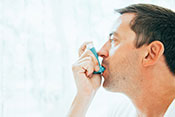 Photo for illustrative purposes only. ©iStock/Chalffy (10/17/2018)
PTSD was not linked to bronchodilator response, a marker of asthma, in a VA New Jersey Health Care System study. Past research has suggested that PTSD may be linked to symptoms of asthma in combat Veterans. To test this association, researchers looked at the breathing and PTSD symptoms of 188 Veterans of Iraq or Afghanistan. They found that responses to a bronchodilator—a drug that opens the airways, used to treat asthma—were not different between participants with and without PTSD symptoms. The researchers specifically looked at three symptoms of PTSD—re-experiencing, avoidance, and arousal—and did not find any link between any symptom and participants’ breathing. (Canadian Institute for Veteran and Military Health Research, Oct. 16, 2018)
|
The role of fatty acids in diabetic neuropathy
 Photo: ©iStock/JanIngeskogheim (10/17/2018)
Unsaturated fatty acids have potential for treating diabetic neuropathy, according to a review by a VA Iowa City Health Care System researcher. Diabetic neuropathy refers to nerve damage caused by diabetes. Multiple studies show that a diet high in saturated fat slows nerve function in rodents. Other studies with rodents suggest that unsaturated fats like omega-6 or omega-3 fatty acids could improve or even reverse vascular and neural problems. Studies show that resolvins, a type of unsaturated fatty acid, can promote neuron cell growth in diabetic mice. Omega-3 polyunsaturated fatty acids derived from fish oil have anti-inflammatory properties and could help with diabetic neuropathy, says the researcher. Clinical trials would be needed to test whether these substances would help people with diabetes. (Current Diabetes Reports, Aug. 25, 2018)
|
3D modeling of brain cells reveals protein changes linked to Alzheimer’s
 Photo: ©iStock/Henrik5000w (10/17/2018)
Researchers from the Edith Nourse Rogers Memorial Veterans Hospital in Bedford, Massachusetts, found protein alterations in neurons of Alzheimer’s disease patients by using a new technique. Studying neurons in a two-dimensional slide under a microscope, the usual way they are analyzed, does not give a full picture. The researchers created “neuro-spheroids,” 3D neuron cultures, using stem cells derived from patients’ blood cells. Using this technique, they found a number of alterations to proteins in the neurons of Alzheimer’s patients that would lead to dysfunction. When compared with postmortem brain tissue taken from Alzheimer’s patients, the 3D neurons showed similar dysfunction. The results show this type of 3D modeling could help find Alzheimer’s disease markers. The identified proteins could have important implications for the progression of the disease, say the researchers. (Journal of Proteomics, June 30, 2018)
|
Nursing home quality of care linked to cost
 Photo: ©iStock/LPETTET (10/10/2018)
Higher quality of nursing home care was linked to higher cost, in a study of 132 VA community living centers. Researchers looked at data from two years for all community living centers in the VA system. They measured quality of care by looking at rates of adverse health events (such as falls). Fewer adverse events were linked to higher predicted cost, suggesting that greater resources allocated to quality lead to better care. However, higher costs were not driven by higher nurse staffing levels. According to the researchers, more studies are needed to determine what precisely drives the relationship between quality and cost. (PLoS One, Sept. 19, 2018)
|
Evidence lacking on outcomes of genetic testing for statin resistance
 Photo: ©iStock/jxfzsy (10/10/2018)
Information is lacking on patient outcomes for statin-associated muscle symptoms (SAMS) after testing for the SLCO1B1 gene, according to a VA Boston Healthcare System literature review. SAMS refers to muscle pain and weakness sometimes caused by statin medication used to treat cardiovascular disease. Previous studies have shown that people with the SLCO1B1 gene are more likely to get SAMS. The researchers looked at 37 studies for evidence that testing for SLCO1B1 could lead to treatment changes and improved cholesterol levels in statin-intolerant patients. They found very few reports of patient outcomes after SLCO1B1 testing. More studies are needed to explore whether this type of genomic testing can lead to improvements in care, say the researchers. (Clinical Pharmacology and Therapeutics, Aug. 23, 2018)
|
Study suggests adverse health impact on sexual minorities from religious freedom law
 Photo: ©iStock/JacobStudio (10/10/2018)
A team including a VA researcher found that “unhealthy days” increased for Indiana residents identifying as sexual minorities after that state passed a religious freedom restoration act (RFRA). Statewide religious freedom restoration laws aim to protect the free exercise of religion by ensuring that any government interference must be for “compelling” interests, and must employ the “least restrictive means” possible. Some legal scholars have argued that RFRAs could potentially expose sexual minorities to more discrimination. And past research has shown that stigma and discrimination could worsen physical and mental health for sexual minority individuals. The researchers surveyed sexual-minority individuals in 21 states with RFRAs in 2015. They found the number of people reporting more than 14 “unhealthy days” per month increased quarterly in Indiana following the passing of an RFRA there. Unhealthy days did not increase for heterosexual people. This trend did not occur in other states. Indiana was the only state to pass and enact an RFRA in the time frame of the study. Other states already had RFRAs in place or had passed an RFRA but not put it into practice. Indiana also differed from other states in that its law applies to cases between private parties, not just those involving government. (American Journal of Orthopsychiatry, Sept. 24, 2018)
|
Telehealth a viable way to improve antimicrobial stewardship
 Photo: ©iStock/vm (10/04/2018)
A pilot telehealth program shows promise in improving infectious disease control at rural medical centers, according to a Louis Stokes Cleveland VA Medical Center study. Staff at two rural VA medical centers used videoconferencing to work with infectious disease physicians at other facilities. These videoconference antimicrobial stewardship teams (VASTs) held weekly meetings to discuss ways to combat antimicrobial resistance on a patient-by-patient basis. After a year of the program, one site accepted VAST recommendations in 73 percent of cases presented, and the other accepted 65 percent of the recommendations. Participants felt that the sessions improved their antimicrobial stewardship efforts and patient care. (Infection Control and Hospital Epidemiology, Sept. 6, 2018)
|
Mental health disorders linked with more unintended pregnancy
 Photo: ©iStock/Vasyl Dolmatov (10/04/2018)
Women Veterans with mental health disorders are more likely to have experienced unintended pregnancy than those without, found a study by VA Pittsburgh Health Care System researchers and colleagues. They surveyed almost 3,000 women Veterans by phone. Sixty percent of women with at least one mental health disorder reported having an unintended pregnancy, while 51 percent of women without a mental health disorder said they had had an unintended pregnancy. Mental health disorders were linked to a greater number of unintended pregnancies. Multiple mental health disorders were also connected to a greater number of unintended pregnancies. More research is needed on how to improve reproductive health outcomes for women with mental health disorders, say the researchers. (Journal of General Internal Medicine, Sept. 5, 2018)
|
Opioids not linked to better sleep for chronic pain patients
 Photo for illustrative purposes only. ©iStock fergusowen (10/04/2018)
Opioid use did not improve insomnia or fatigue for patients with chronic pain, in a Minneapolis VA Health Care System study. Insomnia is a common problem related to chronic pain. Researchers studied data on medication dosage and sleep disturbance for patients taking opioids or non-opioid medication for chronic pain. Over a year of treatment, neither group showed improvements in insomnia or fatigue despite improvements in pain severity. Medication dosage increased over the course of the trial. Patients with chronic pain commonly take extra opioid medication to sleep, but this increase did not lead to improved sleep. The results suggest that patients should be encouraged to used evidence-based behavioral sleep interventions to manage their insomnia, according to the researchers. (International Association for the Study of Pain, Sept. 13, 2018)
|
Early nonadherence to diabetes drugs leads to more heart attacks and strokes
 Photo: ©iStock/Wavebreakmedia (09/27/2018)
Patients who did not adhere early on to their medication treatment for type 2 diabetes were more likely to have poor health outcomes, found a study by VA Mid South Health Care Network researchers and their colleagues. Researchers looked at data for more than 159,000 Veterans with type 2 diabetes over an 11-year period. They measured patients’ adherence to oral diabetes medication by how often patients filled prescriptions in the first year of treatment. Patients who did not take their medication as prescribed were 14 percent more likely to have a heart attack in the five years after starting treatment, compared with those who took their medication. Those not regularly taking their medication were 22 percent more likely to have a stroke. The less compliant patients were to their medication regimen, the higher their chances were of having a heart attack or stroke. Those not adhering to treatment were also more likely to have died. The results underscore the need to help patients understand the importance of taking their oral antidiabetes medication regularly, say the researchers. (Diabetes Medicine, July 6, 2018)
|
Blood test could predict effectiveness of NSAID treatment in Alzheimer’s patients
 Photo by Derrick Morin (09/27/2018)
Blood tests could identify which Alzheimer’s disease patients will respond to non-steroid anti-inflammatory drug (NSAID) therapy, according to a study including a VA San Diego Healthcare System study. Previous research has shown the potential of NSAIDs to improve outcomes in Alzheimer’s patients because the disease has been linked to inflammation. An earlier study treated Alzheimer’s patients with two NSAIDs, rofecoxib and naproxen. In it, some patients improved and some declined in both groups as well as in controls. For the new study, researchers tested blood samples from these patients for four specific proteins that have been identified as inflammation biomarkers. They found that they could identify which patients in the rofecoxib group had cognitive improvements with 98 percent accuracy. They also predicted improvements in the naproxen group with 97 percent accuracy. The results show that a precision-medicine approach could identify which treatments will be most effective for specific patients with Alzheimer’s, according to the researchers. (Journal of Alzheimer’s Disease, Sept. 4, 2018)
|
Benzodiazepine prescribing higher than evidence warrants in older adults
 Photo for illustrative purposes only. ©iStock/BraunS (09/27/2018)
Prescribing of benzodiazepines may be higher than appropriate in older adults, according to a study that included several VA researchers. The team looked at use of the drugs across various health systems, not just in VA. Benzodiazepines are sedative drugs commonly prescribed for conditions such as insomnia, anxiety disorders, and behavioral and psychological symptoms of dementia. However, evidence suggest that these drugs could be dangerous for elderly patients. The researchers looked at 31 studies on the effects of benzodiazepines in patients over age 50 with the above three conditions. They found 21 studies that demonstrated improved insomnia outcomes. Only one study showed a benefit of the drugs for patients with anxiety disorder. They also found only a single study that showed improvements in behavioral disturbances in patients with dementia. The results suggest that benzodiazepine prescribing in older adults is higher than what is supported by evidence, according to the researchers. Studies are needed on how to reduce use of this type of drug in older patients, they say. (Harvard Review of Psychiatry, Sept/Oct 2018)
|
Brain peptide implicated in migraine pain
 Photo for illustrative purposes only. ©iStock/laflor (09/20/2018)
VA and University of Iowa researchers may have identified one of the sources of migraine pain. Researchers injected mice with calcitonin gene-relate peptide (CGRP), a substance naturally found in the brain that is believed to be related to nerve hypersensitivity and photosensitivity in migraine. They found that CGRP caused spontaneous pain in the mice, regardless of whether they were in light or darkness. When the researchers gave the mice an antibody that blocks CGRP receptors, the pain went away. They also found that the nonsteroidal anti-inflammatory drug meloxicam did not block the effects of CGRP. The antimigraine drug sumatriptan partially blocked CGRP response in male mice, but not females. (Pain, Sept. 1, 2018)
|
Suicide risk common in patients with anxiety
 Photo for illustrative purposes only. ©iStock/PeopleImages (09/20/2018)
A high number of patients with anxiety could be at risk for suicide, found a Syracuse VA Medical Center study. Researchers surveyed 182 primary care patients who had anxiety symptoms but were not in psychotherapy specialty care. Forty percent had elevated suicide risk, based on a standard assessment. Suicide risk was more common in patients who also had depression (51 percent) than in those who had anxiety alone (27 percent). The severity of anxiety symptoms did not affect patients’ suicide risk. The results suggest that primary care providers should assess suicide risk in patients with anxiety, even when patients are not seeking mental health treatment or when their anxiety symptoms do not rise to the level of an anxiety disorder, say the researchers. (Family Practice, Sept. 14, 2018)
|
Oxytocin fails to boost social cognition in schizophrenia trial
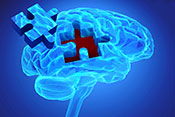 Illustration: ©iStock/goa_novi (09/20/2018)
Oxytocin did not improve social cognition in patients with schizophrenia, in a study by VA San Diego Healthcare System researchers and their colleagues. Social cognition refers to how a person deals with other people, including aspects like social knowledge and emotional processing. People with schizophrenia often have impaired social cognition. The researchers prescribed schizophrenic patients oxytocin—a drug that has been shown to improve social cognition in the general population—over 24 weeks, along with cognitive-behavioral training. Patients taking oxytocin showed no improvements in social cognition over the course of the study, compared with patients taking placebo. The results add to growing literature suggesting that oxytocin may not be effective in this population. (Psychological Medicine, Sept. 6, 2018)
|
Herbicide-related COPD rates differ between self-report and lung tests
 U.S. Army, via Wikimedia Commons (09/14/2018)
Herbicide exposure during the Vietnam War was linked to self-reported chronic obstructive pulmonary disease (COPD), but the link was not supported by lung tests, in a study by VA's Office of Patient Care Services. Researchers surveyed more than 3,000 Veterans of the U.S. Army Chemical Corps who served in Vietnam. Those who had actively sprayed herbicides during their service were nearly twice as likely to say they had been told by a doctor that they had COPD, compared with non-sprayers. However, when the survey respondents were examined with spirometry—a common test of lung function—people in the spraying group were not more likely to have COPD than the non-spraying group. The difference may be due to physicians diagnosing COPD based on symptoms rather than spirometry, according to the researchers. Spirometry is underutilized by physicians, they say. (American Journal of Industrial Medicine, Aug. 29, 2018)
|
PTSD may disrupt parasympathetic nervous system during sleep
 ©iStock/domoyega (09/14/2018)
Patients with PTSD had blunted parasympathetic nervous system modulation during sleep, found a Durham VA Health Care System study. The parasympathetic nervous system is the part of the nervous system that regulates rest and digestion. Heart-rate variability can be used to assess how well the parasympathetic system is working. Researchers studied the sleep of 62 post-9/11 Veterans and service members. They found that, for those with PTSD, high-frequency heart rate variability was lower during the non-rapid eye movement sleep phase, compared with those without PTSD. Impaired parasympathetic nervous system function increases the risk of cardiovascular events. This parasympathetic modulation could be one reason for the increased rates of cardiovascular disease among Veterans with PTSD, suggest the researchers.
Patients with PTSD had blunted parasympathetic nervous system modulation during sleep, found a Durham VA Health Care System study. The parasympathetic nervous system is the part of the nervous system that regulates rest and digestion. Heart-rate variability can be used to assess how well the parasympathetic system is working. Researchers studied the sleep of 62 post-9/11 Veterans and service members. They found that, for those with PTSD, high-frequency heart rate variability was lower during the non-rapid eye movement sleep phase, compared with those without PTSD. Impaired parasympathetic nervous system function increases the risk of cardiovascular events. This parasympathetic modulation could be one reason for the increased rates of cardiovascular disease among Veterans with PTSD, suggest the researchers. (Sleep, Aug. 29, 2018)
|
Development of a new non-addictive pain drug
 ©iStock/SeventyFour (09/14/2018)
A team including a researcher from the W.G. Hefner VA Medical Center in Salisbury, North Carolina, is working on a pain medication that could potentially work as well as opioids without being addictive. They developed a new compound, AT-121, that works on the mu opioid receptor, a protein that opioids interact with to block pain. AT-121 also activates the nociceptin receptor, which blocks the addictive side effects of opioids. Using non-human primates, the researchers showed that AT-121 gave the same level of pain relief as opioids without the risk of addiction that comes with opioids. The results suggest that this new drug could have potential to both safely and effectively relieve pain, and also treat prescription opioid abuse. More studies will be needed before AT-121 can be tested in humans. (Science Translational Medicine, Aug. 29, 2018)
|
Circadian rhythm disruption linked to cognitive decline in older men
 ©iStock/MladenZivkovic (09/14/2018)
Disruptions in circadian rhythm are linked to greater cognitive decline in older men, according to a study including a Minneapolis VA Health Care System researcher. Circadian rhythm refers to the body's natural sleeping and waking patterns. Over multiple follow-up visits during an average period of three years, the researchers found that men with disrupted rest-activity circadian rhythm had greater cognitive decline, as measured by a standard cognition test, compared with those without disrupted circadian rhythms. Rest-activity circadian rhythm was measured using an accelerometer that recorded any time a patient's wrist moved. Aging is often associated with altered rest-activity circadian rhythm. The results add to growing evidence that age-related disruptions to sleep pattern are connected to cognitive decline, say the researchers. (Journal of the American Geriatric Society, Aug. 23, 2018)
|
Complex relationship between alcohol consumption and psychiatric distress
 Photo for illustrative purposes only. ©iStock/South_agency (09/06/2018)
Hazardous drinking was linked to higher likelihood of psychiatric symptoms, while results of moderate drinking were mixed, in a study by Durham VA Health Care System researchers and colleagues. Previous studies have linked heavy drinking with increased depression and anxiety, but the it is not clear what cause-and-effect relationships, if any, may exist. The researchers collected data on alcohol use and psychiatric conditions for 3,003 Veterans. They found that hazardous drinkers were more likely to have PTSD, depression, and suicidality, compared with moderate drinkers. For men, moderate drinkers were less likely than nondrinkers to have depression and suicidality. However, this relationship disappeared when nondrinkers with past alcohol use disorder were removed from the calculations. Women moderate drinkers had lower rates of PTSD than nondrinkers and light drinkers, even when those with past AUD were removed. More research is needed on the possible protective effects of moderate drinking, say the researchers. Also, patients with a history of AUD may benefit from mental health screening and treatment, they say. (Journal of Studies on Alcohol and Drugs, July 2018)
|
Written exposure therapy effective as PTSD treatment
 Photo: ©iStock/PeopleImages (09/06/2018)
Written exposure therapy (WET) could be as effective as cognitive processing therapy in treating PTSD, according to a VA Boston Healthcare System study. WET involves five weekly sessions in which patients write for 30 minutes in detail about a single traumatic event associated with their PTSD. Cognitive processing therapy (CPT), a common PTSD treatment, involves learning how to evaluate and change upsetting thoughts. WET is shorter than CPT, which usually lasts for 12 sessions and includes homework between each session. Patients in both a WET and CPT group showed similar improvement of PTSD symptoms when assessed 60 weeks later. Both treatments significantly reduced depressive symptoms, although the CPT group did have a more rapid decrease in symptoms. WET takes a similar approach to prolonged exposure therapy, another common psychological PTSD treatment, in that both focus on directly confronting memories of trauma. Prolonged exposure is usually based on talking with a therapist, and generally involves more sessions than WET. The results show that WET could be a short and long-lasting treatment for PTSD. (Depression and Anxiety, Aug. 24, 2018)
|
Study shows two genes may be linked to suicide attempts
 Photo: ©iStock/vchal (09/06/2018)
Durham VA Medical Center researchers have identified two genes that may be related to suicidal behavior. They conducted a genome-wide association study, in which they compared the genomes of a large number of Veterans to look for variations common among those with history of suicidal behavior. The researchers found an association between a gene called KCNMB2 and suicide attempts. This gene plays a key role in neuronal excitability. They also found evidence that may link another gene, ABI3BP, to both suicide attempts and suicidal thoughts. While the results are interesting, the researchers caution that they are preliminary and need replication in further studies. (Psychiatry Research, July 17, 2018)
|
Group treatment program curbs intimate partner violence
 Photo: ©iStock/RomoloTavani (08/29/2018)
The Strength at Home program can successfully reduce intimate partner violence use, found a study by Central Texas and Boston VA health care system researchers. SAH is a 12-week cognitive-behavioral and trauma-informed group treatment designed to reduce and end IPV use among military and Veteran populations. The pilot program is part of a national program within VA to help Veterans who use or experience IPV. It was implemented at 10 VA medical centers over a year. Seventy percent of sites successfully launched the program in the first year. Results from 51 Veterans who participated in the program showed a significant reduction in the number who exhibited violence toward a partner. The participants also showed reduced PTSD symptoms. While the pilot program showed overall successful implementation, more work is needed to reduce the time between initial training and the start of group treatment, according to the researchers. (BMC Health Services Research, July 24, 2018)
|
Repeated ketamine infusions may ease PTSD and depression
 Photo: ©iStock/stevecoleimages (08/29/2018)
Repeated ketamine infusions may improve PTSD and depression symptoms, according to a Minneapolis VA Health Care System study. Researchers gave 15 people with both PTSD and major depressive disorder six intravenous infusions of ketamine—a medication used mainly for anesthesia—over two weeks. Eighty percent had remission of PTSD symptoms immediately after treatment. The remission lasted a median of 41 days. For major depressive disorder, 93 percent experienced remission of symptoms, which lasted a median of 20 days. The results suggest that repeated ketamine treatments are safe and may be an effective treatment for people with both PTSD and major depressive disorder, say the researchers. (Journal of Clinical Psychiatry, May/June 2018)
|
Review study: Mind-body treatments show promise for PTSD
 Photo for illustrative purposes only. ©iStock/jacoblund (08/29/2018)
Studies show that mind-body treatments are promising for treating PTSD, found a literature review by VA Boston Healthcare System researchers. The researchers looked at 22 randomized controlled trials on mind-body techniques. Nine mindfulness and six yoga studies showed significant improvements in PTSD symptoms, compared with control groups. Seven studies showed large symptom improvements from relaxation interventions, even though relaxation was used as the control condition in these studies. While many studies on mind-body interventions have methodology weaknesses, the researchers found increased scientific rigor in recent studies. The results overall show increasing evidence on the benefits of mindfulness, yoga, and relaxation for PTSD. (Journal of Clinical Psychology, May 10, 2018)
|
Depression drives nursing home placement in older women
 Photo for illustrative purposes only. ©iStock/KatarzynaBialasiewicz (08/23/2018)
More severe depression symptoms led to higher rates of nursing home placement in women, found a study by San Francisco and Minneapolis VA health care systems. Researchers looked at data for more than 9,000 older women over a 20-year period. They found that women with low or moderate depressive symptom burden were twice as likely to move from community living to a nursing home, compared with women with minimal burden. Those with high burden were three times as likely. Antidepressant use only slightly affected this relationship. The results show the importance of improving recognition, monitoring, and treatment of depression early to reduce or delay nursing home placement, say the researchers. (Journal of the American Geriatric Society, Aug. 9, 2018)
|
Postconcussive symptoms predict opioid prescriptions
 Photo: ©iStock/VladimirSorokin (08/23/2018)
Traumatic brain injury symptoms predicted opioid prescriptions for chronic pain for Veterans, in a San Francisco VA Health Care System study. Opioids are not recommended for patients with neuropsychological impairment from traumatic brain injury. However, clinical guidelines are not always adhered to in actual practice. Researchers studied the records of 53,124 Iraq and Afghanistan Veterans with chronic pain diagnoses from VA providers during a nine-year period. Self-reported severe and very severe postconcussive symptoms predicted starting long-term or short-term opioid use for chronic pain. The results indicate a need to educate prescribers and make non-opioid pain management options more available for Veterans, according to the researchers. (Brain Injury, July 9, 2018)
|
Mild ozone exposure can cause breathing problems
 Photo for illustrative purposes only. ©iStock/Wavebreakmedia (08/23/2018)
Low-level ozone exposure causes breathing problems and lung damage in older people, according to a study led by a San Francisco VA Medical Center researcher. Ozone, a gas commonly found in the upper atmosphere, is considered a pollutant when present in lower levels of the atmosphere. Researchers exposed healthy adults to low concentrations of ozone for three hours, with intermittent exercise. Tests showed worse lung function after exposure to ozone, with higher ozone concentration linked to worse function. This decreased lung function was still noticeable 22 hours later. The results show that ozone can decrease lung function and cause airway injury and inflammation in older adults. The U.S. Environmental Protection Agency suggests regularly checking air-quality reports for levels of ozone and other irritants, especially for people with conditions such as asthma. (American Journal of Respiratory and Critical Care Medicine, May 15, 2018)
|
New approach to target drug treatment to painful joints
 Photo: ©iStock/solidcolours (08/15/2018)
Baltimore VA Medical Center researchers have designed a method that could more effectively deliver drugs directly to the joints to treat rheumatoid arthritis. Arthritis medications can cause damage to other organs because they affect the whole body rather than just the joints. Researchers used a liposome (a sphere of molecules surrounding another material, such as a medication) containing the peptide ART-1 to target medication to joint cells. A peptide is a chain of amino acids. ART-1 has been shown to bind to the endothelial cells in joints. Researchers injected this compound into rats with arthritis. They found that the injection containing ART-1 suppressed the disease better than a control that did not have ART-1. The ART-1 liposome also appeared to be safer than liposomes not directed by the peptide, which interacted with more parts of the body than the joints. The results show that ART-1 could be used to home in on the joints to treat rheumatoid arthritis. (Journal of Controlled Release, Aug. 4, 2018)
|
Patient perspectives on opioids
 Photo for illustrative purposes only. ©iStock/ClarkandCompany (08/15/2018)
Iowa City VA Healthcare System researchers interviewed 19 hospitalized Veterans about their chronic pain to get their perspective on opioids and other care. Patients were not asked about opioids specifically. Most patients brought up opioids themselves. Interviewees expressed views that other patients were the problem, meaning they thought opioid access was limited because other people were misusing opioids. They had empathy for providers, whom they saw as working under prescribing constraints. Most also viewed opioids as a last resort for treating pain. The results show that engaging hospitalized patients in conversations about opioids and alternative pain management would be useful, and that providers would benefit from increased awareness of chronic pain, say the researchers. (Pain Medicine, July 17, 2018)
|
Sailing therapy helpful in substance use disorders
 Photo: ©iStock/LeoPatrizi (08/15/2018)
Sailing adventure therapy may be a positive and calming activity for Veterans with substance use disorder, according to a George E. Wahlen VA Medical Center study. Twenty-two Veterans participated in the pilot study. In the therapy, participants sailed on a reservoir with an instructor for three hours, including instructional time. Each participant went to three sessions, once per month. They manned various positions on the sail boat, helped rig the sails, and watched out for other boats. After each trip, they took turns describing what the experience had been like for them personally and were encouraged to share whether they had learned anything about themselves from the experience. The activity did not increase anxiety or negatively affect the participants. Results show that this therapy may increase psychological flexibility and enhance treatment response, based on questionnaires given after the therapy. The results suggest that sailing adventure therapy could be a low-risk intervention for Veterans with substance use disorder, according to the researchers. (Complementary Therapies in Medicine, October 2018)
|
Urine biomarkers may warn of kidney damage from ventilation
 Photo: ©iStock/Natali_Mis (08/08/2018)
Novel urine biomarkers could give an early warning on kidney injury caused by mechanical ventilation, say VA San Diego Health Care System and University of California San Diego researchers. Previous research has linked mechanical ventilation to acute kidney injury. This link may be due to damage to the lungs and circulatory system, or blood flow changes to the kidney. Low-tidal volume—when less air is taken into the lungs with each breath—could help prevent this kidney injury. Several biomarkers (such as mitochondrial byproducts) have recently been found to show kidney dysfunction before permanent injury. By testing for these biomarkers in the urine, clinicians may be able to time when ventilation needs to be adjusted to prevent kidney injury, according to the researchers. (Nephron, July 11, 2018)
|
Battlefield acupuncture may reduce opioid use after surgery
 Photo by Robert Turtil, for illustrative purposes only. (08/08/2018)
Battlefield acupuncture may reduce the need for opioid use after surgery, found a John D. Dingell VA Medical Center study. In battlefield acupuncture, needles are placed in and around the ear to influence how the central nervous system processes pain. In a study of 39 patients, those who had this treatment after general surgery had significantly lower opioid use in the following 24 hours, compared to those not given acupuncture. Patients in the acupuncture group also had 15 percent less post-operative nausea and vomiting. Previous studies have shown that this type of acupuncture can reduce the stress response after surgery, aiding in recovery. The results suggest that battlefield acupuncture could be a low-cost, effective, safe, and easy to implement means of reducing post-operative pain, say the researchers. (2018 World Congress on Regional Anesthesia & Pain Medicine, April 19, 2018)
|
Health care performance measures may not be accurate for older patients
 Photo for illustrative purposes only. ©iStock/FatCamera (08/08/2018)
Standard measures of health care quality may not accurately rate care for higher risk patients, according to a VA Greater Los Angeles Healthcare System study. Measures based on processes of care—such as breast cancer screenings—are frequently used to compare health care performance. To see whether these measures are biased against older and sicker patients, researchers looked at national data on mortality risk from a 14-year period. They found that providers serving high-risk patients rated significantly worse (67 percent performance score) than for low-risk patients (74 percent). Clinicians may choose not to use recommended processes based on limited prognosis, patient preference, or potential adverse effects when patients are older and have more illnesses. The resulting poor performance scores may lead to financial penalties or excessive administrative work. The results suggest that process of care ratings may not be the best fit to evaluate all situations. (Journal of the American Geriatric Society, Aug. 6, 2018)
|
Lab study suggests novel RNA treatment could improve brain function after TBI
 Photo: ©iStock/Ivcandy (08/01/2018)
James A. Haley Veterans Hospital and University of South Florida researchers showed that injections of a type of RNA could improve brain function after a traumatic brain injury, in rats. The researchers injected injured rats with cell structures called exosomes, which they got from stem cells in human fat tissue. The exosomes contain MALAT1, a type of RNA (a form of genetic material). The rats injected with exosomes showed significant recovery of function of motor behavior, as well as a reduction in cortical brain injury. Analysis of the brain and spleen showed that MALAT1 could ease brain inflammation at a genomic level. The spleen is involved in protective substances such as white blood cells entering the blood stream after injury. The results show that using exosomes containing MALAT1 has "tremendous" potential for treatment of TBI, say the researchers. (Journal of Neuroinflammation, July 12, 2018)
|
Algorithm can identify urine-test results showing cannabis use
 Photo: ©iStock/courtneyk (08/01/2018)
VA Portland Health Care System researchers have developed an algorithm to identify cannabis urine drug test results in electronic health records. Although VA does not prescribe cannabis, in accordance with federal law, many states now allow medical cannabis use. Many patients are now using medical cannabis, particularly for chronic pain. While it may be important for doctors to know of this use, how the results of drug tests are reported varies widely. The researchers created a computer algorithm to identify the results of urine tests within the VA electronic health records. They tested the algorithm on a sample of VA patients who were prescribed long-term opioid therapy for chronic pain. The algorithm correctly identified cannabis-positive results for 99 percent of patients who used cannabis. It identified cannabis-negative results with 100 percent accuracy. The findings suggest that this algorithm is an effective way to identify urine test results for cannabis use within the electronic health record, despite inconsistent reporting practices. (Journal of Medical Systems, July 24, 2018)
|
VA emergency departments vary widely in opioid prescribing
 Photo: ©iStock/dusanpetkovic (08/01/2018)
Opioid prescribing rates vary widely in VA emergency departments (EDs), found a study by the VA Pharmacy Benefits Management program. The researchers looked at data on opioid prescribing for pain in 118 VA EDs between January and March 2017. The percentage of patients prescribed an opioid ranged from 1 percent to 24 percent, depending on facility. For individual clinicians, opioid prescribing rate varied between 0.2 percent and 57 percent. While nationwide interventions to promote safe opioid prescribing have resulted in lower overall opioid prescriptions in VA since 2011, much variation still remains based on geographic area and individual behavior. Targeting interventions for providers may be more effective than general prescribing guidelines at changing how opioids are prescribed in VA EDs, say the researchers. (Journal of General Internal Medicine, July 23, 2018)
|
Availability of non-VA health care lacking for rural Veterans, despite Veterans Choice Act
 Photo: ©iStock/davidperks (07/27/2018)
The Veterans Choice Act may not significantly improve rural Veterans' access to health care due to a shortage of non-VA providers, according to an Iowa City VA Medical Center study. Under the Veterans Choice Act, VA will pay for medical care from non-VA providers for Veterans who live more than 40 miles from a VA facility. Pending legislation is set to expand on the Veterans Choice Act and replace it. To see how the existing act or future versions could affect Veterans' access to care, researchers looked at data on both where rural Veterans live and what health care is available in those areas. They found that 16 percent of rural Veterans live in an area with primary care shortages, and 70 percent in mental health care shortage areas. Most rural Veterans lived in counties that lacked specialized care such as cardiologists and neurologists. In fact, VA played a greater role in delivering health care in areas where Veterans were eligible for the Veterans Choice Act, compared with less rural areas. The results show that programs such as telehealth are needed to supplement non-VA health care in rural areas, which may be lacking, say the researchers. (BMC Health Care Services, May 29, 2018)
|
Mouse study questions whether tau protein leads to brain degeneration after TBI
 Photo: ©iStock/D-Keine (07/27/2018)
A mouse study suggests that the build-up of a protein in the brain is not a cause of traumatic encephalopathy following a traumatic brain injury, counter to evidence from previous studies. James A. Haley Veterans Hospital researchers and their colleagues studied the build-up of tau proteins in the brain matter of mice after traumatic brain injury. Other research has documented increased tau protein in patients with chronic traumatic encephalopathy, a degenerative brain disease linked to dementia. Researchers on the new study found modest increases in tau protein in the brain after both a single and repetitive mild TBI. However, in both cases the protein was reabsorbed by the brain within 12 months after injury, with no evidence of excess build-up. Moreover, increased tau protein in the brain was not linked to worse cognitive performance in the mice. The results may mean that while there may be short-term tau protein build-up after TBI, this condition is not likely to directly cause post-TBI cognitive problems. (Journal of Neurotrauma, June 11, 2018)
|
Acquired stuttering after TBI and PTSD could be linked to medications
 Photo: ©iStock/Ivan-balvan (07/27/2018)
Veterans with both traumatic brain injury and PTSD were more likely to be diagnosed with acquired stuttering, and the condition could be linked to medications they were prescribed, found a South Texas Veterans Health Care System study. Researchers looked at data on more than 300,000 Iraq and Afghanistan Veterans. They found that 235 were diagnosed with acquired stuttering after their deployment. Of those, 43 percent had both TBI and PTSD. These patients had a greater likelihood of stuttering than those with only one or neither condition. Furthermore, over 66 percent of patients with stuttering were prescribed a medication that affects speech fluency, such as antidepressants and antiepileptic drugs. Based on the results, the researchers suggest that clinicians treating Veterans with complex conditions should consider the impact of medications on speech fluency. (Military Medicine, April 18, 2018)
|
Mantram meditation more effective than present-centered therapy at reducing PTSD symptoms
 Photo for illustrative purposes only. ©iStock/laflor (07/19/2018)
Mantram therapy was more effective than present-centered therapy at reducing PTSD symptoms, in a VA San Diego and New England Health Care System study. Patients with PTSD underwent eight weekly one-hour session of either mantram or present-centered therapy. In mantram meditation therapy, patients repeat a word or phrase with spiritual meaning to slow down thoughts and focus attention. Present-centered therapy focuses on currently stressful events and problem-solving skills. Those in the mantram group had significantly lower scores on a PTSD symptom scale after treatment and two months later. The mantram group also had lower self-reported PTSD symptoms and less insomnia. The results show that non-trauma focused complementary approaches such as mantram therapy can help alleviate PTSD symptoms, say the researchers. (American Journal of Psychiatry, June 20, 2018)
|
Intensive management outpatient program has similar cost to usual care
 Photo: ©iStock/Sasha_Suzi (07/19/2018)
High-risk patients received more outpatient care with no increase in total cost from an intensive management program, found a study at five VA medical centers. More than 2,000 patients with an average of seven chronic conditions were given either intensive outpatient management or usual care for one year. Intensive management involves care coordination, goals assessment, health coaching, medication reconciliation, and home visits through an interdisciplinary team. Those in the intensive management had an average of $2,164 lower inpatient costs than the usual care group. The intensive management had an average of $2,636 more in outpatient costs. Average total costs were similar for both groups. The results show that intensive management has potential, but room exists to improve the program and make it more efficient, according to the researchers. (Annals of Internal Medicine, June 19, 2018)
|
Possible mechanism behind TBI-related sleep-wake disturbances
 Photo: ©iStock/theasis (07/19/2018)
Researchers with the VA Portland Health Care System may have demonstrated how traumatic brain injury affects the sleep-wake pattern of the brain, using a mouse model. TBI often causes sleep-wake disturbances, such as excessive daytime sleepiness. Researchers have hypothesized that this is because of damage to neurons that make orexin, a hormone that regulates sleep. By studying the brains of mice with TBI, the researchers found that decreased density of the amino acid glutamate—which helps neurons function—could be responsible for problems with the orexin neurons. They also found that giving the mice branched-chain amino acid supplements through their food helped restore glutamate density and orexin neuron function. The results open up a path to potential therapy for sleep-wake disturbances caused by TBI. (Sleep, March 1, 2018)
|
Study shows safety of brain stimulation together with exposure therapy for PTSD
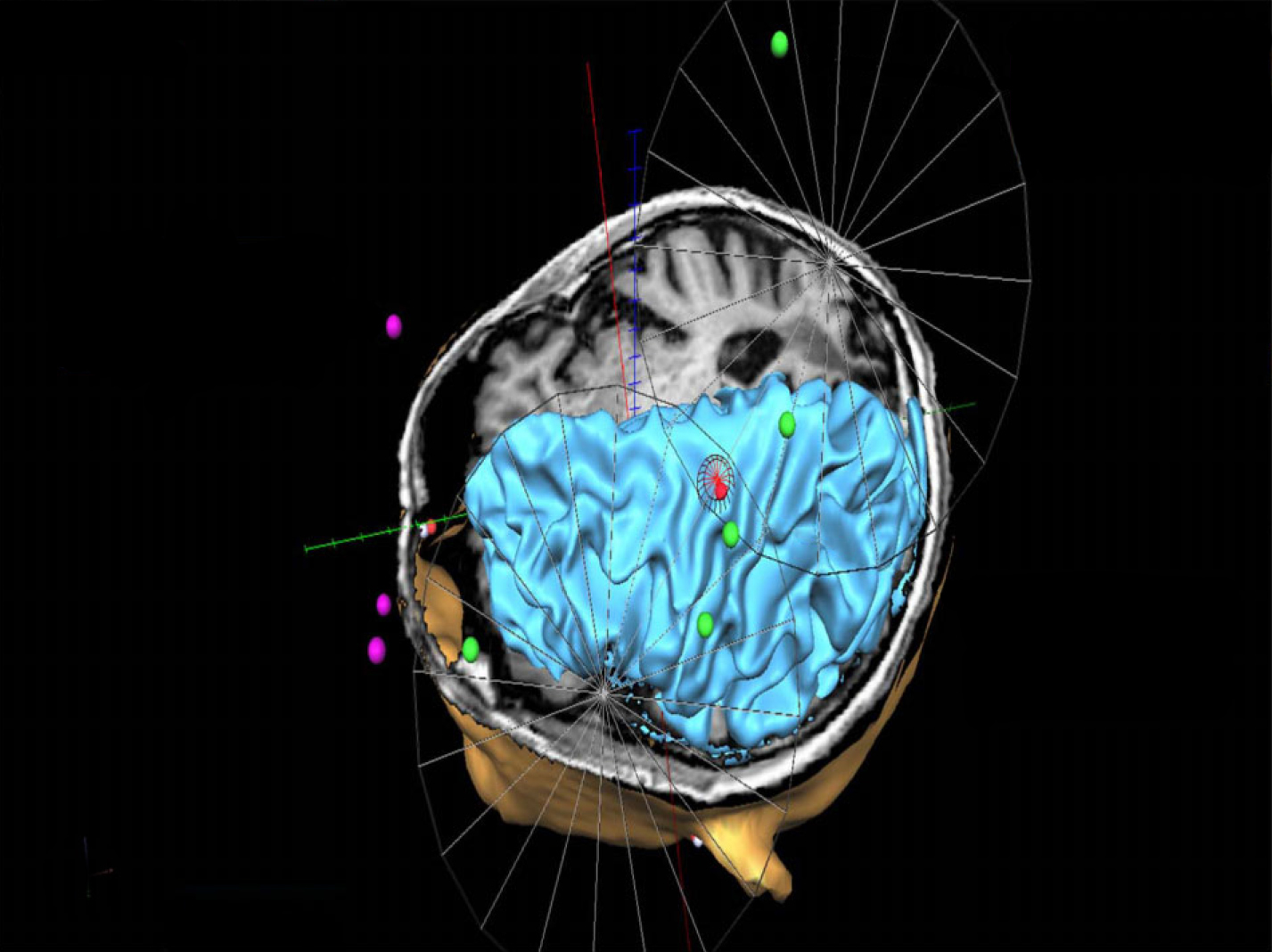 Image courtesy of Dr. Albert Leung (07/11/2018)
Transcranial magnetic stimulation (TMS) along with prolonged exposure therapy may be beneficial for patients with PTSD, according to a Ralph H. Johnson VA Medical Center study. Eight patients with PTSD undergoing prolonged exposure therapy received either weekly repetitive TMS for five weeks or a control adjunct treatment. In TMS, a magnet is applied to the outside of the head to affect the electrical fields in the brain. Patients in the TMS group showed a trend toward improvement of PTSD symptoms, although the change was not statistically significant. The study demonstrates that TMS is safe to be delivered to PTSD patients while they are receiving prolonged exposure therapy. Larger studies are needed to see if this technique can be an effective treatment, say the researchers. (Journal of Electroconvulsive Therapy, June 26, 2018)
|
Movement-based therapies yield multiple benefits for patients with chronic conditions
 Photo by Robert Turtil (07/11/2018)
Patients saw improvements in a number of areas as a result of movement-based therapies, in a VA New England Healthcare System study. Researchers surveyed a focus group of 31 patients enrolled in yoga and qi gong programs for chronic conditions at two VA medical centers. The participants described improved physical and mental health, reduced opiate and psychotropic use, enhanced emotional well-being, and better social relationships as a result of the treatment. They attributed these changes to physical improvements, development of coping skills, and increased self-awareness. The researchers suggest health care providers consider referring patients with chronic conditions to movement-based complementary and integrative health therapies alongside usual care. (Chronic Illness, Jan. 1, 2018)
|
New drug-resistant form of E. coli rapidly spreading
 Photo: ©iStock/Dr_Microbe (07/11/2018)
A team including a Minneapolis VA Healthcare System researcher tracked the spread of a new drug-resistant strain of E. coli. The team gathered data on more than 6,000 E. coli infections at nine hospitals, including at the Minneapolis VA Medical Center. Twenty-one percent of the infections were resistant to fluoroquinolones, a common antibiotic. The most common strain of drug-resistant strain of E. coli was H30. The prevalence of this strain—which has been known since the 1990s—did not increase from the study years of 2016 to 2016. The second most common type of E. coli was ST1193. This strain is newer than H30, and its prevalence increased sevenfold between 2016 and 2017. It is more likely to occur in younger patients. The results show that the ST1193 of drug-resistant E. coli is on the rise, say the researchers, and more studies are needed on how to limit its spread. (Clinical Infectious Diseases, June 29, 2018)
|
Irregular discharges tied to higher suicide risk
 Photo for illustrative purposes only. ©Stock/Tempura (07/05/2018)
Patients are at an increased suicide risk after irregular hospital discharges, according to VA researchers in New England and Ann Arbor. Irregular hospital discharges include a patient leaving the hospital against medical advice and other unplanned discharges. The researchers looked at data on more than 5 million inpatient discharges from VA facilities between 2001 and 2014. About 2 percent were irregular. Patients with an irregular discharge from a general medical ward had three times higher risk of suicide than those discharged normally a year after their discharge. Patients with an irregular discharge from psychiatric care did not have higher suicide risk based on discharge type. The findings give important information on patient populations that may need to be targeted for suicide prevention, say the researchers. (Psychiatric Services, June 1, 2018)
|
Dialysis patients have lower mortality in VA vs. non-VA centers
 Photo: ©iStock/porpeller (07/05/2018)
Patients who initiated dialysis at VA facilities had lower mortality than patients who used non-VA dialysis centers, found a study of nearly 70,000 VA patients. Researchers looked at Veterans with end-stage kidney disease who began dialysis between 2007 and 2014. Ten percent used VA dialysis centers. Those in VA facilities were 13 percent less likely to die in the 12 months after they began dialysis. Along with that, patients in VA facilities were more likely than those in outside centers to be hospitalized at some point in the following year. The researchers suggest that the better outcomes may relate to VA's integrated health care system. Most VA dialysis centers are located within larger VA facilities. VA's integrated system may mean that patients are receiving more intense care addressing their health problems and have an easier transfer to hospital admission, say the researchers. (Clinical Journal of the American Society of Nephrology, June 14, 2018)
|
ICU telemedicine lowers hospital transfers
 Photo: ©iStock/Donghero (07/05/2018)
Intensive-care unit (ICU) telemedicine was linked to decreased interhospital transfers in an Iowa City VA Health Care System study. In ICU telemedicine, intensivist doctors can provide remote care to patients at regional facilities that may lack specialized personnel. The researchers looked at data for more than 550,000 admissions at 306 VA ICUs during a five-year period. Transfers to other hospitals decreased by 42 percent in hospitals with telemedicine programs, compared with a decrease of 7 percent in non-telemedicine hospitals during the same time period. The results may show that telemedicine allows hospitals to better evaluate when patients may effectively be treated locally, say the researchers. While ICU telemedicine did not reduce mortality in the study, past research suggests that limiting interhospital transfers lowers costs and improves patient, family, and staff satisfaction. (Chest, June 5, 2018)
|
Electrical signal change may explain link between combat exposure and psychiatric disorders
 Photo by Jerry Daliege (06/27/2018)
Increased error-related negativity (ERN) may help explain why combat exposure increases the risk of psychiatric disorders, found a Jesse Brown VA Medical Center and University of Illinois at Chicago study. ERN refers to a change in electrical signals in the brain as a result of making a mistake in a motor or cognitive task. Past research has linked it to various psychiatric disorders, such as anxiety and alcohol use disorders. In a study of 62 Veterans, the researchers used electroencephalography to show that those with greater combat exposure had greater ERN. This effect held true even after adjusting for anxiety and PTSD symptoms. The level of ERN was not associated with other life stressors before or after deployment, suggesting that this effect is specific to combat exposure. The results suggest that ERN may be one mechanism for how combat exposure increases the risk of psychiatric disorders, say the researchers, and could be a valuable screening tool for psychiatric disorder risk. (International Journal of Psychopsychology, July 2018)
|
Increased travel reimbursement leads to more VA health care use
 Photo: ©iStock/KarenMassier (06/27/2018)
Increased reimbursement for travel led to more VA outpatient use, found a VA Salt Lake City Health Care System study. A recent VA policy change increased how much Veterans can be reimbursed for travel expenses to receive VA health care. To study the effects of this change, researchers looked at data for 110,007 Veterans nationwide. They found that the number of VA outpatient visits increased by more than 30 percent after the rule change. The greatest increase was in Veterans living in rural areas. The number of non-VA outpatient care visits for rural Veterans also significantly decreased. A 2014 policy allows eligible Veterans to use their VA-provided health care at non-VA facilities. The results indicate how health care utilization may be affected by future policy changes. (Medical Care, July 2018)
|
Mental health service use remains stable after PTSD disability rating
 Photo: ©iStock/amesy (06/27/2018)
Use of VA mental health services largely remains stable after receipt of a service-connected disability for PTSD, according to a study by VA researchers in Ann Arbor and Boston. Some concern exists that Veterans will stop using mental health services after receiving service-connected disability benefits for PTSD, but actual usage patterns are not well-understood. Researchers looked at mental health service utilization for more than 22,000 Veterans one year before and after they received service-connected disability ratings for PTSD. They found that use remained stable for 80 percent of patients. Nine percent increased their use, and 11 percent decreased their use. While disability rating largely did not alter mental health service usage patterns, the researchers did find generally low utilization of these services. Opportunities exist to enhance outreach for Veterans with PTSD-related disability benefits, they conclude. (Health Services Research, April 17, 2018)
|
Review: Childhood sexual abuse can lead to sexual dysfunction in women
 Photo: ©iStock/chameleonseye (06/21/2018)
A review by Doris Miller VA Medical Center and University of Texas at Austin researchers confirmed that women with childhood sexual abuse histories had higher rates of sexual dysfunction, compared with women without a history of abuse. Lack of positive emotions related to sexuality appears to be the most relevant factor in sexual dysfunction. Lack of positive emotions was more common than direct negative emotions connected to sexuality. Studies show that mindfulness-based sex therapy and expressive writing treatments are effective for this group. More studies are needed on exactly how childhood sexual abuse can lead to sexual dysfunction, say the researchers. (Sexual Medical Reviews, April 2018)
|
If taller people are 'smarter,’ why is that? Brain study offers insight
 Photo for illustrative purposes only. ©iStock/XiXinXing (06/21/2018)
Cortical surface area may explain the connection between height and cognitive ability, found a study including a VA San Diego Healthcare System researcher. Previous studies have shown that greater height is correlated with greater general cognitive ability. But the reason for this relationship is not well-understood. The researchers looked at data from 515 participants of the Vietnam Era Twin Study of Aging. General cognitive ability was based on the Armed Forces Qualification Test, a measure similar to IQ. The researchers found that cortical surface area (brain size, taking into account the folds and layers of brain matter) is positively linked to cognitive ability. Taller people tend to have larger brains, and larger brains are linked to higher cognitive ability. Cortical thickness (total thickness of all brain layers) was not linked to cognitive ability. (Brain Structure & Function, May 11, 2018)
|
Suicidal behavior common with schizophrenia and bipolar disorder
 Photo: ©iStock/efks (06/21/2018)
A recent study confirmed that suicidal behavior is common among Veterans with schizophrenia or bipolar disorder. Researchers from the Bruce W. Carter VA Medical Center and VA Connecticut Healthcare System collected data on 3,942 Veterans with schizophrenia and 5,414 with bipolar disorder. They found that 70 percent of Veterans with schizophrenia had a history of suicidal thoughts or behavior. Of those with bipolar disorder, 82 percent had a history of suicidal thoughts or behavior. Veterans with more than one psychiatric condition were at the highest risk of suicide. The results underscore the need for continuous monitoring for suicidal behavior in patients with severe mental illness. (Journal of Psychiatric Research, April 21, 2018)
|
Homeless Veterans are more satisfied with specially tailored care teams
 Photo for illustrative purposes only. ©iStock/seb_ra (06/14/2018)
Homeless Veterans at VHA facilities with tailored primary care teams had better care experiences than non-homeless Veterans, according to a National Center on Homelessness Among Veterans study. Researchers surveyed more than 340,000 Veterans receiving care through VHA nationwide. About 4 percent were homeless. In facilities without homeless-tailored teams, homeless patients had more negative and fewer positive experiences than non-homeless patients. In facilities with Homeless Patient Aligned Care Teams (HPACTs), this pattern was reversed. HPACTs appear to offer homeless Veterans a better primary care experience than that received by non-homeless Veterans. (Medical Care, May 12, 2018)
|
Fluorouracil cream may lower treatment cost for those at high risk for skin cancer
 Photo: ©iStock/kali9 (06/14/2018)
Treating patients at high risk for two skin cancer conditions with topical fluorouracil cream can provide cost savings, found a VA Palo Alto Health Care System study. Previous research shows that fluorouracil reduces incidence of keratinocyte carcinoma (nonmelanoma skin cancer) and actinic keratosis (a precancerous skin condition). Patients at high risk for the conditions applied either the fluorouracil or a placebo cream to their faces and ears for four weeks. After one year, those not using fluorouracil had more treatment visits for squamous cell carcinoma than those using it. Over three years, patients using fluorouracil had average treatment costs of $771 less per patient. (Journal of the American Academy of Dermatology, March 2, 2018)
|
Photodynamic therapy may effectively treat bladder cancer
 Photo: ©iStock/wildpixel (06/14/2018)
A group including a VA Northern California Health Care System researcher showed that a photodynamic therapy technique could effectively treat bladder cancer. In photodynamic therapy, medication that is activated by light and heat is injected into the body. The cancer site can then be exposed to light, which allows the cancer cells to be closely targeted. This process has significantly fewer side effects than treatments such as chemotherapy. The researchers used the drug 17AAG to target bladder cancer in animal models. They combined 17AAG with the organic compound nanoporphyrin. 17AAG is not very water-soluble. Combining it with nanoporphyrin allows it to be absorbed by cells more easily. The results show that the NP-AAG was effectively accumulated in cancer cells. A single intravenous injection followed by multiple light treatments over seven days effectively eradicated the tumors. This technique could dramatically improve bladder cancer management with minimal toxicity, say the researchers. (Nanomedicine, April 2018)
|
Gender-tailored alcohol screening improves detection among women
 Photo: ©iStock/kieferpix (06/06/2018)
Gender-tailored binge-drinking screens may improve detection of women's unhealthy alcohol use, according to a study by researchers from several VA systems. Women and men have different patterns of alcohol consumption. But the usual screens for binge drinking are based on men's drinking patterns. Researchers adjusted the AUDIT-C assessment to specifically address women's drinking patterns. In a survey of more than 1,000 women Veterans, 6 percent screened positive for unhealthy alcohol use on the standard assessment. When a gender-tailored binge-drinking question was added (asking how often participants had four or more drinks on one occasion, as opposed to six or more on the unaltered AUDIT-C), 10 percent screened positive. When researchers lowered the threshold score for what was considered unhealthy alcohol use, 21 percent of women screened positive. Using both the tailored question and lowered threshold, 25 percent screened positive for unhealthy alcohol use. Using gender-tailored screening could improve alcohol screening in women, say the researchers. (American Journal of Addictions, March 2018)
|
Longer ‘dwell time’ linked to fewer PTSD symptoms
 Photo by Petty Officer 1st Class Holly L. Herline/USN (06/06/2018)
Longer time home between deployments, or “dwell time,” is linked to fewer long-term PTSD symptoms in Veterans, found a Central Texas Veterans Health Care System study. Researchers looked at data for 278 Veterans of Iraq and Afghanistan three years after discharge. They found that those with time between deployments less than 12 months had the highest long-term PTSD symptoms. Consistent with other studies, combat exposure was linked to more PTSD symptoms. Average length of deployment and number of deployments did not significantly affect long-term PTSD symptoms; intensity of combat exposure had a much bigger effect than either. The researchers conclude that “in addition to combat exposure, time between deployments warrants clinical attention as an important deployment characteristic for predicting long-term PTSD symptoms.” (Journal of Clinical Psychology, April 2018)
|
Acceptance and commitment therapy prior to surgery may help pain outcomes
 Photo: ©iStock/kupicoo (06/06/2018)
Acceptance and commitment therapy led to a quicker end to pain and opioid use after surgery, in an Iowa City VA Medical Center study of 88 patients. High levels of pain, anxiety, and depressive symptoms before surgery put patients at elevated risk of chronic pain and prolonged opioid use following surgery. Patients scheduled for orthopedic surgery attended a one-day acceptance and commitment therapy workshop prior to surgery. The workshop focused on pain acceptance and values-based behavior. Three months following surgery, patients who attended the workshop achieved pain reduction and opioid cessation sooner than those who had treatment as usual. The benefits of the therapy were greatest for patients with post-operative complications. The results suggest that pre-operative pain management may help prevent chronic pain after surgery. (Journal of Pain, May 16, 2018)
|
Cannabis use disorder linked to self-injury
 Photo: ©iStock/digihelion (06/01/2018)
Cannabis use disorder was linked to greater odds of self-injury, in a study by Durham VA Medical Center and Central Texas VA Health Care System researchers. The researchers interviewed 292 Iraq and Afghanistan Veterans. Of those, 13 percent had engaged in either suicidal or non-suicidal self-injury. Fourteen percent of Veterans interviewed had cannabis use disorder—defined as continued use of marijuana despite impairment and dependence. Participants with cannabis use disorder had three times higher odds of any type of self-injury, compared to those without the disorder. The odds of non-suicidal self-injury were higher than the odds of suicide attempts for participants with cannabis use disorder. While the results may show that cannabis use disorder increases the risk of self-injury, the basis for this link is not yet clear, caution the researchers. (Suicide and Life-Threatening Behavior, April 9, 2018
|
New insight to guide dialysis decisions
 Photo: ©iStock/porpelle (06/01/2018)
For patients with chronic kidney disease, the level of kidney function at which dialysis improves survival varies by age, according to a study by VA Palo Alto Health Care System and Stanford University researchers. Using data from more than 70,000 Veterans with chronic kidney disease, the researchers compared survival rates of patients on dialysis with those of patients treated without dialysis. They looked at patients' eGFR levels when they were on dialysis. eGFR is a measure of waste products in the blood, and is used to test kidney function. Higher scores mean better kidney function. For patients 75 or older, risk of death was lower than with medical management for eGFR levels of 6-9 or lower. For those age 65-74, risk of death was lower at eGFR below 6. For those younger than 65, the eGFR level at which dialysis improved survival compared with medical management was 6-9. The results show that age should be taken into consideration when deciding to put patients on dialysis. (Journal of the American Society of Nephrology, May 22, 2018
|
Alcohol-related treatment low in hepatitis C patients
 Photo: Mitch Mirkin (06/01/2018)
Many patients with hepatitis C do not receive recommended alcohol-related care, found VA Puget Sound Health Care System researchers. Alcohol use increases the risks associated with hepatitis C. More than 30,000 VA patients with both hepatitis C and unhealthy alcohol use were studied over a four-year period. Seventy-two percent had a brief alcohol intervention, 13 percent pad specialty addiction treatment, and only 3 percent had drug treatment for problematic alcohol use. For those with alcohol use disorder, 27 percent used specialty addiction treatment and 6 percent used drug treatment. Strategies are needed to increase alcohol-related care and pharmacotherapy for alcohol use disorder in patient with hepatitis C, say the researchers. (Drug and Alcohol Dependence, May 8, 2018
|
Review study: Exercise helps lungs even in those with chronic lung disease
 Photo for illustrative purposes only: ©iStock/kali9 (05/17/2018)
Studies show that whole-body exercise training improves pulmonary function in adults with chronic lung disease, according to a VA New Jersey Health Care System review. The general consensus was that exercise does not stimulate and improve lung function in this population. The researchers looked at 21 randomized controlled trials to see if this assumption was supported by evidence. They found that exercise training resulted in small but significant improvements in measures of pulmonary function for patients with chronic lung disease. The findings suggest that pulmonary treatment should include exercise to improve lung function, in addition to care to reduce symptom burden. (Archives of Physical Medicine and Rehabilitation, April 17, 2018)
|
Frequent hospital urine cultures lead to unnecessary antibiotic use
 Photo: ©iStock/sercan samanci (05/17/2018)
Patients with a urine culture taken on the first day of hospital admission receive more days of antibiotics and have longer hospital stays than patients who do not have a urine culture, found a Michael E. DeBakey VA Medical Center study. The researchers looked at data for nearly 90,000 patients in 230 U.S. hospitals admitted for any reason. They found that patients who had their urine tested for bacterial infection had more days of inpatient antibiotic use. Those tested had an average of 2.1 percent longer hospital length of stay. Positive urine cultures often lead providers to give patients antibiotics even when they do not need them. In many cases, antibiotics are not necessary even when bacteria is found in the urine if the patient does not have symptoms of an infection. Unnecessary antibiotic use contributes to antibiotic resistance and is a threat to public health, write the researchers. Steps should be taken to limit unnecessary urine cultures, they say. (Infection Control and Hospital Eipdemiology, May 2018)
|
Therapeutic horseback riding may reduce PTSD symptoms
 Photo for illustrative purposes only: ©iStock/debibishop (05/17/2018)
A therapeutic horseback riding program reduced PTSD symptoms in a small study of 29 Veterans. The study team included a Harry S. Truman Memorial Veterans' Hospital researcher. Half the Veterans took a six-week horseback riding program, while the others were put on a wait-list. Those who rode had a 67 percent likelihood of a lower PTSD symptom score after three weeks. The likelihood increased to 88 percent after six weeks. Participants showed improvement in self-efficacy and emotion regulation. The results show that therapeutic horseback riding may be an effective way to alleviate PTSD symptoms for some Veterans. (Military Medical Research, Jan. 19, 2018)
|
Possible biological effect of cognitive behavioral therapy
 Photo: ©iStock/Evgeny Gromov (05/11/2018)
Researchers with the South Texas Veterans Health Care System and University of Texas Health Science Center at San Antonio may have identified a biological explanation for how psychotherapies improve stress-related psychiatric illness. Cognitive behavioral therapies have been shown to improve symptoms in PTSD and depression, but the mechanism is unknown. Researchers used a drug to block activity in the ventral medial prefrontal cortex of rats. Fear extinction therapy, which usually reverses stress-induced cognitive dysfunction in rats, did not work when rats were on the drug. The study also showed that chronic stress decreased this brain region’s response to stimulation. This tells the researchers that activity in the prefrontal cortex may underlie the benefits of cognitive behavioral therapy. The results support the idea that modulating activity in the prefrontal cortex, for example, through a medication, could boost the effectiveness of cognitive behavioral therapies for PTSD and other mental disorders. (Journal of Neuroscience, Feb. 7, 2018)
|
PTSD from military sexual trauma, versus other causes, may have stronger link to suicidal thoughts
 Photo: ©iStock/kitzcorner (05/11/2018)
Female Veterans with PTSD as a result of military sexual trauma were twice as likely to have suicidal thoughts as those with PTSD from any other cause, found a Denver VA Medical Center study. Researchers surveyed more than 300 female Veterans who had experienced military sexual trauma. Of those, 29 percent said they have current suicidal thoughts, and 72 percent said military sexual trauma was the source of their PTSD symptoms. Women who identified military sexual trauma as the source of their PTSD were at least three times as likely to have suicidal thoughts as those who said their PTSD was specifically related to combat or deployment. The study shows the importance of addressing PTSD specifically related to military sexual trauma, say the researchers. (Suicide and Life-Threatening Behavior, April 20, 2018)
|
Stimulant use increases mortality risk for HIV-infected men
 Photo: ©iStock/tinors (05/11/2018)
Stimulant use increases mortality risk for HIV-infected men
Stimulant use increases mortality risk for men with HIV, but cannabis use does not, according to the Veterans Aging Cohort Study. Researchers surveyed more than 3,000 men with HIV. At baseline, 15 percent of participants used cannabis, or marijuana; and 24 percent used stimulants, such as cocaine and methamphetamines. Cannabis was not linked to increased mortality risk based on the VACS Index, a measure of the risk of all-cause mortality. Those using stimulants, however, scored five points higher on the risk scale, compared with cannabis and alcohol users. Participants who used stimulants were also more likely to have unhealthy alcohol and opioid use. This was not true for those who used cannabis. The results suggest that efforts to reduce stimulant use in this population may reduce mortality. The researchers do note that demographic factors—such as age, race, and education—seem to impact mortality risk more than alcohol, cannabis, or stimulant use. (AIDS and Behavior, April 2018)
|
Pulsed xenon ultraviolet leads to better disinfection
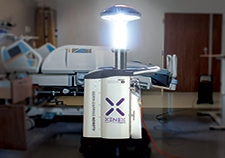 Photo courtesy of www.xenex.com (05/03/2018)
Pulsed xenon ultraviolet devices disinfect more effectively than manual cleaning, found a study by researchers at multiple VA centers. The devices use bulbs that contain xenon, a gas, to emit short bursts of high-energy ultraviolet light. Researchers tested surfaces in two hospital rooms cleaned using pulsed xenon ultraviolet and two cleaned with manual disinfection. Staphylococcus aureus counts were reduced by 75 percent in the UV rooms, compared with pre-cleaning counts. Aerobic bacteria colony counts were reduced by 84 percent in the UV rooms. Manual disinfection reduced bacteria counts only by 25 to 30 percent. The researchers recommend that this technology be integrated into daily hospital operations. (American Journal of Infection Control, April 11, 2018)
|
Caloric restriction changes liver metabolism, shows primate study
 ©iStock/Duka82 (05/03/2018)
Restricting calories may delay the onset of age-related disorders and extend the lifespan by changing how the liver metabolizes various molecules, according to a study led by a William S. Middleton Memorial Veterans Hospital researcher. Caloric restriction has been shown to ward off disease and extend life in many species. To look for a possible molecular explanation, the researchers put male rhesus monkeys on a diet that was 30 percent lighter in calories than a standard diet, for two years. They then took liver biopsies and conducted high-resolution molecular profiling of the tissue. The team found that caloric restriction changes gene expression relating to liver metabolism. Their report describes the changes in detail, with a focus on RNA processing. They say the work represents a “comprehensive, integrated account of the molecules and pathways recruited by [caloric restriction] that may underlie the longevity benefits.” (Cell Metabolism, March 6, 2018)
|
Researchers report technical breakthrough for brain-computer systems
 Adapted from JN article (05/03/2018)
A team that included researchers from the Providence VA Medical Center showed how “local field potentials”— the total electrical current flowing to a small section of nervous tissue in the brain—may be a more robust, stable signal for brain-computer systems than neuronal action potentials, which represent the activity of individual brain cells. The study involved one person with ALS and another with locked-in syndrome due to a stroke. In locked-in syndrome, the person is mentally engaged but unable to speak or move his or her limbs. The two participants were able to type messages and emails for 138 and 76 days, respectively, without needing re-calibration of their brain-computer systems. Past studies in which the decoding of brain signals was based on neuronal action potentials had required far more frequent re-calibration. The researchers say they have achieved a “new benchmark” for stability, using local field potentials. “This study is a step towards a reliable and robust [brain-computer interface] that will allow people with [locked-in syndrome] to communicate independently and, therefore, provide greater and more extensive interactions with their friends, family, and caregivers.” (Journal of Neurophysiology, April 25, 2018)
|
Up to nine months between doctor's visits do not worsen viral load for HIV patients
 Photo: ©iStock/NanoStockk (04/25/2018)
Gaps up to nine months between HIV primary care visits do not worsen viral load, found a study including a Michael E. DeBakey VA Medical Center researcher. Current guidelines say that HIV patients should visit their doctors every six months for viral monitoring. Looking at more than 6,000 patients with HIV, researchers found that patients who went up to nine months between doctor's visits did not have significant increases in viral load. Patients with visit gaps greater than 12 months were much more likely to have lost viral suppression. The results show that primary care visit intervals between six and nine months may be appropriate for HIV patients, say the researchers. (AIDS Patient Care and STDs, April 2018)
|
Probiotic reduces S. aureus infection odds in GI tract
 Photo: ©iStock/RomaRiolen (04/25/2018)
Probiotics can reduce Staphylococcus aureus infection in the gastrointestinal tract, according to a William S. Middleton VA Medical Center study. Patients with S. aureus infection were given either the probiotic Lactobacillus rhamnosus HN001 or a placebo for four weeks. Those taking the probiotic had 83 percent reduced odds of S. aureus presence in their GI tract after treatment, compared with the placebo group. However, those with S. aureus infection somewhere other than the GI tract only had 15 percent lower S. aureus colonization. The results show that oral L. rhamnosus could be a useful treatment for S. aureus infection in the GI tract. (BMC Infectious Disease, March 14, 2018)
|
Possible explanation for how melatonin promotes sleep
 Photo: ©iStock/jhorrocks (04/25/2018)
Researchers at the Harry S Truman Memorial VA Hospital have identified a possible mechanism that explains how melatonin promotes sleep. Melatonin, sold in supplement form, is widely prescribed nowadays as a sleep aid, but how exactly it works is unclear. Researchers studied how the brains of mice responded to melatonin. They found that orexin neurons in the brain expressed MT1, a melatonin receptor protein. When the researchers infused melatonin into the brain, the mice showed increased REM sleep and reduced wakefulness. Melatonin infusion inhibited orexin neurons. The results show that melatonin may act via the MT1 receptors to inhibit orexin neurons and promote sleep. The researchers point out that while the finding helps explain an existing treatment, it also may lead to new ones. (Journal of Pineal Research, April 14, 2018)
|
Certain psychotropic drugs increase risk of QT prolongation in PTSD patients
 Photo: ©iStock/evryka23 (04/25/2018)
Certain drugs used to treat PTSD could lead to dangerous heart conditions, found researchers from several VA systems. Several psychotropic drugs used to treat depression and sometimes given for PTSD have recently been linked to QT prolongation. QT prolongation is an abnormal heart rhythm that can cause fainting, seizures, and even sudden death. The researchers looked at administrative data of VA patients with PTSD. They found that patients on the antipsychotic drug ziprasidone (sold under the brand name Geodon, among others) and the anti-anxiety drug buspirone (sold as Buspar) had increased risk of QT prolongation, while those on the SSRI antidepressants citalopram (sold as Celexa and other brands) and fluoxetine (Prozac and other brands) did not. The researchers also found that patients with QT prolongation had a higher risk of death than those without. They recommend that prescribers and patients consider these risks when deciding on treatments for PTSD. (Annals of Pharmacotherapy, April 1, 2018)
|
Telemental health useful for women Veterans
 Photo for illustrative purposes only. ©iStock/RapidEye (04/19/2018)
Telemental health is seen as a good fit to address the needs of women Veterans, according to a survey by the VA Center for the Study of Healthcare Innovation, Implementation and Policy. Researchers interviewed 40 VA leadership and clinical employees. Respondents believed that telemental health could increase access to care, especially for rural women and those with other barriers to care. Telemedicine was seen as particularly useful for women with responsibilities related to child care, spousal care, and elder care. The findings could help guide gender-tailored expansion of telemedicine. (Women's Health Issues, March-April 2018)
|
Self-report survey data improves violence risk prediction in soldiers
 Photo for illustrative purposes only. ©iStock/Wavebreakmedia (04/19/2018)
Data from the Army STARRS New Soldier Survey can improve the accuracy of interpersonal violence risk prediction, found a study that included a VA Eastern Colorado Health Care System researcher. The survey was given to more than 21,000 Army recruits. When using both survey and administrative data, researchers were able to predict soldiers’ involvement in physical or sexual violence with greater accuracy than with administrative data alone. The greatest change was in predicting whether women soldiers would be victims of sexual violence. Overall accuracy increased to 29 percent, up from 18 percent with administrative data only. The researchers believe that the increased accuracy might offset the survey costs. (BMC Psychiatry, April 3, 2018)
|
Blood cancer patients with cognitive impairment may have worse survival
 Photo: ©iStock/Dr._Microbe (04/19/2018)
Cognitive impairment was linked to worse survival rates in patients with blood cancers, in a study that included VA Boston Healthcare System researchers. They looked at 341 elderly patients with leukemia, myeloma, or lymphoma. Of those, 127 had executive dysfunction and 62 had impaired working memory. Those with impaired working memory had lower median survival, regardless of treatment type. Executive dysfunction was linked with worse survival only for those undergoing intensive treatment. While age is the main cause of cognitive impairment, some cancer-fighting drugs may further impair cognition. Other cancer treatments, as well, may worsen existing health conditions. The results show that targeted interventions are needed for cancer patients with cognitive impairment, say the researchers. (JAMA Oncology, March 1, 2018)
|
Increased exercise may improve cognitive function shortly after breast cancer surgery
 Photo for illustrative purposes only. ©iStock/Steve Debenport (04/11/2018)
An exercise program improved cognitive functioning in patients diagnosed with breast cancer within the past two years, in a study including a VA San Diego Healthcare System researcher. Increased physical activity has been shown to improve cognition in both healthy and cognitively impaired adults. This study aimed to see how exercise specifically benefitted cancer survivors. Patients within two years post-surgery scored better on a test of processing speed after a 12-week exercise program, compared with those not in the exercise program. However, patients who had surgery more than two years previously did not show faster processing. The results suggest that early implementation of an exercise intervention could have benefits for breast cancer survivors, say the researchers. (Cancer, Jan. 1, 2018)
|
High BMI linked with early, but not later, survival after hospitalization
 Photo for illustrative purposes only. ©iStock/GlobalStock (04/11/2018)
Overweight or obese BMI is linked with improved survival after hospitalization, but only in the short term, found a study by VA Ann Arbor Healthcare System and NYU School of Medicine researchers. The study looked at survival rates for older patients hospitalized for congestive heart failure, pneumonia, and heart attack. Patients with overweight or obese BMI had lower mortality one year after hospitalization. However, after one year these patients did not have better survival rates than those with lower BMI. While previous studies have shown the link between higher BMI and lower risk of death after hospitalization in the short term, less data are available on the effects long-term. While obesity may be protective in the short term, this connection is a source of debate. Obesity may be protective against in-hospital mortality, but still hazardous for longer-term mortality, according to the researchers. (BMC Geriatrics, Feb. 6, 2018)
|
Accepting hepatitis C-positive liver transplants could improve life expectancy
 Photo: ©iStock/Natali_Mis (04/11/2018)
Patient without hepatitis C needing a liver transplant may have increased life expectancy if they are willing to accept a donated liver that is positive for the hepatitis C virus, according to a mathematical model. A team including a researcher from the Michael E. DeBakey VA Medical Center used data from published studies to create a simulated trial. They found that accepting any liver regardless of hepatitis C status resulted in increased life expectancy over waiting for a liver free of the hepatitis C virus. Although infected livers could have adverse outcomes, the virus can now be treated very effectively post-transplant using direct-acting antivirals. (Hepatology, Dec. 9, 2017)
|
Detecting coronary heart disease using genetic data
 Photo: ©iStock/wildpixel (04/04/2018)
A team including an Iowa City VA Healthcare System researcher used machine learning to detect coronary heart disease by combining genetic and epigenetic data. Epigenetics is the study of what causes genes to be expressed—basically, to get translated into proteins or other molecules that effect changes in the body. The program was able to classify heart disease with 78 percent accuracy, in a group of 142 patients. A comparison test using conventional heart disease risk factors—such as age, cholesterol level, and smoking status—was only 65 percent accurate. The results show that using computer algorithms with genetic data could lead to better ways to detect coronary heart disease, say the researchers. (PLoS One, Jan. 2, 2018)
|
‘Autonomy support’ linked to better diabetes control
 Photo: ©iStock/AndreyPopov (04/04/2018)
Autonomy support from family or friends may help people better control their diabetes by relieving diabetes distress, according to a study by the VA Center for Clinical Management Research. Autonomy support is social support that encourages patients to control their own care. Many people with diabetes experience emotional distress from diabetes symptoms, the stress of keeping up with care regimens, and fear of complications from the disease. Studying 308 Veterans with diabetes, researchers found that high diabetes distress was linked to poor glycemic control. Those with greater autonomy support had greater glycemic control than those without. (Diabetes Care, March 29, 2018)
|
Low systolic blood pressure linked to worse outcomes for heart failure patients
 Photo: ©iStock/PeopleImages (04/04/2018)
Low systolic blood pressure is linked to worse outcomes in patients with heart failure with preserved ejection fraction, found Washington DC VA Medical Center researchers. Heart failure with preserved ejection fraction involves increased stiffness of the heart's left ventricle and less relaxation of the ventricle when filling with blood before the next beat. Out of more than 1,800 patients hospitalized with this condition, 10 percent of patients with systolic blood pressure less than 120 mm Hg at discharge died within 30 days, compared with 5 percent of those with systolic blood pressure higher than 120 mm Hg. Those with lower blood pressure also had higher risk of death one year after hospitalization. The researchers conclude that future studies should look at optimal systolic blood pressure treatment goals for patients with this condition. (JAMA Cardiology, Feb. 14, 2018)
|
Site mentoring can improve clinical trial recruitment
 Photo: Christopher Pacheco (03/28/2018)
A site mentoring model improved recruitment for clinical trial participation, in a VA Cooperative Studies Program study. As part of the CONFIRM trial, which studies colorectal cancer, teams with expertise in managing multi-site clinical trials worked one-on-one with low-enrolling CONFIRM sites to identify and overcome barriers to recruitment. Sites being mentored had an average improvement of five participants per month. A majority of sites had improved participant recruitment and participant screening for eligibility three months after the mentoring. The success of this pilot program shows that a site mentoring model could help improve recruitment for future clinical trials, according to the researchers. (Contemporary Clinical Trials Communications, March 2018)
|
Outpatient medical care linked to lower drug use in rural patients
 Photo: ©iStock/JTSorrell (03/28/2018)
Use of outpatient medical care is linked to reductions in illicit drug use over time in rural areas, found a study by Central Arkansas VA Healthcare System researchers and their colleagues. The researchers looked at how outpatient medical care for other issues affected substance use in 710 stimulant users in rural areas of Arkansas, Kentucky, and Ohio. They found that patients with at least one outpatient medical care visit over a three-year period had lower alcohol, crack cocaine, and methamphetamine use over time, compared with patients who did not have any outpatient visits. The findings highlight the importance of medical care contact in addressing unhealthy substance use, say the researchers. (American Journal of Drug and Alcohol Abuse, 2018)
|
Gene variant, mild traumatic brain injury combination lead to greater risk of Alzheimer's
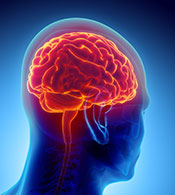 Photo: ©iStock/yodiyim (03/28/2018)
Mild traumatic brain injury may be connected to lower hippocampal volume in people with a gene variant linked to Alzheimer's disease risk, according to a VA Boston Healthcare System study. Lower volume of the hippocampus (a region of the brain) has been shown to be a sign of Alzheimer's disease. Previous research has shown that severe TBI can lead to hippocampus atrophy, but less evidence of this exists for mild TBI. The researchers looked at the genes of 165 Veterans with at least one mild TBI. They found that a combination of a specific gene variant previously linked to Alzheimer's and mild TBI was a good predictor of hippocampal volume. The results suggest that people with this gene variant are at greater risk for neurodegeneration after exposure to a mild TBI. (Genes, Brain, Behavior, Feb. 2018)
|
Apalutamide could delay metastasis of prostate cancer
 Photo: ©iStock/jamesbenet (03/21/2018)
Patients with prostate cancer taking the drug apalutamide went longer without the cancer metastasizing than those taking placebo, in an international study including a researcher from the VA Portland Health Care System. Patients taking daily apalutamide went a median of 40.5 months before the cancer metastasized (spread to bone or other organs). Those in the placebo group had a median of 16.2 months before metastasis. Three percent more patients in the apalutamide group than in the placebo group had adverse events, such rash, hypothyroidism, and fracture. Janssen Research and Development, the makers of apalutamide, funded the study and were involved in the research. (New England Journal of Medicine, Feb. 8, 2018)
|
Vets with mental health diagnoses have higher risk of respiratory problems
 Photo: USMC (03/21/2018)
Veterans of the wars in Afghanistan and Iraq with mental health diagnoses are more likely to have respiratory problems, found a VA Portland Health Care System study. Researchers looked at data for more than 180,000 Veterans. Fourteen percent had a respiratory condition such as bronchitis, asthma, or COPD. Of those, 77 percent also had a mental health condition diagnosis. Those with a mental health condition were more likely to have a respiratory condition, but the reverse was not true. While the results do not show causation between the two conditions, they show the importance of care coordination for Veterans with multiple conditions, according to the researchers. (Military Medicine, Feb. 6, 2018)
|
Study: Written exposure therapy as effective as cognitive processing therapy
 Photo for illustrative purposes only. ©iStock/Lyashik (03/21/2018)
Written exposure therapy had similar effects to cognitive processing therapy for treating PTSD, found a VA Boston Health Care System study. Cognitive processing therapy is considered the gold
standard for PTSD treatment. Written exposure therapy involves five weekly sessions, compared with 12 sessions in cognitive processing therapy. The researchers assigned 63 patients to written exposure therapy and 63 to cognitive processing therapy. Participants in written exposure therapy had similar improvements in PTSD symptoms as cognitive processing therapy participants after 36 weeks. The findings suggest that written exposure therapy could offer an efficient PTSD treatment for patients unlikely to complete longer-term therapy, say the researchers. (JAMA Psychiatry, March 1, 2018)
|
Cardiac rehabilitation participation lower than recommended
 Photo for illustrative purposes only. ©iStock/juanmonino (03/14/2018)
Cardiac rehabilitation participation after cardiovascular incidents (e.g., heart attack, bypass surgery) is low despite being recommended by guidelines, found a study by VA researchers and colleagues. Rehabilitation includes exercise training, risk factor modification, and psychosocial counseling. The researchers found that 16 percent of Medicare patients and only 10 percent of VA patients participated in cardiac rehabilitation after a cardiovascular event. However, they found wide regional variation in both Medicare and VA, ranging from 1 to 48 percent, depending on the state. The northern Midwest had the highest participation, while the Pacific region had the lowest. The researchers believe that best practices from hospitals with higher participation could improve the rates of rehabilitation at other hospitals. (Circulation, Jan. 5, 2018)
|
Neuropeptide Y may not be good biomarker for PTSD
 Photo by Cpl. Manuel Serrano/USMC (03/14/2018)
Neuropeptide Y levels were not found to indicate PTSD risk, in a Dutch and American study including a VA San Diego Healthcare System researcher. Neuropeptide Y is a neurotransmitter associated with the stress response. Previous research had suggested that high neuropeptide Y levels might protect against PTSD. The researchers looked at neuropeptide Y levels in 3,319 U.S. Marines and Dutch service members both before and after deployment. They did not find any connection between neuropeptide Y levels and level of PTSD symptoms at either time point. The results suggest that neuropeptide Y may not be a useful biomarker for PTSD risk, say the researchers. (Biological Psychology, Feb. 19, 2018)
|
Polytrauma inpatient rehabilitation effective long-term
 Photo courtesy of Tampa VAMC (03/14/2018)
Patients with traumatic brain injury treated at a VA polytrauma rehabilitation center continued to show improved function in the long term, found a VA Palo Alto Health Care System study. Researchers looked at 44 patients admitted to the inpatient rehabilitation unit in 2006. They found that functional gains made between admission and discharge were maintained eight years later. After eight years, more than 50 percent of patients were either competitively employed or continuing their education. All patients were living in a noninstitutionalized setting. The results show that the established Polytrauma System of Care is both effective and durable. (Archives of Physical Medicine and Rehabilitation, February 2018)
|
Evidence lacking on benefits of cranial electrical stimulation
 Image courtesy of study authors (03/08/2018)
A West Los Angeles VA Medical Center review found evidence is lacking on the benefits of cranial electrical stimulation for a number of conditions. In CES, doctors apply low-intensity electrical current to the head using electrodes. Evidence from 26 studies was insufficient to show that CES helped patients with fibromyalgia, headache, neuromusculoskeletal pain, degenerative joint pain, depression, or insomnia. Some studies suggested benefit for patients with anxiety and depression, but the evidence was low-strength. Low-strength evidence suggested that CES does not cause serious side effects. Larger randomized trials of higher quality, better execution, and longer follow-up are needed to show whether CES actually helps for these conditions, say the researchers. (Annals of Internal Medicine, Feb. 13, 2018)
|
Cognitive processing therapy and prolonged exposure therapy equally effective at treating PTSD
 ©iStock/Highwaystarz-Photography (03/08/2018)
Cognitive processing therapy and prolonged exposure therapy are equally effective at treating PTSD, found a study by researchers at the Dwight D. Eisenhower VA Medical Center in Leavenworth, Kansas. Researchers looked at medical charts for 750 Veterans with PTSD who underwent one of the two treatments. Patients who completed either therapy showed significantly lower PTSD symptoms, compared to those who did not complete therapy. There were no significant differences in symptom reduction between the two therapies. Both forms of psychotherapy are widely used in VA, and have been shown in many studies to improve PTSD symptoms. Cognitive processing therapy focuses on teaching patients how to evaluate and change upsetting thoughts related to trauma. Prolonged exposure therapy involves remembering and confronting trauma-related memories rather than avoiding them. This study adds to the existing evidence that either therapy is an effective treatment for PTSD. (Psychological Reports, April 2018)
|
Balanced high fat-diet reduces cardiovascular risk
 Photo:©iStock/Dusan Vidar (03/08/2018)
A balanced high-fat diet reduces cardiovascular risk in obese women, found a study by VA Tennessee Valley Healthcare System researchers and their colleagues. In a balanced high-fat diet, total saturated fat is reduced and total unsaturated fat is increased proportionally. The diet balances the type of fat consumed to one-third saturated, one-third monounsaturated, and one-third polyunsaturated. All the women in the study had lower cardiovascular risk factors after the diet, but European-American women and African-American women responded differently. European-American women saw lower scores in measures related to apolipoprotein B, the main protein involved in LDL cholesterol. African-American women sow reductions related to apolipoprotein A1, the main protein related to HDL cholesterol. The results show that ethnicity and genetics should be considered when planning diet therapy, according to the researchers. (Metabolism, Jan. 27, 2018)
|
Topical fluorouracil reduces risk of some skin cancer and lowers treatment costs
 Photo: ©Stock/artenex (03/08/2018)
Treatment with a fluorouracil cream can lower risk for one form of skin cancer and reduce treatment costs, according to two papers by VA researchers. Both papers were part of the VA Keratinocyte Carcinoma Chemoprevention Trial. Keratinocyte carcinoma refers to two types of non-melanoma skin cancer: cutaneous basal cell carcinoma and squamous cell carcinoma. Keratinocyte carcinoma accounts for about three-quarters of all cancers in the U.S. In the trial, 932 Veterans with a history of skin cancer applied topical fluorouracil—a medication used to treat cancer—to their face and ears twice daily for two to four weeks. The first paper reported that patients treated with fluorouracil had a 75 percent lower risk than those treated with placebo of developing squamous cell carcinoma in the year following treatment. Patients in the fluorouracil group were also significantly less likely to undergo Mohs surgery for either type of cancer. Fluorouracil did not reduce risk of basal cell carcinoma in the first year, or of risk of either cancer after four years. The second paper showed that patients in the fluorouracil group incurred $771 less in treatment costs over a three-year period, compared with the placebo group. Patients treated with fluorouracil had fewer appointments for squamous cell carcinoma. The results show that a topical treatment of fluorouracil substantially reduced surgery for squamous cell carcinoma and provided cost-savings for the VA health care system. (Journal of the American Academy of Dermatology, March 2, 2018)
|
Lab study suggests curcumin could improve memory, mood in Gulf War illness
 Photo:©iStock/onairjiw (02/27/2018)
Curcumin may lead to better cognitive and mood for those with Gulf War illness, according to a rat study by Olin E. Teague Veterans' Medical Center and Texas A&M researchers. Curcumin is a natural antioxidant compound found in turmeric and other plants, and is sometimes sold as an herbal supplement. Rats with simulated Gulf War illness symptoms were treated with either curcumin or a placebo for 30 days. Those in the curcumin group had better cognitive and mood function, based on behavioral tests. They also had better neurogenesis (growth and development of nerve tissue) and lower inflammation than the placebo group. The researchers hypothesize that changes in gene expression caused by curcumin could improve memory and mood symptoms related to Gulf War illness. (Brain, Behavior, and Immunity, Feb. 15, 2018)
|
One-day workshop shows promise for migraine sufferers
 Photo for illustrative purposes only. ©iStock/g-stockstudio (02/27/2018)
A one-day behavioral intervention workshop for Veterans with migraine improved symptoms and pain acceptance, found a Houston VA HSR&D Center for Innovation and Baylor College of Medicine study. Twenty-five Veterans with migraines along with depression or anxiety attended the workshop, which featured education and elements of acceptance and commitment therapy, a type of cognitive behavioral therapy. Participants said that that the workshop helped them better understand their condition and empowered them to better manage their headaches. The training led to greater awareness of how stress can make headaches worse. At a three-month follow-up, participants had significantly improved depressive and anxiety symptoms, general functioning, and headache-related disability. Findings of this small trial suggest that educational workshops could have important benefits for treating migraines, pending replication in a more rigorously designed large-scale study. (Military Medicine, Feb. 6, 2018)
>
|
Steroid drug may help PTSD symptoms
 Photo ©iStock/adventtr (02/27/2018)
The drug dexamethasone improved PTSD symptoms when paired with trauma memory activation, in a VA North Texas Health Care System study. Dexamethasone is a glucocorticoid—a type of steroid involved in glucose metabolism and the immune system. It is commonly used to treat a number of conditions, such as rheumatoid arthritis, allergies, and asthma, because of its anti-inflammatory properties. Fifty-four male Veterans with PTSD received either dexamethasone or placebo. The first group was given the drug while doing a trauma memory reactivation task in four weekly sessions. Those treated with the drug had significantly lower PTSD symptoms at one- and three-month follow-ups. They also had lower symptoms six months later, but the results were no longer significant relative to the placebo group. The drug is thought to facilitate the extinction of fear memories—meaning that the memory is replaced with new learning. Extinction is impaired in people with PTSD. The drug has an “excellent high-dose safety profile,” according to the researchers, although it could have side effects such as increased appetite, insomnia, heartburn, and muscle weakness, and increased blood sugar. One study participant was hospitalized because of leg swelling that possibly resulted from the drug. Further trials are needed to explore the drug’s potential role in PTSD treatment, say the researchers. (Psychiatry, Winter 2017)
|
Non-specialists do as well as specialists at treating sleep apnea
 Photo:©iStock/Nicolesy (02/22/2018)
Patients with obstructive sleep apnea receive similar quality of care from sleep specialist physicians and non-sleep specialists, found a Minneapolis VA Health Care System review. Four studies found that sleep specialist physicians and non-sleep specialists performed equally well at diagnosing obstructive sleep apnea and classifying its severity. Eight other studies showed that patients with both types of providers had similar quality of life, adherence to treatment, and symptom scores. Using dedicated sleep specialist physicians can be expensive and inefficient. The researchers believe that more research is needed on the best and most efficient care models for sleep apnea. (Annals of Internal Medicine, Feb. 6, 2018)
|
Review study finds antipsychotic drug a ‘reasonable treatment’ for PTSD
 Photo:©iStock/Hailshadow (02/22/2018)
A review study by a team at the Durham VA Health Care System concluded that aripiprazole is a reasonable treatment option for PTSD. Aripiprazole, sold as Abilify and other brands, is an atypical antipsychotic mainly used to treat schizophrenia and bipolar disorder. Current VA and Department of Defense guidelines recommend against this class of drugs for PTSD, although in the case of aripiprazole the evidence against its use is considered weak. Looking at six previous studies, the Durham researchers found that patients on aripiprozole showed significant improvements in PTSD symptoms. The drug was well-tolerated, although there were some adverse effects such as anxiety and insomnia. These side effects are themselves symptoms of PTSD, but most study participants experienced fewer symptoms overall. The researchers acknowledge that psychotherapy has been shown to be the best treatment for PTSD, but that since some patients either decline or are unable to participate in talk therapy, other approaches should be explored. Larger studies are needed to better understand how antipsychotics can be used to treat patients with PTSD, say the researchers. (Clinical Neuropharmacology, November/December 2017)
|
Rates of hospital admission after VA outpatient surgery
 Photo:©iStock/Rpsycho (02/22/2018)
As many as 20 percent of VA outpatient surgeries result in hospital admission, according to a VA Boston Healthcare System study. This admission rate is higher than in non-VA settings—which average around 1 to 5 percent—but may be explained by the greater disease burden and higher percentage of men seen in VA, say the researchers. They looked at data from 63,685 surgeries carried out between 2011 and 2013. They found that 66 percent of hospital admissions occurred on the day of surgery. Admission rates ranged from 5 percent in podiatry surgeries to 28 percent in urology. Four percent of admissions were for surgical complications. Regardless of type of surgery, higher procedure complexity and anesthesia risk led to more admissions. The admission rate may appear higher because of planned inpatient stays being miscoded as outpatient procedures that resulted in hospitalizations, noted the researchers. Also, VA providers may also be more likely than private doctors to hold patients for observation or choose to readmit them after a surgery because the patients would not incur an additional cost for this choice. The researchers conclude that most postoperative admissions are likely observational, and not because of problems related to the surgery. (Health Services Research, Jan. 23, 2018)
|
Natural language processing accurate at analyzing bladder cancer reports
 Photo: Wikimedia Commons (02/15/2018)
Natural language processing was successful at identifying details on patients with bladder cancer from medical reports. Researchers analyzed 600 reports on patients with bladder cancer from the VA's Corporate Data Warehouse using a computer engine that looks at language. They used this set of reports to develop and evaluate the computer program. Researchers then applied the natural language processing engine to more than 10,000 other reports. The program was able to accurately detect pathologic characteristics—such as tumor structure, depth, and grade—in 99 percent of patients. This technology could be used to group cancer patients together by similar characteristics for future studies. (Urology, December 2017)
|
Protein related to migraine may not be as important to blood pressure regulation as previously thought
 Photo: ©iStock/laflor (02/15/2018)
A central nervous system protein believed to prevent high blood pressure can possibly be blocked without negative cardiovascular effects, according to an Iowa City VA Medical Center and University of Iowa study. The protein, calcitonin gene-related peptide (CGRP), can cause migraines, but it has also been shown to protect against high blood pressure. Researchers treated mice with gene variations that resulted in increased CGRP receptors with drugs that increase blood pressure. The results suggest that the receptors themselves may provide cardiovascular protection even without directly interacting with CGRP. This could mean that migraine medications that block CGRP activity may not pose a risk of causing high blood pressure, as previously thought. (Journal of Cerebral Blood Flow and Metabolism, Jan. 1, 2018)
|
Insomnia drug may be overprescribed to Veterans
 Photo: ©iStock/OcusFocus (02/15/2018)
Prescription of zolpidem (sold as Ambien and other brands), an insomnia drug, is more widespread than guidelines recommend in Iraq and Afghanistan Veterans, found a study by researchers from several VA systems. Researchers looked at nearly 500,000 Veterans who received VA care in 2013 and 2014. Zolpidem was prescribed to 7.6 percent. The majority of these Veterans had long-term use of zolpidem, averaging 189.3 days. These numbers may reflect high-risk zolpidem prescribing practices that put Iraq and Afghanistan Veterans at risk for adverse effects and poor health outcomes, say the researchers. They believe the findings could serve as a guide to help improve prescribing of the drug. (PLoS ONE, Jan. 23, 2018)
|
Preterm birth more common in six months after deployment
 Photo: ©Stock/Ondroo (02/08/2018)
Women soldiers who gave birth within six months of returning from deployment were more likely to deliver early, according to a study including a VA Palo Alto Health Care System researcher. The rate of preterm birth was nearly double for women who delivered within six month of returning, compared with births at other times. Neither multiple past deployments nor PTSD was linked to preterm birth. The results show a need for increased focus on pregnancy timing for service women, as well as access to pre-deployment reproductive counseling and contraception, say the researchers. (American Journal of Epidemiology, Jan. 12, 2018)
|
Opioid prescription in VA has declined
 Photo: ©Stock/fluxfoto (02/08/2018)
Opioid prescribing has declined in VA in recent years, found an Iowa City VA Healthcare System study. Researchers looked at data on opioid use in VA between 2010 and 2016. Opioid prescriptions peaked in 2012 at 21.2 percent of all VA patients receiving at least one outpatient prescription. The rate then declined annually to 16.1 percent in 2016. The decline is mostly because of less long-term opioid prescribing, as opposed to short or intermediary opioid use. The results show that recent VA opioid initiatives may be succeeding in preventing patients from beginning long-term opioid use. (Journal of General Internal Medicine, Jan. 29, 2018)
iStock-172960226.jpg
|
Transition-related treatment curbs suicidal thoughts, depression in transgender Veterans
 Photo: ©Stock/portishead1 (02/08/2018)
Transgender people who had undergone transition-related medical interventions were less likely to have suicidal thoughts and symptoms of depression, in a study of transgender Veterans. People who had both hormone therapy and surgery on the chest and genitals had significantly lower levels of suicidal thoughts and depression, compared with those who had no medical intervention, hormone therapy only, or hormone therapy and surgery on either the chest or genitals but not both. Results suggest that combined medical treatment to affirm one's gender identity has a protective psychological effect, according to the researchers. VA currently provides certain transition services for transgender Veterans, such as counseling, evaluations, and hormone therapy, but does not provide nor pay for surgery. (Psychological Medicine, Jan. 14, 2018)
|
New scale measures moral injury
 Photo for illustrative purposes only. ©iStock/kieferpix (02/02/2018)
Researchers from multiple VA centers and their colleagues have developed a scale to measure moral injury in Veterans and service members with PTSD. Moral injury includes feelings of guilt, shame, moral concerns, religious struggles, loss of religious faith, loss of meaning or purpose, difficulty forgiving, loss of trust, and self-condemnation. Researchers tested the Moral Injury Symptom Scale-Military Version (MISS-M) with 427 Veterans and service members with PTSD symptoms. They found high correlation between scores on the 45-item MISS-M survey and PTSD symptoms. The MISS-M could be a useful tool to measure moral injury and identify those at risk for PTSD, say the researchers. (Journal of Religion and Health, February 2018)
|
Memory tests are accurate for diagnosing Alzheimer's
 Photo: ©iStock/marrio31 (02/02/2018)
Memory tests are able to differentiate between those with and without Alzheimer's disease, found a review by researchers from several VA systems. In the 47 studies included by the researchers, measures of immediate and delayed memory had high diagnostic accuracy for Alzheimer's. Memory tests had lower accuracy for diagnosing mild cognitive impairment, based on 38 studies. While memory tests and other psychological testing can be useful for diagnosing Alzheimer's and other cognitive deficits, they are not required in the current diagnosis criteria. The researchers suggest that these tests should be emphasized when diagnosing the conditions. (Neuropsychology Review, December 2017)
|
Heart procedures in VA versus community hospitals
 Photo ©iStock/KentWeakley (02/02/2018)
Performing coronary revascularization procedures at community care hospitals that partner with VA, rather than at VA hospitals, has benefits and downsides, according to a study in several VA health care systems. Coronary revascularization refers to procedures to treat artery narrowing or blockage near the heart. The procedures studied were percutaneous coronary intervention and coronary artery bypass graft. One in five elective coronary revascularizations for VA patients was performed at community care sites that were part of the VA Community Care Program. Patients who had percutaneous coronary interventions at community-based medical centers had shorter travel distances than their peers who had the procedure at VA hospitals. However, community care patients had higher mortality and higher costs to the health care system than VA hospital patients. Coronary artery bypass grafts performed at community care hospitals had shorter travel distance, similar mortality, and lower costs than those performed at VA hospitals. The results show that patients should be provided with information to help them pick the health care professionals best for them regardless of location, say the researchers. (JAMA Cardiology, Jan. 3, 2018)
|
Mouse model of PTSD sleep disturbances
 Photo ©iStock/D-Keine (02/02/2018)
Researchers at the Harry S. Truman Memorial Veterans Hospital have found a technique that may let them study sleep disruptions from PTSD by using mice. The researchers exposed mice to soiled cat litter. The smell caused predator odor trauma in the mice, which caused hyperarousal and memory effects related to fear. By studying electrical signals in the mouse brains, researchers concluded that the sleep disturbances caused by predator odor trauma mimic sleep disturbances in humans with PTSD. The results could allow scientists to study PTSD-related sleep disturbances without using human study volunteers. (Sleep, Jan. 13, 2018)
|
'Nanoshuttle' capable of delivering drugs to specific tissue
 Image from Bone Research via Creative Commons (01/25/2018)
A team including a VA San Diego Healthcare System researcher designed "nanoshuttles" capable of delivering cancer drug molecules to specific cells and tissue. The nanoshuttles are tiny silica structures shaped like golf balls and containing gold and iron oxide nanoparticles. Researchers were able to guide these nanoshuttles through simulated blood vessels and human tissue by using an exterior magnetic field. The nanoshuttle is coated with a polymer sensitive to heat and pH, allowing the researchers to control when the payload, a cancer drug, is released. This technique holds great potential to deliver drugs to specific tissue types, say the researchers. (Bone Research, Dec. 20, 2017)
|
Evidence lacking on ways to prevent late-life cognitive decline
 Photo: ©iStock/PeopleImages (01/25/2018)
No proven methods exist to prevent cognitive decline in late life, according to a series of four reviews by Minneapolis VA Health Care System researchers.
A review of studies on multiple over-the-counter supplements did not find evidence that supplements protect against cognitive impairment or dementia. Daily folic acid plus vitamin B12 was linked to memory improvements, but the clinical significance was questionable. Evidence showed that vitamin E had no benefit on cognition. Existing evidence on a variety of other supplements is either low strength or insufficient.
Another review did not find much evidence that short-term physical activity prevented cognitive decline or dementia in older adults. Not enough evidence exists on the effectiveness of aerobics, resistance training, or tai chi. Low-strength evidence did suggest that physical activity, diet, and cognitive training together improved cognitive performance.
A third review did not find evidence to support the use of prescription drugs to protect against cognitive decline. NSAIDs, statins, high blood pressure medications, and cholinesterase inhibitors did not reduce dementia risk or slow cognitive decline. Evidence suggests that estrogen and estrogen-progestin increased the risk of dementia or cognitive impairment. High-dose raloxifene, an osteoporosis drug, decreased mild cognitive impairment but not dementia risk, but the strength of the evidence was low.
The final review did not find sufficient evidence that cognitive training could prevent dementia. Training in a specific area improved performance in that area only—for example, memory training improved memory, but not overall cognition. While cognitive training shows some benefit, not enough evidence exists to say whether these benefits actually prevent or delay cognitive decline or dementia. (Annals of Internal Medicine, Jan. 2, 2018)
|
General satisfaction with VA health care high, but some areas need improvement
 Photo by Mitch Mirkin (01/25/2018)
A diverse, multisite survey found generally high levels of satisfaction with VA health care. Researchers interviewed 1,222 Veterans at multiple VA locations between 2013 and 2015. They found that overall satisfaction with VA care was comparable or better than in other health care systems. No clear patterns in satisfaction were evident based on race or gender. Between 74 and 76 percent of participants said they were "very satisfied" with VA costs, outpatient facilities, and pharmacy services. Satisfaction was lowest with access to care, pain management, and mental health care, with 21 to 24 percent responding they were "less than satisfied." While satisfaction levels with VA health care were generally high, there is room for improvement, conclude the researchers. Since the time of the interviews, VA has made efforts to improve access to care, meaning that the results may not reflect current levels of satisfaction. (Journal of General Internal Medicine, Jan. 8, 2018)
|
VA system barriers could lead to lack of engagement with psychotherapy
 Photo for illustrative purposes only. ©iStock/Vadimguzhva (01/18/2018)
In a study based at one South Central VA Health Care Network clinic, system-level barriers were the most common reason cited by patients who had chosen to not engage with PTSD psychotherapy. Researchers interviewed 24 patients who had been prescribed either cognitive processing or prolonged exposure therapy for PTSD but who did not attend any sessions. Two-thirds of those interviewed mentioned barriers related to the VA system. These included inefficiencies and delays, negative experiences with VA staff and providers, discomfort with the VA environment, and difficulty navigating the VA system. Most Veterans interviewed said they had multiple barriers to treatment engagement. The researchers point out that the study may not provide a full picture of VA consumer satisfaction, since it included only Veterans who had opted out of therapy. But they say the results nonetheless underscore the need for a more patient-centered model of care. (Psychological Services, Dec. 21, 2017)
|
VA and Medicare Part D dual users more likely to take high opioid doses
 Photo: ©iStock/Darwin Brandis (01/18/2018)
Veterans using both VA and Medicare Part D for prescriptions were at a two to three times higher risk of high-dose opioid exposure than those only using one system, according to a study by VA Pittsburgh Healthcare System researchers and their colleagues. They found that 13 percent of patients who filled at least one opioid prescription in 2012 received care from both VA and Medicare Part D. Dual-use patients were more likely to receive high opioid doses and to have long-term high dose use. The researchers acknowledge that the data, which were the latest available at the time of the study, may not reflect the current state of opioid use across VA and Medicare. At the same time, they say that as VA adopts more community care options, the findings may take on even greater relevance. (American Journal of Public Health, February 2018)
|
Chiropractic care improves low back pain for some female Veterans
 Photo: ©iStock/CheshireCat (01/18/2018)
Chiropractic care improved outcomes for some female Veterans with low back pain, in a VA Western New York Healthcare System study. After an average of eight chiropractic treatments, women saw an average of 27 percent improvement in pain, based on a back pain questionnaire. About 47 percent of patients met the minimum clinically important difference to show the treatment is effective. While not all women studied saw statistically important improvements, the researchers concluded that chiropractic care may be of value for pain management in this population. (Journal of Manipulative and Physiological Therapeutics, October 2017)
|
Psychological risk factor difference in returning Veterans based on gender
 Photo by Master Sgt. Mark C. Olsen (01/10/2018)
Researchers with the Edith Nourse Rogers Memorial Veterans Hospital and their colleagues examined the different challenges for men and women Veterans returning from deployment. They looked at 283 post-9/11 returning combat Veterans to see how psychological risk factors differed based on gender. Results showed that female Veterans were more likely to report a history of sexual trauma. Male Veterans had a greater frequency of gambling, impulsivity, and hypersexuality. Both men and women had similar rates of depression, anxiety, insomnia, and substance use disorder. Veterans had higher rates of these conditions than non-Veterans, regardless of gender. Further research should focus on how these differences impact reintegration and functioning, say the researchers. (Journal of Interpersonal Violence, Dec. 12, 2017)
|
Report: People with PTSD have a smaller hippocampus
 Photo: ©iStock/yodiyim (01/10/2018)
People with PTSD have smaller hippocampi than those without, according to a large international consortium including several VA researchers. The study looked at 1,868 subjects who had been exposed to trauma, 794 of whom had active PTSD. Those with PTSD had significantly lower hippocampus volume than those without. The hippocampus is a section of the brain associated with emotions and long-term memory. Subjects with PTSD also had smaller amygdalae, but that finding was not deemed significant after statistical analysis. The results add support to previous findings that trauma exposure may cause volume loss in the hippocampus. The researchers describe the results as an important milestone in understanding the brain's response to trauma. (Biological Psychiatry, Feb. 1, 2018)
|
Telephone versus televideo for genetic counseling
 Photo: ©iStock/shironosov (01/10/2018)
Both telephone and televideo delivery of genetic counseling have strengths and weaknesses, found a study by researchers from three VA medical centers. Researchers surveyed 20 patients receiving genetic counseling by phone and 18 receiving it by televideo, along with their counselors. Patients and counselors were satisfied with both methods. Televideo required more travel time and expense than telephone because it must be conducted at a clinic. Patients liked the flexibility of telephone. However, counselors felt that patients missed more appointments and were distracted when using the telephone. Televideo also had the advantage of letting counselors read the body language of patients. The results show that further analysis of telehealth methods is needed to balance access to care with patient engagement, according to the researchers. (Journal of Genetic Counseling, Dec. 15, 2017)
|
No-touch disinfection effective in preventing some hospital infections, but not others
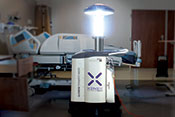 Photo courtesy of xenex.com (01/04/2018)
No-touch disinfection methods are effective at preventing some common infections but not others, found a literature review by a team including an Iowa City VA Health Care System researcher. The researchers looked at studies on ultraviolet light or hydrogen peroxide vapor cleaning systems. They found that these techniques significantly reduced C. difficile and vancomycin-resistant enterococci infection, two antibiotic-resistant pathogens common in hospitals. They did not find differences in the infection rates for MRSA or other drug-resistant organisms for no-touch techniques versus manual cleaning alone. The authors believe that no-touch cleaning methods can augment traditional cleaning, but not replace it. (Infection Control & Hospital Epidemiology, Nov. 16, 2017)
|
COPD tied to cognitive impairment, although causation not clear
 Photo: ©iStock/ands456 (01/04/2018)
Patients with chronic obstructive pulmonary disease have a high prevalence of cognitive impairment, according to a review by Central Arkansas Veterans Healthcare System and University of Arkansas researchers. Looking at the available literature, the researchers found that older patients with COPD were more likely to have mild cognitive impairment and dementia than those without COPD. Newer studies have reported that oxygen therapy and pulmonary rehabilitation can have positive effects on cognitive impairment. There is some evidence that the severity of low oxygen levels is linked to the severity of cognitive dysfunction. However, the researchers caution that causality between the two cannot be drawn from the available data. (Current Opinion in Pulmonary Medicine, Dec. 9, 2017)
|
Effect of testosterone on cardiovascular risk remain unclear
 Photo for illustrative purposes only. ©iStock/Halfpoint (01/04/2018)
Results were mixed on whether treatment for low testosterone in older men improves cardiovascular risk factors, in a study that included several VA researchers. The researchers looked at how testosterone treatment affects cardiovascular risk factors in 788 men age 65 or older. The study was part of a larger series of trials looking at how testosterone therapy affects a number of health outcomes. Testosterone was linked to small reductions in cholesterol and fasting insulin. But testosterone therapy did not affect other cardiovascular risk factors, such as glucose markers, inflammation, or clotting. More large studies are needed to figure out what effect testosterone has on cardiovascular risk, say the researchers. (Journal of Clinical Endocrinology and Metabolism, Dec. 14, 2017)
|
Military-related trauma linked to eating disorders in male Veterans
 Photo for illustrative purposes only. ©iStock/domoyega (12/27/2017)
Military-related trauma was linked to eating disorder symptom severity in male Veterans, in a study by VA Boston Healthcare System researchers. Of a group of 642 male Veterans, 4 percent showed a probable eating disorder. Up to 3 percent of men in the general population have an eating disorder. The most common symptom in the study group was binge eating, which is also the most common for men in the general population. Symptoms were more common for those who had experienced military-related trauma, with multiple traumas linked to increased eating disorder symptoms. Military-related trauma was defined in the study as “seeing something horrible or being badly scared” during military service. Interestingly, only non-combat military trauma was linked to eating disorders. Similar results have been seen in female Veterans, but eating disorders are understudied in men. Previous studies have shown as much as 14 percent of women Veterans may have eating disorder symptoms. Non-military trauma, such as childhood trauma, was not shown to be linked to eating disorders in the study group. The researchers say better assessment of eating disorders in male Veterans is needed. (International Journal of Eating Disorders, November 2017)
|
Antibiotic timing off for many dental procedures
 Photo: ©iStock/domoyega (12/27/2017)
While most patients in a small one-site VA study received antibiotics when having a dental procedure, most did not receive them at the right time. Guidelines now recommend that a single course of antibiotics be given before tooth extractions, dental implants, and periodontal procedures. Of 183 Veterans having a dental procedure, 83 percent received antibiotics. Of those, 92 percent received antibiotics only after the procedure. Only 3 percent received antibiotics before the procedure, with 5 percent receiving antibiotics both before and after. The researchers conclude that more efforts are needed to ensure proper timing of antibiotic treatment in dental practices. (Open Forum Infectious Diseases, Nov. 15, 2017)
|
Medical marijuana and opioid misuse may be linked
 Photo: ©iStock/LPETTET (12/27/2017)
Medical marijuana use may be linked to risk of prescription opioid misuse, according to a study by VA Portland Health Care System and Kaiser Permanente researchers. They studied 371 patients on long-term opioid therapy. Eighteen percent of those patients also used medical marijuana for pain. Those who used medical marijuana were significantly more likely to be at risk for prescription opioid misuse. The study showed no significant differences between those who used marijuana and those who did not in terms of pain relief, depression, or anxiety. The results highlight the need for more research on the long-term impact of medical marijuana, according to the researchers. (General Hospital Psychiatry, Nov. 8, 2017)
|
New cholesterol drug not cost-effective
 Photo: ©iStock/jamesbenet (12/14/2017)
Adding a PCSK9 inhibitor to statin therapy for high cholesterol is not cost-effective, found a study including a Michael E. DeBakey VA Medical Center researcher. PCSK9 inhibitors have been available since 2015, but are not widely used because of the cost and the newness of the drug class. Using a statistical model for a theoretical group of patients, based on the existing medical literature, the researchers determined that adding a PCSK9 inhibitor drug to a statin would typically reduce LDL cholesterol by 59 percent, and adverse cardiovascular events (such as stroke and heart attack) by 15 percent per year. However, the drug is very expensive: $14,300 per year. This price equates to a cost of almost $500,000 per quality-adjusted life year, an economic measure of disease burden that takes quality of life into account. The normal cost the market is willing to pay per quality-adjusted life year is $100,000. The price of PCSK9 would need to be lowered by 62 to 83 percent to become cost-effective, according to the researchers. (JAMA Cardiology, Oct. 18, 2017)
|
Protein shown to suppress breast cancer growth in mice
 Photo: ©iStock/dra_schwartz (12/14/2017)
A protein known as GPER1 suppressed the growth of breast cancer cells in a U.S. and Chinese study that included an Omaha VA Medical Center researcher. Prolonged exposure to estrogen is a risk factor in the progression of breast cancer. GPER1 has been shown to control how estrogen affects certain genes. The researchers looked at how the protein reacted in both human cells and mouse models. They found that GPER1 proteins bind to certain gene sites, disrupting cancer cell division and growth. Injection of GPER1 into mice did not harm their biology or behavior. The results suggest this protein could be a promising chemotherapy drug to treat breast cancer. (Molecular Cancer Therapeutics, June 2017)
|
Mandibular advancement device offers viable alternative to CPAP
 Photo: ©iStock/cherrybeans (12/14/2017)
Mandibular advancement devices (MAD) may be a good alternative to CPAP for treating obstructive sleep apnea in Veterans with PTSD, according to a VA Western New York Healthcare System study. A MAD is a mouth guard that holds the lower jaw and tongue forward, creating more breathing space during sleeping. Continuous positive airway pressure (CPAP) therapy involves a machine and breathing mask that creates pressure to keep the airway open. Researchers tested 35 subjects with both treatments. Results showed that CPAP provided better breathing results during sleep. However, both treatments improved sleep apnea and PTSD symptoms over no treatment. While CPAP is more effective than MADs, patients are much more likely to use a MAD consistently than they are CPAP, especially patients with PTSD. Patients used the MAD an average of 2.2 hours longer per night than CPAP. Fifty-eight percent of participants preferred the MAD to CPAP, while only 29 percent preferred CPAP. (Journal of Clinical Sleep Medicine, Nov. 15, 2017)
|
VA responsive to FDA drug warning on antidepressant, but less so for older patients
 Photo: ©iStock/Cecile_Arcurs (12/08/2017)
VA prescription of high doses of a common antidepressant decreased after FDA safety warnings, but not for all patient groups, found a VA Ann Arbor Healthcare System study. The FDA issued warnings against high doses of the antidepressant citalopram (sold as Celexa) in 2011 and 2012. Within the VA health system, high-dose citalopram use decreased by 2 percent per month between the first warning in 2011 and second in 2012. Less than 3 percent of citalopram users were on a high dose after both warnings. However, about 31 percent of older patients remained on doses higher than the new recommendation. Lower citalopram use was accompanied by significant increases in prescription of alternative antidepressants. While the results suggest that notification systems used in VA enable a quick response to medication warnings, more research is needed on how facilities receive and respond to these warnings, say the researchers. (American Journal of Geriatric Psychiatry, September 2017)
|
Telehealth management program may lower burden for dementia caregivers
 Photo: ©iStock/Thomas_EyeDesign (12/08/2017)
A telephone-based dementia care management program led to reduced burden on caregivers, found a study involving several VA centers. Home caregivers of patients with dementia participated in a telehealth education program. Participants engaged in two to three contacts per month for three months. They completed modules on dementia-related behavior management strategies and caregiver coping techniques. Participants in the telephone learning program showed lower burden, compared with those who received standard clinical care. The telehealth group also showed lower frequency of dementia-related behaviors and caregiver distress in response to these symptoms. The results suggest that a care management program delivered by telephone can improve outcomes for both patients with dementia and their caregivers. (American Journal of Geriatric Psychiatry, September 2017)
|
Variations in performance on cognitive tests may foretell Alzheimer's
 Photo: ©iStock/solidcolours (12/08/2017)
Cognitive tests may be effective in predicting Alzheimer's disease, found a study including William S. Middleton Memorial Veterans Hospital researchers. The researchers looked at biomarker and cognitive test data gathered over six years from 349 patients. They found that performance on cognitive tests lined up with biomarkers from lumbar punctures in predicting the advance of Alzheimer's disease and mild cognitive impairment. Specifically, the participants at risk were those who performed unevenly across tests in different cognitive areas, such as executive functioning, attention, verbal learning, memory, and reading. Such tests may pose an alternative to invasive medical procedures for prediction or early detection of the disease, according to the researchers. (Journal of Alzheimer's Disease, 2018)
|
New tool to predict mortality of dialysis patients
 Photo: ©iStock/porpeller (12/08/2017)
VA and Kaiser Permanente researchers have developed a new risk prediction tool for patients transitioning to dialysis. The researchers looked at demographics, renal disease causes, other conditions, and lab data for more than 35,000 Veterans who transitioned to dialysis over a 6.5-year period. Twenty-seven percent died within a year of beginning dialysis. Researchers predicted about that number of deaths based on the data. They validated the prediction tool by looking at more than 4,000 patients outside VA. This new tool could help identify high-risk patients and aid in dialysis planning, say the researchers. (American Society of Nephrology Kidney Week, Nov. 3, 2017)
|
Study links genes to suicide-attempt risk
 Photo: ©iStock/nicolas (11/30/2017)
A team including several VA researchers has identified a gene variation that may be linked to risk of suicide attempts. The researchers studied the mapped genomes of a large group of soldiers to look for similarities in those who had attempted suicide. They found similar variation in two genes in one genome location. The genes (CEP162 and MRAP2) are involved in how the body uses the energy it gets from food. The results suggest that this gene variation may increase the risk of suicide, according to the researchers. The results may also show a genetic link between risk of suicide and bipolar disorder, they say. (American Journal of Medical Genetics, December 2017)
|
Genetic markers of schizophrenia predict lithium nonresponse in bipolar disorder
 Photo: ©iStock/Morrhigan (11/30/2017)
Patients with bipolar disorder who also have a high genetic risk for schizophrenia do not respond as well to lithium treatment as those without schizophrenia markers, found a large, international consortium including several VA researchers. Lithium is the standard mood stabilizer used to treat bipolar disorder. However, up to 30 percent of patients do not respond to lithium. The researchers looked at the genomes of more than 2,000 patients with bipolar disorder. They found that patients who had gene variations that have previously been shown to predict schizophrenia also did not respond to lithium for bipolar disorder. The results could be used to predict how effective lithium treatment will be for individual patients, say the researchers. (JAMA Psychiatry, Nov. 9, 2017)
|
Program will match cancer patients with clinical trials
 Photo: ©iStock/RoBeDeRo (11/30/2017)
Researchers with the VA Boston Healthcare System have created an online system to match cancer patients with clinical trials. The researchers partnered with a team at the University of California, San Francisco to adapt their CTMatch application to VA patients with non-small cell lung cancer. The system is part of the Precision Oncology Program, a VA program that offers genomic analysis of patients with tumors. The researchers hope that the system will lead to better treatments for patients by matching them with the most relevant clinical trials. (American Medical Informatics Association Annual Symposium, Nov. 7, 2017)
|
Trend toward earlier hospice enrollment in VA
 Photo: ©iStock/Martin Prescott (11/21/2017)
Early hospice enrollment increased over time in the VA health care system for patients with advanced-stage lung cancer, found VA Portland Health Care System researchers and their colleagues. Early enrollment in hospice can improve quality of care and caregiver well-being, according to the researchers. They looked at data from nearly 22,000 patients diagnosed with lung cancer between 2007 and 2013. Seventy percent of patients were enrolled in hospice. Of those, 53 percent were enrolled in the last month of life, while 15 percent were enrolled in the last three days. Over the time period studied, hospice enrollment increased. Time between diagnosis and hospice enrollment decreased. This trend toward timely hospice enrollment is encouraging, say the researchers. They also note that regional variability in hospice enrollment suggests room for improvement. (Cancer, Oct. 10, 2017)
|
RNA markers altered in rheumatoid arthritis
 Photo: ©iStock/selvanegra (11/21/2017)
Small RNA segments are altered in people with rheumatoid arthritis, found a VA Tennessee Valley Healthcare System study. Small, noncoding RNA segments within human genes regulate biological processes. Researchers looked at the RNA variations in blood plasma of people with rheumatoid arthritis. They found significant alteration in 12 RNA sequences, compared with subjects without arthritis. The results could be used to help diagnose rheumatoid arthritis, say the researchers. (American College of Rheumatology Annual Meeting, Nov. 6, 2017)
|
For back pain, telehealth cognitive behavioral therapy matches in-person treatment
 Photo: ©iStock/fstop123 (11/21/2017)
Cognitive behavioral therapy for low back pain delivered by phone had similar results to in-person treatment, in a study by VA San Diego Healthcare System researchers. Patients with chronic low back pain participated in eight weeks of either cognitive behavioral therapy over the phone or in-person supportive care. Both groups showed similar levels of pain improvement. Both also had strong participation. The results show that telehealth approaches to psychotherapy could be useful in treating pain. (Clinical Journal of Pain, Sept. 1, 2017)
|
Exploring the risks of sexual assault for deployed versus non-deployed servicewomen
 Photo by Sgt. Richard Blumenstein/USMC (11/21/2017)
Researchers from the Iowa City VA Health Care System and their colleagues looked at the rates of sexual assault against servicewomen who were deployed, versus those who were not deployed. Of more than 1,000 women surveyed who served during the wars in Iraq and Afghanistan, 16 percent had experienced sexual assault in the military. More servicewomen experienced sexual assault while not deployed. However, after adjusting for time spent in each setting, the researchers found that women were at greater risk of sexual assault during deployment. The results suggest that both locations require unique strategies to reduce sexual assault, say the researchers. (American Journal of Industrial Medicine, November 2017)
|
Computer algorithms accurately identify fatty liver disease
 Photo: ©iStock/choja (11/16/2017)
Researchers at the Michael E. Debakey VA Medical Center and their colleagues have developed computer algorithms that can accurately identify fatty liver disease from radiology reports. The algorithms use natural language processing to "read" text reports from radiology tests. They were able to identify patients with fatty liver disease more than 90 percent of the time. The algorithms could be used to rapidly screen patient records to gather data for studies on the disease, say the researchers. (Digestive Diseases and Sciences, October 2017)
|
Electronic trigger detects mammogram follow-up delays
 Photo: ©iStock/thomasandreas (11/16/2017)
An electronic trigger was effective at detecting delayed follow-up after an abnormal mammogram result, found Michael E. DeBakey VA Medical Center researchers. The researchers used a computer algorithm to search electronic health records for abnormal mammogram results with no noted follow-up. Looking at more than 2,000 records, the algorithm had 71 percent accuracy for detecting follow-up delays. The results suggest that electronic triggers could help track and reduce missed opportunities to act early for treatment, according to the researchers. The results also show that delayed follow-ups continue to be a problem for some despite federal laws requiring patient notification of mammogram results within 30 days, they say. (Journal of the American College of Radiology, Nov. 1, 2017)
|
Window of Hope therapy is effective at reducing hopelessness in people with TBI
 Photo for illustrative purposes only. ©iStock/KatarzynaBialasiewicz (11/16/2017)
The Window of Hope therapy program significantly reduced feelings of hopelessness in participants with traumatic brain injury, found a VA Rocky Mountain MIRECC study. Window of Hope is a cognitive behavioral therapy adapted for TBI. Hopelessness often occurs in people with TBI, sometimes leading to suicide. Those who participated in 10 weekly sessions scored significantly lower on a measure of hopelessness than those who did not. They continued to feel less hopeless three months after the therapy. The results show that the Window of Hope program is an effective way to treat hopelessness in this population, say the researchers. (Journal of Head Trauma Rehabilitation, Oct. 27, 2017)
|
Common fluids no better than saline for preventing kidney injury during angiograms
 Photo: ©iStock/kalus (11/16/2017)
Commonly used angiogram fluids are no better than saline at preventing kidney injury from the procedure, found a large international study funded by the VA Cooperative Studies Program and the National Health and Medical Research Council of Australia. Angiograms use a contrast solution containing iodine to illuminate blood vessels and organs for imaging. Intravenous sodium bicarbonate and oral N-acetylcysteine are commonly given during angiogram along with the contrast solution because they were thought to reduce the risk of kidney damage from the contrast. But the study of nearly 5,000 patients showed that these treatments were no better than a simple salt solution at preventing kidney injury. "The findings have implications every time someone with kidney disease in any hospital in the U.S. or worldwide undergoes angiograms," explains Dr. Steven Weisbord of the VA Pittsburgh Healthcare System, lead author on the paper. The results show that "saline solution alone should be the standard of care for the procedure," says Weisbord. (New England Journal of Medicine, Nov. 12, 2017)
|
Self-monitoring can lower blood pressure when used with other treatments
 Photo: ©iStock/mixetto (11/09/2017)
Self-monitoring leads to lower blood pressure when combined with other treatments, found a large international review including several VA researchers. The researchers analyzed 36 relevant articles on high blood pressure. They found that having patients monitor their own blood pressure on a regular basis at home resulted in reductions in pressure when combined with treatments such as medication, education, and lifestyle counseling. Self-monitoring by itself, however, did not lower blood pressure. The American Heart Association recommends self-monitoring at home for all those with high blood pressure, as the regular and frequent readings help providers track whether treatments are working. Based on the new study results, the researchers recommend including self-monitoring with other methods to treat high blood pressure. (PLoS Medicine, Sept. 19, 2017)
|
Blister packaging improves medication adherence
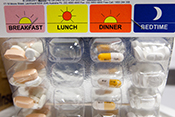 Photo by Scott R. Galvin (11/09/2017)
Psychiatric patients are more likely to take their medications correctly when it is given in blister packaging, found a study by the Rocky Mountain Mental Illness Research, Education and Clinical Center at the Denver VA Medical Center. Blister packaging consists of individual doses of pills in plastic bubbles with a foil backing, similar to how cold medication is often packaged. Study participants who received blister packaging were 59 percent more likely to follow their medication instructions than those who received medication in standard pill bottles. The results suggest that using this kind of packaging could improve treatment outcomes for psychiatric patients, say the researchers. (Journal of Psychiatric Practice, September 2017)
|
Patients often overestimate activity level
 Photo: ©iStock/sdominick (11/09/2017)
Patients and their surrogates often largely overestimate activity level, according to a collaboration between VA and Australian researchers. The researchers asked patients admitted to the ICU or their surrogates to estimate how many steps they took each day prior to hospitalization. The researchers then used smartphone GPS and pedometer data to get objective numbers. Patients and surrogates overestimated the numbers of steps per day by more than 3,000. The results suggest that clinicians should be cautious when using subjective estimates of activity level, especially if they are using that information to plan treatment, say the researchers. (Critical Care Medicine, October 2017)
|
Transgender health care in VA and the military
 Photo courtesy of Bedford VAMC (11/02/2017)
Researchers from several VA health care systems reviewed the literature on the care received by transgender people in VA and the U.S. military. They found that more than 5,000 transgender Veterans receive care in VA. Little data exists on care of transgender active-duty service members, mostly because transgender individuals were not permitted to serve openly until June 2016. Transgender Veterans experience higher rates of both mental and physical health conditions than non-transgender Veterans, according to the review. VA and military facilities have increased access to health care for transgender Veterans and service members in recent years. However, the researchers caution that more studies about improving health outcomes for this group are needed. (Current Sexual Health Reports, September 2017)
[use image from Currents story on 9-6-17: Study: Majority of transgender Veterans satisfied with VA care]
|
Small, dense cholesterol particles linked to lower death risk
 Photo: ©iStock/designer491 (11/02/2017)
Patients with a pattern of small, dense LDL cholesterol particles had a lower risk of death after a heart attack than those with large, buoyant particles, found a study including a researcher from the Michael E. DeBakey VA Medical Center. Doctors have long known that higher LDL cholesterol levels can put people at risk for cardiovascular problems such as heart attack. In the new study, researchers found a 32 percent lower risk of death after a heart attack for patients with small, dense LDL particles in their blood stream, compared with patients with larger, buoyant particles. Despite the interesting findings, the researchers caution that more research is needed to figure out what causes this association. In the meantime, treatment after heart attack should continue to focus on lowering overall LDL cholesterol levels, they say. (Journal of Clinical Lipidology, Oct. 3, 2017)
|
Public attitudes on homelessness more compassionate than in the past
 Photo for illustrative purposes only. ©iStock/Photawa (11/02/2017)
Public attitudes and perceptions about homelessness have changed in recent years, according to a recent VA study. Researchers surveyed 541 adults in November 2016 and compared the results to surveys conducted in 1990. The more recent survey showed more compassion and liberal attitudes about homelessness than the older surveys. The largest changes were related to increased support for homeless individuals using public spaces for sleeping and panhandling. Survey participants overestimated the proportion of homeless people who are young and minorities. They underestimated the proportion who have mental or substance use problems. The increase public support for homeless individuals shown here presents new opportunities to address homelessness through legislation and public health initiatives, say the researchers. (American Journal of Community Psychology, Oct. 13, 2017)
|
Antibiotic group shown to be effective against drug-resistant bacteria
 Photo: ©iStock/adventtr (10/26/2017)
A VA St. Louis Health Care System team showed that a new group of antibiotics are effective against drug-resistant bacteria. The researchers tested 254 related antibiotic compounds, known as the nucleotidyltransferase superfamily, against a variety of common bacteria. They found multiple compounds to be effective at preventing the growth of drug-resistant bacteria, such as E. coli and Staphylococcus. The results show that this antibiotic group stops bacteria growth in a different way than existing antibiotics, according to the researchers. (ASM/ESCMID Conference on Drug Development to Meet the Challenge of Antimicrobial Resistance, Sept. 6, 2017)
|
Longevity gap for people with schizophrenia
 Photo: ©iStock/Mark_Hubsky (10/26/2017)
Mortality rates for people with schizophrenia have not gone down in recent years despite a decline in mortality rates in the general population, found a review by VA San Diego Healthcare System and University of California San Diego researchers. People with schizophrenia tend to have a 15–20 year shorter life expectancy than those without. Average life expectancy in developed countries, including the United States, increased from 72 years in the 1970s to 82 years in 2010. But this increase was not seen in the schizophrenic population. The study found that the gap in the mortality rate between people with schizophrenia and the general population increased by 37 percent from pre-1970s reports to post-1970s reports. The researchers suggest that this gap is caused by unmet health care needs stemming from the social stigma of mental illness, along with a lack of infrastructure and social support that leads to problems such as homelessness and incarceration for people with schizophrenia. The results suggest that major changes in mental health stigma, health care, and economic policy are urgently needed to improve medical care for people with schizophrenia, they say. (Schizophrenia Research, Sept. 27, 2017)
|
Family violence linked to higher risk of suicide attempt
 Photo: ©iStock/lolostock (10/26/2017)
Suicide attempts were higher in soldiers with a history of family violence, found an analysis of data from the Army STARRS study. According to the study, odds of a suicide attempt increased with the number of family violence events experienced. Soldiers who had experienced family violence in the past month were five times as likely to attempt suicide as those with no family violence history. Odds of a suicide attempt were higher for both violence perpetrators and victims. The results show that it is important to consider family violence when looking at the risk of suicide among soldiers, say the researchers. (Psychiatry Research, Sept. 20, 2017)
|
Mental disorders linked to suicidal behavior
 Photo for illustrative purposes only. ©iStock/Marjan_Apostolovic (10/26/2017)
A study of surveys given as part of the large Army STARRS study reinforced the idea that mental disorders are significantly associated with suicidal behavior. The researchers combined data from the All-Army Survey with two other Army STARRS study to get a large sample that included deployed soldiers and Army National Guard and Reserve troops. Previous studies on this topic using the All-Army Survey only looked at about 5,000 soldiers. This study used data from nearly 30,000 soldiers. Results revealed that all self-reported disorders tested for were associated with suicidal thoughts in both men and women. The surveys screened for major depressive episode, bipolar disorder, panic disorder, generalized anxiety disorder, PTSD, ADHD, intermittent explosive disorder, and substance use disorder. Disorders characterized by agitation and impulsiveness predicted a transition from suicidal thoughts to attempts in men. For both men and women, being in the regular Army (rather than National Guard or Army Reserve) was associated with greater risk. Being deployed and having a junior rank were also linked to higher risk of suicide attempts for men. (Suicide and Life Threatening Behavior, Sept. 19, 2017)
|
Lower-extremity neuroprostheses continue to function in the long term
 Photo: ©iStock/kali9 (10/04/2017)
Neuroprostheses to allow patients with spinal cord injuries to stand were still functioning and useful several years after being implanted, found a Louis Stokes Cleveland VA Medical Center research team. The researchers followed up with 22 patients with lower-extremity neuroprostheses an average of six years after they had the devices implanted. The neuroprostheses cause otherwise paralyzed muscles to contract by providing electrical impulses through implanted electrodes, allowing patients to stand. Being able to stand has many health benefits, such as improved circulation, bowel and bladder function, and digestion. Sixty percent of the patients still used their neuroprostheses for exercise and other activities for more than 10 minutes per day. First-generation implants still functioned correctly in 90 percent of patients with those devices. Second-generation implants (with slightly improved technology) still functioned in 98 percent of cases. Overall, 94 percent of the patients were satisfied with the prostheses. The findings suggest that implanted lower-extremity neuroprostheses can provide lasting benefits for patients, say the researchers. (Archives of Physical Medicine and Rehabilitation, Sept. 9, 2017)
|
Meditation could help with cardiovascular risk reduction
 Photo: ©iStock/PeopleImages (10/04/2017)
Meditation could reduce the risk of cardiovascular disease, according to a scientific statement from the American Heart Association. The AHA council, which included several VA researchers, reviewed more than 400 scientific articles on meditation. They found that meditation can have long-standing effects on the brain, which can in turn lower cardiovascular risk. Meditation may be able to help with cardiovascular risk factors such as stress, smoking, high blood pressure, and various metabolic functions. Meditation has low costs and low risks. This means it could be a useful addition to treatments for cardiovascular problems, say the researchers. However, they note that the quality of studies was only modest. More research is needed on meditation and cardiovascular risk, they say. (Journal of the American Heart Association, Sept. 28, 2017)
To find out more about VA research on mindfulness-based stress reduction (MBSR) read "Using mindfulness to combat stress-related heart disease in women Veterans."
Listen to Dr. Karen Saban, a VA researcher at Edward Hines, Jr. VA Hospital, as she discusses her work with MBSR.
|
Yoga could improve adverse effects of menopause
(10/04/2017)
Yoga may reduce vasomotor and psychological symptoms in women going through menopause, according to a Durham VA Medical Center and Duke University review. Vasomotor symptoms (e.g., hot flashes) are related to blood vessel dilation. Searching the available literature, the researchers found one review and three randomized controlled trials on yoga for treating menopause symptoms. The findings suggest practicing yoga reduced vasomotor symptoms and psychological symptoms such as anxiety and mood disturbances, say the researchers. However, they caution that more research with larger numbers and comparison groups is needed. (Complementary Therapies in Medicine, October 2017)
|
Three gene variants linked to Alzheimer’s disease
 Photo: ©iStock/malgorzata tatarynowicz (09/27/2017)
A large, international research group including several VA researchers identified three rare gene variants associated with late-onset Alzheimer’s disease. The researchers looked at the genetic maps of more than 85,000 subjects. They found coding variants of three genes (PLCG2, ABI3, and TREM2) to be associated with Alzheimer’s disease. All three genes are commonly expressed in microglia cells—a common cell type in the brain and spinal cord involved in the central nervous system’s immune defense. The results add evidence that the body’s immune response process is directly related to Alzheimer’s disease, according to the researchers. (Nature Genetics, September 2017)
|
CPAP use may improve sexual quality of life in women
 Photo: ©iStock/ viola83181 (09/27/2017)
Use of continuous positive airway pressure (CPAP) may improve sexual quality of life in women, found a VA Puget Sound Health Care System study. Sleep apnea often reduces sexual quality of life through reduced libido, reduced intimacy, erectile dysfunction, and other mechanisms. The researchers tested patients with newly diagnosed sleep apnea after 12 months of CPAP use, compared with controls who did not use CPAP. Women CPAP users showed improvement in sexual quality of life, but men did not. (American Academy of Otolaryngology–Head and Neck Surgery Annual Meeting, Sept. 12, 2017)
|
Sleep intervention shown effective for older adults
 Photo: ©iStock/bowdenimages (09/27/2017)
VA Greater Los Angeles Healthcare System and Durham VA Medical Center researchers found that a sleep intervention program improved sleep for older adults in an adult day health care program. Patients in the experiment group received four weekly sessions of the program, which included sleep compression (limiting time in bed to avoid lying awake), modified stimulus control (avoiding activities other than sleep, such as watching television, in bed), and sleep hygiene (e.g., limiting daytime naps and caffeine). Patients in the program improved on sleep efficiency, number of nighttime awakenings, and minutes awake at night, compared with a usual-care group. Some benefit remained four months after the program. The results suggest that a short behavioral sleep intervention could benefit older patients in day health care programs. (Sleep, Aug. 1, 2017)
|
Hip or knee replacement usually not followed by boost in physical activity
 Photo: ©iStock/eyenigelen (09/25/2017)
Most patients do not increase their physical activity levels after total hip or knee replacement, according to a literature review by a team that included a Durham VA Medical Center researcher. Patients often have large reductions in pain and increased physical function and quality of life after total hip or knee replacement. However, the researchers found no corresponding increases in physical activity after six months, and only modest increases after 12 months. The lack of physical activity may be behavioral, since a sedentary lifestyle is hard to change, say the researchers. (Arthritis Care & Research, Sept. 12, 2017)
|
More diabetic Medicare patients overtreated than undertreated
 Photo: ©iStock/andesr (09/25/2017)
More diabetic Medicare patients overtreated than undertreated
Medicare patients with diabetes are more likely to be overtreated than undertreated, found a Centers for Medicare and Medicaid Services and VA Health Services Research and Development Service study. The researchers studied data from more than 78,000 Medicare recipients with diabetes. They found that 11 percent were potentially overtreated for their diabetes. About 7 percent were potentially undertreated. Patients over 75 and those enrolled in Medicaid were more likely to be overtreated. Therapy was de-intensified for only 14 percent of overtreated diabetics. The results suggest that greater personalization of treatment would benefit patients with diabetes, say the researchers. (Journal of General Internal Medicine, Sept. 13, 2017)
|
Antiviral drugs could increase kidney transplant options for patients with hepatitis C
 Photo: ©iStock/pixologicstudio (09/25/2017)
Kidney transplants from deceased donors positive for hepatitis C antibodies could shorten transplant wait times for patients with hepatitis C when antiviral drugs are administered early, according to a Miami VA Healthcare System and University of Miami study. Patients with hepatitis C often need kidney transplants because the virus can cause renal disease. The researchers started 25 patients on direct-acting antiviral agents soon after they received kidney transplants from antibody-positive donors. The hepatitis C virus was not detected in the blood of 24 of the patients after 12 weeks. Transplants from donors with hepatitis C antibodies are not generally accepted because of risk of spreading the virus. But with new drugs that act directly on the virus, kidney transplants from these donors could decrease organ wait times and increase survival for patients with hepatitis C, say the researchers. (Transplant International, September 2017)
|
Study probes impact of stress on Coast Guardsmen’s mental health
 Coast Guard photo by Petty Officer 3rd Class Eric D. Woodall (09/11/2017)
Researchers with VA and other institutions assessed 241 active-duty Coast Guard members and found rates of posttraumatic stress disorder and depression comparable to those of the Army and other military services after deployment. The Coast Guardsmen in the study, a fifth of them female, were all serving at boat stations, which carry out operations such as search and rescue. The overall rate of PTSD was 15 percent. Nonmilitary trauma was twice as common as military trauma among those with the disorder. The overall rate of depression was 8 percent, with women at higher risk. Based on psychological tests, the researchers found that certain types of personalities predicted either PTSD or depression. They note that Coast Guard personnel have been understudied, relative to other military branches. The new study is the largest to date to look at Coast Guardsmen’s stress-related mental health symptoms. The researchers say the results are “provocative,” raising questions for future studies. They add that “accounting for personality could provide opportunities for early intervention.” (Frontiers in Psychology, Sept. 14, 2017)
|
Older women especially susceptible to blood pressure spikes during exercise
 Photo for illustrative purposes only. ©iStock/shironosov (09/11/2017)
When researchers conducted exercise tests with four groups of volunteers—younger men and women, average age 23; and older men and women, average age 73—they saw exaggerated increases in systolic blood pressure (the upper number in a blood pressure reading) only in the older women. On average, the systolic blood pressure of the older women rose 47 points, whereas in older men the increase was only 27 points. Among younger men and women, the increases were 25 and 22 points, respectively. The older women showed unique responses on other measures of blood pressure, as well. While regular exercise helps lower blood pressure in the long run, blood pressure does rise during an exercise session, as the heart works harder. But increases that run too high could be a sign of impending cardiovascular disease. The researchers, from VA and the University of Utah, say the work adds to the understanding of the impact of age and sex on blood pressure. The work was funded by VA and the American Heart Association. (The FASEB Journal, April 2017)
|
Expanding VA home-based primary care to American Indian communities
 Photo for illustrative purposes only. ©iStock (09/11/2017)
VA’s home-based primary care (HBPC) enables aging, infirm Veterans to stay in their homes, rather than move to long-term care facilities. But the model was developed in urban settings, and extending it to rural areas involves unique challenges. Researchers studied the roll-out of HBPC at 14 VA medical centers that reached out to Native American reservations in their regions. A dozen succeeded in implementing a HBPC program. The study found variations across the sites. Typically, however, there were “key individuals who were able to build trust and faith in VA healthcare among American Indian communities.” All the programs required adaptations to overcome barriers associated with rural areas. Examples were care providers needing to travel long distances to reach Veterans’ homes, and delays in hiring additional clinicians to ease heavy caseloads. The study team urges more opportunities for federal health care organizations—including VA—and nonfederal health agencies to network and share what they have learned about providing care to American Indians. (Implementation Science, Sept. 2, 2017)
|
Behavioral health needs spur enrollment in VA care for Army Guard, Reserve members
 Photo for illustrative purposes only. ©iStock/Marjan_Apostolovic (09/06/2017)
Army National Guard and Reserve members with greater behavioral health needs are more likely than those with fewer needs to link to the Veterans Health Administration after deployment, found a study by VA Salt Lake City and VA Palo Alto Health Care Systems researchers and their colleagues. Service members are screened for alcohol misuse, depression, and PTSD three to six months after returning from deployment. Those who screened positive for PTSD and depression were more likely to enroll in VA health care, and 54 to 84 percent received VA treatment once diagnosed. Men who screened positive for alcohol misuse were more likely to enroll in VA health care, but women were not. Relatively few men and women diagnosed with alcohol use disorder received treatment. While the findings about VA health care engagement are encouraging, more outreach is needed toward those with alcohol use disorder, especially women Veterans, say the researchers. (Psychiatric Services, Aug. 1, 2017)
|
Arthritis prevalent in Iraq, Afghanistan Veterans
 Photo: U.S. Army (09/06/2017)
Arthritis is prevalent among Veterans of Iraq and Afghanistan, and is associated with other health problems, according to a study of VA patient data. The researchers found that nearly 12 percent of Iraq and Afghanistan Veterans had arthritis, higher than the rate found in the civilian population. Those with arthritis had greater frequencies of diabetes, high lipid levels, high blood pressure, and obesity than those without arthritis. Patients with arthritis also had higher level of prescription opioid and anti-inflammatory use. The results suggest that the need for arthritis care will increase as VA assumes the health care of Veterans from these conflicts, say the researchers. (Journal of Orthopaedic Research, March 2017)
|
Protein treatment may protect against TBI damage, finds mice study
 Photo: ©iStock/defun (09/06/2017)
Treatment with a neuronal protein could protect the brain from damage from traumatic brain injury, found a study by VA Pittsburgh Healthcare System researchers. The researchers combined UCH-L1, a protein expressed in high levels in neurons, with other proteins to increase its ability to affect neurons. They then injected this protein into mice with TBI. The mice treated with the protein showed better brain function than controls, and neuron cell survival was also improved. The results suggest that treatment with this protein combination has the potential to improve cognitive function when given weeks or months after a TBI, say the researchers. (PLoS One, May 24, 2017)
|
Identifying health disparities in Veterans
 For illustrative purposes only. Photo: ©iStock/digitalskillet (08/30/2017)
A recent VA Evidence-based Synthesis Program literature review created a map of the evidence to identify knowledge gaps on health disparities within VA. Of the 351 studies included in the review, more than half focused on health care disparities based on race or ethnicity. The second and third most common topics were disparities based on sex and mental health condition, respectively. Very few studies focused on disparities related to sexual or gender identity or homelessness. Race/ethnicity studies more often looked at quality of care, while studies on other Veteran populations tended to focus on health care utilization. Within the studies on race/ethnicity, the majority focused on health care usage by black Veterans, with far fewer studies examining other minorities. The authors note that findings from the various studies varied widely by population, and by the particular outcome studied. Understanding where data is lacking can help VA further address health care disparities in Veterans, say the researchers. (Medical Care, September 2017)
|
Palliative care nurses improve care planning in patients with advanced cancer
 Photo: ©iStock/LPETTET (08/30/2017)
An embedded palliative care nurse can improve care planning for patients with advanced cancer, found a Greater Los Angeles VA Healthcare System study. Palliative care refers to care to improve quality of life by focusing on relieving symptoms and stress, rather than treating a disease directly. Patients in oncology clinics with a palliative care nurse practitioner were more likely to have advance care planning than those in clinics without an embedded palliative care nurse. Hospice referral was also significantly higher in the clinics with a palliative care nurse. This model could be a good way to support the treatment of patients with advanced cancer, say the researchers. (Journal of Oncology Practice, Aug. 16, 2017)
|
Taking multiple medications associated with increased risk of death
 Photo: ©iStock/WanjaJacob (08/30/2017)
Polypharmacy, or the use of multiple medications at the same time, is associated with increased risk of death, found an Iowa City VA Health Care System literature review. Researchers reviewed 47 studies from the available literature. They found that the risk of death increased with the number of medications being taken. The researchers note that it is unclear whether polypharmacy is responsible for the increased risk of death, or whether the association is driven mainly by the fact that people in worse health — and therefore at higher risk of death — tend to be on more medications. In either case, the researchers urge prescribers to pay close attention to patients’ overall medication burden when prescribing new drugs. (Journal of the American Pharmacists Association, Aug. 4, 2017)
|
Electrical brain stimulation could reduce osteoarthritis knee pain
 Photo: ©iStock/meen_na (08/23/2017)
Directly stimulating the brain with electrical current may reduce pain in patients with knee osteoarthritis, according to a study including a researcher with the South Central VA Health Care Network. Researchers assigned 40 participants either to the experimental group receiving noninvasive electrical stimulation or to a control group. They applied an electrical current using sponge electrodes placed on the head of experimental-group participants, once a day for five consecutive days. Participants who received electrical stimulation indicated significantly less knee pain than the control group, which lasted up to three weeks, although pain reduction was not seen on every pain assessment used. The researchers explain that electrical stimulation might reduce pain by modulating activity in brain areas involved in pain processing. The results suggest that electrical stimulation could be an alternative to medication for reducing osteoarthritis pain, they say. (Brain Stimulation, May 19, 2017)
|
BMI is a risk factor for colorectal cancer death
 Photo: ©iStock/Raycat (08/23/2017)
A Minneapolis VA Health Care System and University of Minnesota study confirmed that higher body mass index is linked to greater risk of death from colorectal cancer. Researchers followed more than 46,000 participants for 30 years. Participants who were overweight or obese based on BMI scores had a marginally increased risk of death from colorectal cancer. Although lifestyle risk factors such as BMI have been linked with colorectal cancer death, results on this link have been inconsistent. This is the first study to show a direct association between BMI and long-term colorectal cancer mortality, say the researchers. (Digestive Diseases and Sciences, July 21, 217)
|
Repeated upper endoscopy overused in VHA
 Photo: ©iStock/zilli (08/23/2017)
Repeated upper endoscopy is overused in the Veterans Health Administration, found a study by researchers from several VA health care systems. Upper endoscopy is a procedure in which a camera is used to look at the esophagus, stomach, and beginning of the small intestine. Although common, upper endoscopy is invasive and costly. Of the 85,690 cases of VHA patients receiving repeated upper endoscopy in a five-year period, 50 percent were deemed to be possible or probable overuse. Although overuse of this procedure is common within VHA, the authors note that it is less likely to be overused in VHA than in health systems that serve Medicare beneficiaries. Efforts are needed to better understand why this procedure is overused and to promote appropriate use, say the researchers. (American Journal of Gastroenterology, July 11, 2017)
|
Reducing opioid dose in long-term therapy may be beneficial, but evidence is limited
 Photo: ©iStock/Hailshadow (08/15/2017)
A literature review by researchers from several VA health care systems suggested that reducing opioid dose may improve pain, function, and quality of life for patients on long-term opioid therapy. However, most of the studies found were of poor quality. This shows that there is inadequate evidence on the risks of opioid tapering, say the researchers. They suggest that clinicians should discuss the potential benefits of opioid tapering with patients, in addition to discussing the goals and risks of opioid therapy. More studies are needed on the effects of reducing opioid dosage, according to the researchers. (Annals of Internal Medicine, Aug. 1, 2017)
|
Lower natriuretic peptide levels found in racial groups more prone to hypertension and diabetes
 Photo: ©iStock/solidcolours (08/15/2017)
Hormone concentrations linked to several diseases differ based on genetic heredity, found a study including a researcher from the VA San Diego Healthcare System. Lower levels of hormones called natriuretic peptides are associated with increased risk of hypertension and diabetes. Studying over 5,000 people, the researchers found that natriuretic peptide levels were 44 percent lower in black participants and 46 percent lower in participants of Chinese descent, compared with white participants. Natriuretic peptide levels for Hispanic participants fell in between the white participant group and the other two groups. Hispanic participants with higher genetic European ancestry had higher levels, while those with higher African ancestry had lower levels. Black participants with higher genetic European ancestry also had higher natriuretic peptide levels. The results could help explain why hypertension and diabetes are more common in black, Chinese, and Hispanic individuals than in white individuals, say the researchers. (American Journal of Cardiology, June 30, 2017)
|
Patients comfortable receiving text messages about HIV testing
 Photo: ©iStock/ballero (08/15/2017)
Text messages could be used to prompt patients to ask their doctors about HIV testing, according to a study by researchers from the Michael E. DeBakey VA Medical Center and their associates. Researchers surveyed 265 patients in a health center waiting room. They found that that 55 percent of patients had never talked to their doctors about HIV testing. Of those, 74 percent said that they would be comfortable asking their doctors for the HIV test. A majority of patients surveyed said they would be comfortable receiving text messages prompting them to talk to their doctors about HIV testing. Text messages could be a useful tool to encourage communication between patients and doctors about HIV testing, say the researchers. (Journal of the Association of Nurses in AIDS Care, July 11, 2017)
|
Suicide attempt risk increases in Army units with a history of suicide attempts
 Army photo by Staff Sgt. Jennifer Bunn. For illustrative purposes only. (08/10/2017)
The risk of suicide attempt among soldiers increased with the number of other suicide attempts made within the unit within the past year, found the Army Study to Assess Risk and Resilience in Servicemembers. The results show that suicide attempts by members of one's unit increase the risk of suicide attempt for a soldier. The odds of a suicide attempt were more than double for a soldier in a unit with five or more attempts in the past year, compared to one in a unit with no attempts within the past year. Suicide attempts within a unit were associated with risk of future suicide attempts regardless of unit size or job within the military. The study suggests preventive efforts should target those who have been exposed to suicide attempts by members of their units, in addition to those who know people who died by suicide, say the researchers. (JAMA Psychiatry, July 26, 2017)
|
Heart failure may increase risk of chronic kidney disease
 Photo for illustrative purposes only. ©iStock/digitalskillet (08/10/2017)
Heart failure may be associated with a higher risk of chronic kidney disease, according to a Memphis VA Medical Center study. Examining data from more than 3 million Veterans, the researchers found that those with heart failure had a much higher rate of chronic kidney disease than those without. Of patients with heart failure, 22 percent had a rapid decline in kidney function over a two-year period, while only 8.5 percent of patients without heart failure had such a decline. Heart failure has not previously been linked to poor kidney outcomes in patients with normal kidney function. (Circulation: Heart Failure, August 2017)
|
Pre-surgery chemotherapy may improve survival in pancreatic cancer
 Photo: ©iStock/yodiyim (07/31/2017)
Chemotherapy before surgery could lower the risk of death for people with pancreatic cancer, according to Michael E. DeBakey VA Medical Center and Baylor College of Medicine researchers. By studying data from nearly 20,000 patients, the researchers found that those who underwent chemotherapy before surgery survived longer than those who had only surgery to remove the pancreas, or those who received chemotherapy after surgery. The study is the first to convincingly demonstrate a clear benefit of pre-surgery chemotherapy. (Surgery, June 27, 2017)
|
Electronic health record alerts linked to provider burnout
 Photo: ©iStock/monkeybusinessimages (07/31/2017)
Increased notifications from electronic health records can contribute to provider burnout, found a Michael E. DeBakey VA Medical Center study. Physicians and other providers often do not have protected time devoted to responding to these messages. The notifications could include, for example, test results, referral responses, medication refill requests, and messages from colleagues. In a survey of care providers, the researchers found that those who felt their workloads had increased because of electronic health record notifications were more likely to experience physical fatigue and cognitive weariness, two signs of burnout. They suggest that training, protected time for alert management, and improvements to electronic health record systems could help providers avoid burnout. (Applied Clinical Informatics, July 5, 2017)
|
Biopsy pattern can predict lethality of prostate cancer
 Photo: ©iStock/OGphoto (07/31/2017)
A specific pattern on a prostate biopsy can predict the risk of cancer metastasis (spread) and mortality, according to a study of VA medical center data. The Gleason score grades tissue samples from 1 (normal prostate tissue) to 5 (very abnormal cancer growth patterns), and combines the two highest grades from a number of samples for a composite score for the biopsy. Two samples graded 3 and 5 would yield a Gleason score of 8, as would two samples both graded 4. The researchers found that patients with a grade of 5 on any tissue sample had a greater risk of metastasis and death than those with a Gleason 4+4 pattern, regardless of the grades of other samples in the biopsy. The results suggest that the presence of a sample graded as 5 should be viewed as an indicator of a uniquely aggressive cancer, regardless of the composite score, say the researchers. (Journal of Urology, July 11, 2017)
|
TBI and psychiatric conditions may lead to greater suicide risk
 Photo: ©iStock/Nikada (07/20/2017)
Psychiatric conditions may add to the relationship between traumatic brain injury and suicide, according to a VA Boston Healthcare System study. The researchers looked at data for more than 270,000 Veterans deployed to Iraq and Afghanistan. They found that Veterans with a TBI had an increased risk of a suicide attempt. Further, 83 percent of those with TBI who attempted suicide also had a psychiatric condition. Conditions examined were PTSD, depression, anxiety, and substance use. While these conditions on their own could increase suicide risk, they may help explain the correlation between TBI and suicide. Psychiatric conditions are more common in people with TBI. The results suggest that Veterans with these conditions should be monitored closely for suicidal behavior, say the researchers. (American Journal of Epidemiology, May 3, 2017)
|
Parents' PTSD linked to children's psychosocial problems
 Photo for illustrative purposes only. ©iStock/Squaredpixels (07/20/2017)
PTSD symptoms in parents are related to lower psychosocial functioning in their children, found a study by Central Texas Veterans Health Care System researcher and colleagues. Researchers surveyed more than 100 Veterans with children between ages 3 and 18. Veterans with PTSD reported lower levels of parenting satisfaction, and children of Veterans with PTSD had higher levels of psychosocial problems, such as trouble sleeping and behavioral problems. Positive parenting, as opposed to parenting based on punishment, was linked to higher parent satisfaction and child psychosocial problems. But parents with PTSD were less likely to practice positive parenting. The results suggest that offering resources to improve positive parenting and to better address the influence of PTSD on the parent-child relationship would be helpful, say the researchers. (Military Behavioral Health, May 23, 2017)
|
Study suggests steps to curb anesthesia-related adverse events
 Photo: ©iStock/knape (07/20/2017)
A study by VA's National Center of Patient Safety identified 36 adverse events involving anesthesia care in VA during a three-year period between 2012 and 2015. The most common event was medication errors. The authors say increased standardization could further decrease adverse events. They recommend expanding efforts to incorporate bar codes, checklists, and simulations of best practices. They also suggest storing similar-looking or -sounding medications separately, and limiting the stock of high-risk medications. (Anesthesia and Analgesia, July 1, 2017)
|
Emotional awareness and expression training reduces IBS symptoms
 Photo: ©iStock/Steve Debenport (07/13/2017)
Emotional awareness and expression training (EAET) can reduce irritable bowel syndrome symptoms, found a study headed by a Michael E. DeBakey VA Medical Center researcher. Participants took part in three weeks of either EAET or relaxation training. EAET teaches patients to recognize emotions related to stressful situations and to express those emotions directly. Participants receiving EAET had significant improvements in IBS symptoms both after training and 10 weeks later, compared to both the relaxation training group and controls. However, EAET did not improve psychological symptoms, such as depression and anxiety, while relaxation therapy did. The results show that EAET may be an effective additional treatment for IBS, say the researchers. (Neurogastroenterology and Motility, June 22, 2017)
|
Treating trauma-related muscle loss with stem cells
 Photo: ©iStock/ChrisChrisW (07/13/2017)
Researchers with the VA Palo Alto Health Care System were able to treat volumetric muscle loss in mice using muscle stem cells. Volumetric muscle loss is the loss of skeletal muscle from trauma or surgery. By using a 3D muscle tissue scaffold to give the stem cells structure, the researchers were able to stimulate muscle regeneration. They also found that physical therapy after the muscle construct was implanted improved function of the muscles. The results show that cell-based therapies may be an effective way to engineer tissue within animals and people, according to the researchers. (Nature Communications, June 20, 2017)
|
'Anxiety sensitivity' seen as possible link between PTSD, suicide risk
 Photo for illustrative purposes only. ©iStock/Marjan_Apostolovic (07/13/2017)
Anxiety sensitivity may help explain the connection between PTSD and suicide, according to a Southeast Louisiana Veterans Health Care System study. Anxiety sensitivity is an exaggerated fear of experiencing symptoms related to anxiety, separate from the actual symptoms. Studying 60 male Veterans, the researchers found a significant association between PTSD symptom severity and greater frequency of suicidal thoughts, plans, and impulses. The results further showed that cognitive anxiety sensitivity concerns may be responsible for this link. The results suggest that when people with PTSD worry that their personalities have changed or that they are not thinking normally, this may underlie an increased risk of suicidal behavior. (Journal of Affective Disorders, June 19, 2017)
|
Yelp ratings give edge to VA hospitals, study finds
 Photo: ©iStock/Tinpixels (07/13/2017)
VA hospitals scored slightly higher in Yelp ratings than their affiliated university hospitals, according to a study by a team with VA and Stanford University. Yelp is an online customer rating service that allows the public to post ratings and reviews of a wide range of products and services, including doctors and hospitals. The VA and Stanford researchers found that on average, the VA hospitals scored half a point better than their affiliates: 3.70 versus 3.19. On Yelp, five stars is the top rating, and one the lowest. Past research, including a 2016 study by VA researchers and others, has shown that online consumer reviews may be a good reflection of official hospital performance measures, such as those from the Centers for Medicare and Medicaid Services. The authors note that analyzing Yelp ratings can also complement other research that involves more extensive and rigorous comparisons of hospital quality. (American Journal of Managed Care, June 28, 2017)
|
Finding the best treatment for hoarding disorder
 Photo: ©iStock/trekandshoot (07/05/2017)
Older adults with hoarding disorder had greater improvement with cognitive rehabilitation and exposure/sorting therapy (CREST) than with geriatric case management, found a study by VA San Diego Healthcare System researchers. Hoarding disorder involves a psychological inability to throw possessions away, and can lead to health and safety risks. Participants received one of the treatments in 26 sessions over six months. About 2 to 6 percent of the general population shows hoarding symptoms, and the rate may be up to three times higher in older adults. Those in the CREST group had a 38 percent improvement in symptoms, while those in the case management group improved by 25 percent. CREST involves cognitive training and behavioral exposure to stressors. Case management involves more standard support and advocacy. Both groups continued to show improvement six months after treatment. The results show that CREST is an effective treatment for hoarding disorder, but that case management is also beneficial, say the researchers. (Journal of Clinical Psychiatry, May 23, 2017)
|
Little research available on probiotics, prebiotics for TBI, PTSD
 Photo: ©iStock/Barmaleeva (07/05/2017)
A literature review by researchers at the VA Rocky Mountain Mental Illness Research Education and Clinical Center found little research on using prebiotics and probiotics to treat traumatic brain injury and PTSD. Recent findings have suggested that inflammation may be an underlying mechanism of both TBI and PTSD. If this is so, anti-inflammatory agents such as prebiotics or probiotics could present a new strategy to treat both conditions. Prebiotics are nondigestible food ingredients, such as fiber, that promote the growth of helpful bacteria in the body. Probiotics are living micro-organisms that provide health benefits when eaten, such as healthy bacteria found in yogurt. However, the researchers found only three studies addressing probiotics and TBI and one study on PTSD. They did not find any studies on probiotic treatments for TBI and PTSD together. More studies are needed to explore the possibilities of this type of treatment for the two conditions, say the researchers. (Brain, Behavior, and Immunity, June 9, 2017)
|
Intestinal fungi play role in alcoholic liver disease
 Photo: ©iStock/ksass (06/14/2017)
Chronic alcohol consumption can lead to an imbalance of intestinal fungi, which in turn can lead to chronic liver disease, according to a study that included researchers from the VA San Diego Healthcare System. In mice, alcohol consumption increased the amount of fungus in the intestines, and also allowed the fungus to travel to other parts of the body. This increased the likelihood of liver disease. Treating the mice with antifungal drugs reduced the fungal overgrowth. The researchers also studied human patients, and found that those with alcohol dependence had lower fungal diversity and too much of one specific fungus. The people with this fungal imbalance had higher mortality rates. While several types of fungi naturally occur in the human intestine, they can cause harm if they spread to other parts of the body. The results show that alcohol affects levels of intestinal fungi and that controlling these fungi levels may help treat alcohol-related liver disease, say the researchers. (Journal of Clinical Investigation, May 22, 2017)
|
Childhood mistreatment linked to suicidal behavior
 Photo: ©princessdlaf (06/14/2017)
Childhood mistreatment is strongly associated with suicidal behavior among new soldiers, according to the Army Study to Assess Risk and Resilience in Servicemembers. The research team, led by a VA San Diego Healthcare System psychiatrist, looked at data for nearly 40,000 soldiers reporting for basic training. They found that those who reported childhood abuse or neglect had higher odds of suicidal thoughts or attempts over their lifetime. More frequent and pervasive mistreatment was more strongly associated with suicidal behavior. Focus on childhood abuse might lead to new ways to reduce suicide risk among new soldiers, say the researchers. (Journal of Clinical Psychiatry, May 23, 2017)
|
Mantram repetition program improves insomnia
 Photo by Kevin Walsh (06/08/2017)
The mantram repetition program (MRP) helped manage insomnia in patients with PTSD, in a VA San Diego Healthcare System study. The MRP is a "mind-body-spiritual intervention" that "teaches a portable set of cognitive-spiritual skills for symptom management," according to the research team. Patients who participated in the MRP over eight weeks had significant improvement in insomnia symptoms, compared with before they used the program. MRP participants also had moderate improvements in PTSD symptoms. The results suggest that mantram meditation could be useful to address both insomnia and PTSD symptoms, say the researchers. (Advances in Nursing Science, April 2017)
|
Homelessness among Veterans seen in specialty mental health care
 Photo: ©iStock/kevinruss (06/08/2017)
Researchers from VA New England MIRECC and Yale School of Medicine studied the one-year incidence of homelessness among 300,000 Veterans seen in VA specialty mental health clinics. They found that 5.6 percent of Veterans referred to anxiety or PTSD clinics experienced homelessness. The homelessness rate for the entire Veteran population is about 3.7 percent over a five-year period. Veterans who were unmarried or diagnosed with a drug use disorder were more than twice as likely to become homeless. Black Veterans or those earning less than $25,000 a year were more than one and a half times as likely to become homeless. Monitoring early signs of housing vulnerability in this population is important to preventing homelessness, say the researchers. (Psychological Services, May 2017)
|
Testosterone replacement therapy could lower risk of atrial fibrillation
 Photo: ©iStock/sudok1 (06/08/2017)
Returning testosterone to normal levels using testosterone replacement therapy (TRT) appears to significantly decrease the incidence of atrial fibrillation, according to a Kansas City VA Medical Center study. Atrial fibrillation is the most common irregular heart rhythm, and causes a high number of cardiac problems and deaths. Looking at the records of more than 70,000 Veterans, the researchers found that patients whose testosterone levels were normalized by TRT had significantly lower risk of atrial fibrillation than those who had TRT but not normalized testosterone levels or those who did not receive TRT. The results suggest that low testosterone levels are associated with higher risk of atrial fibrillation, say the researchers. (Journal of the American Heart Association, May 9, 2017)
|
ALS medicine may help fight drug-resistant cancer
 Photo: ©iStock/vitanovski (06/08/2017)
The drug riluzole may be useful in treating some drug-resistant cancers, according to a study including researchers from the Miami VA Healthcare System. The researchers found that reactive oxygen species, chemical compounds containing oxygen, were present in cisplatin-resistant cells. Cisplatin is a common chemotherapy medication. They used riluzole, a drug used to treat ALS, to increase the amount of reactive oxygen species in these cancerous cells. Increasing the ROS levels selectively killed the cisplatin-resistant cells. The results show that riluzole could be repurposed as an antitumor agent, say the researchers. (Oncotarget, May 2, 2017)
|
'Psychological autopsy' explores suicide risk factors
 Photo: ©iStock/vadimguzhva (06/08/2017)
A team including researchers with the VA San Diego Healthcare System performed "psychological autopsies" to look for differences between soldiers who died by suicide and matched control groups. Researchers talked to next of kin or Army supervisors of soldiers who had died by suicide. They compared responses to those of similar relations of two other groups of soldiers: one matched to the experimental group demographically, and the other comprised of soldiers who had suicidal thoughts but had not completed suicide. Almost 80 percent of soldiers who died by suicide had a prior mental disorder, and about half told someone that they were considering suicide. The risk factors for those who died by suicide were not different from the risk factors for those with suicidal thoughts, showing that more research is needed into what moves someone from thinking about suicide to completing the act. (Psychological Medicine, May 15, 2017)
|
Homeless Veterans have more negative primary care experiences than non-homeless Veterans
 Photo: ©iStock/Solange_Z (05/25/2017)
Homeless Veterans consistently reported more negative experiences with primary medical care than non-homeless Veterans, in a large national survey of Veterans with mental health and/or substance use disorders. Homeless Veterans reported more negative experiences with comprehensive care, communication, care coordination, medication decision-making, and self-management support than non-homeless Veterans. Negative experiences with primary care may make homeless Vets more likely to avoid mental health and substance use treatment, say the researchers. Homeless Vets may need more specific services aimed at encouraging them to continue with primary care services, they conclude. VA implemented patient-aligned care teams specifically tailored to homeless Veterans in 2012, but the effects of this program have not been studied thoroughly. (Psychological Services, May 2017)
|
New system implemented to advise patients of pregnancy risks from medications
 Photo: ©iStock/michaeljung (05/25/2017)
The VA Pittsburgh Healthcare System recently began a program to guide primary care providers in discussing teratogenic medications. A teratogen is something that could cause pregnancy problems or complications. The new framework is called TARCC, which stands for teratogen, alternative, risks, contraception, and chart. It is designed to remind care providers of what to discuss with patients when prescribing new medicines. While research shows that a high number of women Veterans are prescribed teratogenic medications, the majority do not receive counseling on risks or on contraceptive topics. This lack of communication prompted the new system. TARCC has been added as part of the electronic health record reminder system. The study authors plan to evaluate the effects of the TARCC reminders after they have been in place for at least a year. After being shared at a VA women's health conference, TARCC has been adopted in educational literature distributed nationally to VA health care providers. (Journal of Midwifery and Women's Health, May 9, 2017)
|
Study proposes redefining 'normal' levels of blood iron
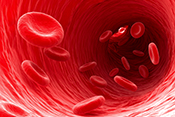 Photo: ©iStock/spanteldotru (05/25/2017)
A team of VA researchers defined new levels of ferritin and transferrin in the blood to be used as indicators of type 2 diabetes and cardiovascular disease risk. Ferritin and transferrin are proteins that contain iron and are found in blood. Research has shown that high iron levels correlate with both diabetes risk and death from cardiovascular disease. However, the levels of ferritin and transferrin that are considered "normal" are so broad that increased risk of both diseases has been seen in the normal ranges. The researchers found that ferritin levels of 15 ng/mL up to 80–100 ng/mL (nanograms per milliliter) in the blood and transferrin levels of 15 to 55 percent were associated with lower type 2 diabetes and cardiovascular disease risk, and therefore should be considered the proper “normal” range. (Current Diabetes Review, May 4, 2017)
|
Aggressive care at end of life for lung cancer linked to lower family satisfaction
 Photo: ©istock/beerkoff (05/18/2017)
Aggressive care in the last month of life for patients with non-small cell lung cancer was associated with lower family satisfaction with care, according to a study of VA data. Aggressive care includes chemotherapy, mechanical ventilation, acute hospitalization, and being admitted to an intensive care unit. The researchers looked at data on 847 cancer patients who died in VA care over a three-year period. They found that families of patients who had received at least one episode of aggressive care rated care lower compared with when aggressive care did not take place. Families of patients in hospice or palliative care units tended to rate care higher. The results suggest that aggressive care does not contribute positively to patients' and families' experiences in the final days of life, say the researchers. (Cancer, April 17, 2017)
|
Collaboration to accelerate proteogenomics cancer care
 Photo: ©istock/selvanegra (05/18/2017)
VA, the Department of Defense (DoD), and the National Cancer Institute have joined forces to advance cancer research and care. The new program, described in a recent journal article, is called the Applied Proteogenomics Organizational Learning and Outcomes Network, or APOLLO. The three agencies will work together to use advanced genomic and proteomic techniques to address cancer treatment at a molecular level. Genomics is the study of DNA and RNA, while proteomics is the molecular study of proteins. The collaboration arose out of the Cancer Moonshot initiative. (Clinical Pharmacology and Therapeutics, May 2017)
|
Possible biomarker of Gulf War illness identified
 Photo: Tech. Sgt. H. Deffner, U.S. Army (05/18/2017)
A team including several VA researchers identified biomarkers in the blood of both rodents and humans that may indicate Gulf War illness (GWI). Both animals and humans showed increases in multiple types of phospholipids related to GWI. These findings suggest inflammatory imbalances in GWI, since phospholipids play a role in the inflammatory process, say the researchers. GWI is hard to diagnose because it can present as multiple different symptoms. As such, identifying biological changes related to the condition could help with diagnosis and treatment. (PLoS One, April 28, 2017)
|
Psychological treatment may help patients with IBS
 Photo for illustrative purposes only. ©iStock/bowdenimages (05/12/2017)
Psychological treatments have some benefits for patients with irritable bowel syndrome (IBS), according to a literature review by researchers at the Michael E. DeBakey VA Medical Center. The researchers looked at studies of direct psychological treatments in gastrointestinal practices. They found that patients saw short-term benefits after treatment regardless of the type of treatment. IBS and pain symptoms improved for patients in behavioral therapy, mindfulness-based stress reduction, and emotional awareness training, compared with patients receiving no treatment. While these treatments seem to benefit patients with IBS, evidence on their effectiveness in this setting is limited. More research is needed to find best practices for psychological treatment in gastrointestinal care, say the researchers. (Digestive Diseases Week meeting, May 9, 2017)
|
Online weight-management program effective for patients with mental illness
 Photo for illustrative purposes only. ©iStock/lovro77 (05/12/2017)
An online weight-management program proved more effective than an in-person program or usual care, in a Greater Los Angeles VA Healthcare System study. Researchers assigned 276 overweight patients with serious mental illness either to computerized weight management with peer coaching (WebMOVE), in-person weight services, or usual care. Those in the WebMOVE group lost an average of six pounds after six months. Those in the other two groups did not show a significant change. Patients with mental illness face barriers to in-patient intervention because of expensive clinician time required and transportation problems. But an online program can be tailored to patients' specific needs and easily administered, say the researchers. (Journal of General Internal Medicine, April 2017)
|
Protein shown to suppress breast cancer growth in lab setting
 Photo: ©iStock/vitanovski (05/12/2017)
Researchers at the Kansas City VA Medical Center have shown how a specific protein can control breast cancer tumor growth and progression. By isolating a breast cancer cell line in the lab, the researchers showed how the protein CCN5 regulates the transition of cancer stem cells into cancer epithelial cells. CCN5 essentially blocks cellular growth by making tumor-initiating cells into non–tumor-initiating cells. Less expression of CCN5 by the genes correlates to tumor growth. The researchers speculate that restoring CCN5 protein could be beneficial in breast cancer and possibly other forms of cancer. (Scientific Reports, April 27, 2017)
|
CPAP could ease PTSD in Vets with sleep apnea
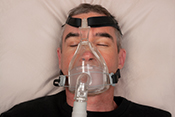 Photo: ©iStock/BVDC (05/04/2017)
PTSD symptoms improved in patients with obstructive sleep apnea who were given continuous positive airway pressure (CPAP) treatment, found a VA Western New York Healthcare System study. The researchers had 47 Veterans with obstructive sleep apnea use a CPAP device while they slept for three months. They found that patients' PTSD symptom improvement correlated with consistent CPAP usage. Veterans with severe to very severe PTSD had larger improvements than those with mild to moderate PTSD. CPAP usage also decreased the frequency of nightmares. The abatement of PTSD symptoms could be the result of better sleep from treating patients' sleep apnea, say the researchers. (Sleep Medicine, May 2017)
|
Little research available on blast versus nonblast TBI
 DoD photo by Lance Cpl. Immanuel Johnson (05/04/2017)
A literature review by Minneapolis VA Health Care System researchers found that little information is available about outcomes for blast versus nonblast traumatic brain injury (TBI) in U.S. military personnel. The research available shows that blast and nonblast TBI groups had similar rates of depression, sleep disorders, alcohol use, vision loss, balance problems, and functional status. Results were inconsistent about PTSD, headache, hearing loss, and neurocognitive functions. More research is needed on the differences between blast and nonblast TBI, along with consistent definitions of blast exposure, say the researchers. (Journal of Head Trauma Rehabilitation, April 18, 2017)
|
Study probes links between smoking, increased pain
 ©iStock/bagi1998 (05/04/2017)
There may be an association between smoking, gender, and musculoskeletal pain, according to a VA study. Researchers surveyed more than 1,000 Veterans who served in Iraq or Afghanistan about PTSD symptoms, depressive symptoms, and pain severity. They found that female Veterans who smoked had more moderate to severe musculoskeletal pain than female nonsmokers. This difference was not significance in male Veterans. Smoking may serve as a stress-reducer for some patients, which may explain why those in greater pain are more likely to smoke. The results support a need for more research on the gender-based risk factors for pain in Veterans who smoke, say the researchers. (Pain Medicine, March 14, 2017)
|
Drug-resistant bacteria on the rise in patients with spinal cord injury
 Photo: ©iStock/Scharvik (04/27/2017)
Patients with spinal cord injury and related disorders are at an increased risk of drug-resistant bacterial infection, according to a study of 130 VA medical centers. Researchers found that more than a third of gram-negative bacterial infections found in patients over a nine-year period were drug-resistant. Over that period, drug-resistant strains of bacteria became increasingly common. Infections may be more common in spinal cord injury patients because of altered bodily function as a result of the injury. Infections may also be diagnosed later than usual because of the loss of sensation. Priority should be given to controlling the spread of resistant bacteria and studying epidemiologic trends in spinal cord injury patients, say the researchers. (Journal of Spinal Cord Medicine, Feb. 15, 2017)
|
Mapping brain activity in PTSD and mild TBI
 Photo: ©iStock/spanteldotru (04/27/2017)
Researchers from two VA health care systems and their colleagues used a technique called magnetoencephalography to map activity in the brains of patients with PTSD and mild traumatic brain injury. Magnetoencephalography records the magnetic fields produced by electrical currents in the brain. The researchers found that alpha brain waves showed reductions in network structure—the interconnected system of neurons within the brain—in PTSD. The scans also showed a shift in connectivity from alpha bandwidth electrical activity to theta bandwidth in both conditions. There was also increased randomness associated with PTSD and increased structure with traumatic brain injury. The study shows the potential of magnetoencephalography to analyze brain activity in these two conditions, and to distinguish between them when similar symptoms occur, say the researchers. (Brain Connectivity, February 2017)
|
Case study points to better strategy for monitoring liver cancer
 Photo: ©iStock/luchsche (04/27/2017)
A recent case study suggested that screening for liver cancer at the molecular level for high-risk patients could help manage the disease. The hepatitis C virus is a major risk factor for liver cancer. An international team including a researcher from the Iowa City VA Health Care System followed a patient with hepatitis C and liver cancer. The patient had three tumors treated and removed. He then achieved sustained virologic response — when the hepatitis C virus is not detected in the blood. The researchers then compared RNA molecules from the patient with samples from other patients with liver cancer and hepatitis C. The comparison showed that the patient was at high risk for the cancer to return. By screening for cancer more frequently, at three-month intervals, the care team was able to detect a liver lesion early and treat it. They say the molecular biomarker test could help with early cancer detection in the growing population of hepatitis C patients. (Hepatology)
|
New technique for artificial lung manufacturing
 Photo: Jason Miller (04/21/2017)
Researchers with the VA Ann Arbor Healthcare System have come up with a new way to manufacture microfluidic artificial lungs that may have applications for human patients. Artificial lungs have been used for years to supplement patients' breathing, and recent microfluidic artificial lung technology has shown potential for great improvement in function. But microfluidic artificial lung material is hard to scale large enough for human use. The researchers have found a way to assemble a lung structure through continuous "rolling" and bonding of a single, patterned layer of polydimethyl siloxane. They expect that this technique will work to construct microfluidic artificial lungs large enough for human use. (Biomicrofluidics, April 2017)
|
Evaluation reveals areas for improvement in Veterans Choice Program
 Photo: ©iStock/sturti (04/21/2017)
Researchers at the Louis Stokes Cleveland VA Medical Center used the Lean Six Sigma quality-improvement strategy to evaluate the Veterans Choice Program (VCP), which allows eligible VA-enrolled Veterans to get certain health services at non-VA sites in their communities. The study found that key issues to target for improvement included inefficient exchange of information between staff and patients, shortages of VCP-participating providers, appointment duplication, declines in care coordination, and lack of program adaptability. Using evaluations such as Lean Six Sigma could help identify further ways to improve the program, suggest the researchers. (Medical Care, April 13, 2017)
|
Bulk of VA testosterone use for off-label purposes
 Photo: ©iStock/RapidEye (04/21/2017)
Only a small portion of testosterone prescriptions given in VA were for conditions for which testosterone has been approved by the FDA, according to a study of VA system data. The FDA approves testosterone only for diseases of the testis, pituitary, and hypothalamus. Yet only 6.3 percent of prescriptions in the VA were for these conditions over a five year period. The results show a need for more efforts to optimize testosterone-prescribing practices, say the researchers. They do note that there may be valid therapy reasons for off-label testosterone use. (Journal of General Internal Medicine, March 2017)
|
Many wet wipes contain potential allergens
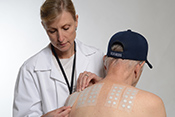 Photo by April Eilers (04/06/2017)
Two studies by Minneapolis VA Medical Center researchers found that many commonly used wet wipes contain a high number of potential allergens. The researchers examined ingredient lists for 178 facial wipe and 54 personal hygiene wipe products. They found that a majority of wet wipes on the market contain ingredients that could cause allergic contact dermatitis. The most common potential allergens in both types of wipes were fragrances, botanicals, preservatives, and propylene glycol. Preservatives such as methylisothiazolinone are the ingredients most likely to cause contact dermatitis, according to an earlier study by the same researchers and their colleagues that involved more than 9,000 patch-tested patients. It is important to consider the ingredients in wet wipes when evaluating contact dermatitis, say the researchers. (Dermatitis, March 23, 2017)
|
Combination of two therapies may be effective treatment for those with PTSD and borderline personality disorder
 Photo for illustrative purposes only. ©iStock/Highwaystarz-Photography (04/06/2017)
A combination of dialectical behavior therapy and prolonged exposure therapy may be a safe and effective means of treating Veterans with both PTSD and borderline personality disorder, found a Minneapolis VA Health Care System study. Twenty-two Veterans underwent a 12-week intensive outpatient program combining the two treatments. After the treatment, 91 percent of participants showed a significant reduction in PTSD symptoms. Dysfunctional coping styles (e.g., self-harm) were also reduced, as was suicidal ideation. Patients with borderline personality disorder are often excluded from PTSD treatments out of concern for an increased suicide risk. Combining the two treatments shows promise for treating this difficult population, say the researchers. (Journal of Traumatic Stress, March 22, 2017)
|
Frequent in-person coaching most effective for weight loss
 Photo: ©iStock/LeoPatrizi (03/30/2017)
Consistent and continuous treatment is needed to address obesity, according to a study of weight loss programs offered by VA. Researchers at two Midwestern VA medical centers tracked the weight loss of 332 Veterans participating in three different programs over two years. One group received usual care (VA's MOVE! program), one attended a Small Changes group program in person, and one received Small Changes counseling by phone. Small Changes encourages participants to make modest changes to dietary intake and physical activity level. In the first year, in which participants began with weekly sessions and tapered off to monthly sessions, those in the Small Changes in-person group lost twice as much weight as the other two groups. All groups showed significant weight loss. However, in the second year, when Small Changes participants had weight-loss sessions only every two months, the Small Changes in-person group experienced significant weight regain, while the other two groups continued their weight loss. Weight regain was often related to diabetes. The results show that ongoing and frequent contact with coaching is important for weight-management programs, say the researchers. (Journal of General Internal Medicine, March 7, 2017)
|
Nearly half of soldiers with mTBI had postconcussive symptoms three months postdeployment
 Photo: Staff Sgt. William Tremblay/USA (03/30/2017)
In a study by the Defense and Veterans Brain Injury Center study, almost half of soldiers who had a mild traumatic brain injury (mTBI) while serving in Afghanistan or Iraq had postconcussive symptoms three months after their deployment. The researchers examined 366 soldiers with previous mTBI and 599 without three months after they were screened for TBI upon their return. Forty-seven percent of those with mTBI had postconcussive symptoms at the three-month mark, while only 25 percent of controls did. The most common symptoms were sleep problems, forgetfulness, irritability, and headaches. Those with mTBI were twice as likely as controls to have received rehabilitative services after deployment. "The persistence of symptoms, even absent [posttraumatic stress], suggests that mTBI is associated with continuing problems for longer than has been generally recognized in the active duty population," wrote the researchers. (Neurology, March 17, 2017)
|
Alzheimer's caregiver intervention not associated with additional health care costs
 Photo: ©iStock/Eva-Katalin (03/30/2017)
REACH programs to support caregivers of patients with Alzheimer's disease and related dementias did not lead to increased health care costs for either patient or caregiver, according to a study by VA researchers in Tennessee and New York. REACH (Resources for Enhancing Alzheimer's Caregivers Health) provides caregivers with interventions to increase coping skills and management of patient behaviors. Previous research has shown that REACH interventions benefit both caregivers and patients, but concerns about additional health care costs may have hindered the program's adoption. The study shows that REACH did not add to health care costs. In fact, VA patients in the REACH program showed significantly lower health care costs. (Journal of the American Geriatric Society, March 13, 2017)
|
Copper cuts bacteria growth on hospital surfaces
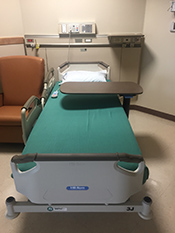 Courtesy of EOS Surfaces (03/23/2017)
Copper-impregnated surfaces may lower bacteria growth on hospital surfaces, found a Central Texas Veterans Healthcare System study. Copper is known to self-sanitize and naturally reduce the growth of bacteria. However, few studies have looked at its effectiveness in reducing contamination in real-world hospital settings. Researchers measured the number of bacteria on copper-containing and standard bedside tray tables in hospital rooms. They found that the bacteria amount was 81 percent lower on the copper-infused trays 30 hours after the test began. The copper-containing trays showed similar levels of bacteria as trays in rooms under isolation protocol to prevent infection. The copper-infused surfaces used in the study have the appearance of stone. Using them in patient rooms may help reduce the spread of infection in hospitals, say the researchers. (American Journal of Infection Control, Feb. 22, 2017)
|
Recommendations on using weight-management drugs
 Photo: ©iStock/emesilva (03/23/2017)
A VA Health Services Research and Development workgroup recently developed recommendations for the use of weight management medications (WMMs) within VA. Previous data show that only 2 percent of Veterans in VA care eligible for WMMs are prescribed the medications. The workgroup found that barriers to this treatment included patient and provider concerns about safety and efficacy, limited involvement of primary care, and overly restrictive medication criteria. The workgroup recommended educating patients and providers about WMMs and the health benefits of weight loss, increasing primary care provider engagement, relaxing criteria for use, and creating a system to help patients navigate weight-management options. (Journal of General Internal Medicine, April 2017)
|
Past sexual assault linked to risk for sexually transmitted disease
 Photo: ©iStock/jarun011 (03/23/2017)
Women Veterans who have experienced sexual assault may be at increased risk for sexually transmitted infections (STIs). Researchers interviewed women Veterans at two facilities in the VA Midwest Healthcare Network. Of the 996 women interviewed, 51 percent reported past sexual assault, and 32 percent had a history of STIs. Women who had experienced sexual assault were significantly more likely to report a history of STIs. The cause of this correlation is not clear. History of sexual assault should be considered when determining the need for STI screening, say the researchers. (Journal of Women’s Health, March 10, 2017)
|
Rebuilding cartilage using collagen scaffolding
 Photo: Ames Laboratory, U.S. Dept. of Energy (03/23/2017)
British researchers and a collaborator at the Memphis VA Medical Center published work on a new way to promote cartilage regeneration in osteoporosis. Providing a three-dimensional scaffold for cell attachment could help stem cells to form into cartilage. The researchers found that creating a scaffold that mimics the composition and structure of the cartilage in the body promotes this growth. Using collagen type-II and chondroitin sulfate promoted cartilage growth more than other scaffold configurations. The technique could lead to better tissue-engineering treatments for osteoarthritis. (Scientific Reports, March 3, 2017)
|
Functional electrical stimulation helps MS patient walk
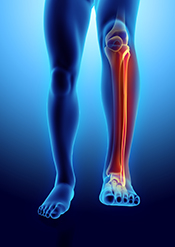 Photo: ©iStock/yodiyim (03/15/2017)
Functional electrical stimulation improved the walking ability of a patient with multiple sclerosis, in a case study by researchers at the Louis Stokes Cleveland VA Medical Center. The patient had lower limb weakness and was frequently unable to take a step unaided. Doctors implanted electrodes into the muscles of his hip, knee, and ankle. The electrodes delivered stimulation that helped activate the muscles in his legs. Over a 90-day trial, he was able to consistently take steps with electrical stimulation. The case study shows that implanted electrical stimulation devices could help restore walking in patients with muscle weakness caused by MS, according to the researchers. (American Journal of Physical Medicine & Rehabilitation, Feb. 1, 2017)
|
ADHD associated with nonsuicidal self-injury
 Photo by Mitch Mirkin (03/15/2017)
Male Veterans with attention deficit hyperactivity disorder (ADHD) were significantly more likely to report nonsuicidal self-injury (NSSI) than those without ADHD, according to a study by VA Mid-Atlantic Health Care Network and Central Texas VA Health Care System researchers. Veterans with PTSD were more likely to have ADHD symptoms than those without PTSD. However, PTSD was not associated with NSSI, contrary to what the researchers expected, based on past studies. The findings show that ADHD may increase the risk of NSSI in male Veterans independent of other factors such as PTSD, say the researchers. (Psychiatry Research, Feb. 24, 2017)
|
Statin use linked to higher odds of diabetes in physically active people
 ©iStock/gilaxia (03/15/2017)
Statin use was associated with double the odds of diabetes and its complications without offsetting cardiovascular benefits, in a VA North Texas Health Care System and University of Texas Southwestern study. The researchers looked at rates of diabetes and cardiovascular outcomes in healthy, physically fit people who were using statins to prevent cardiovascular disease. Statin use is currently recommended for adults 40 to 75 years old with one or more risk factors for cardiovascular disease, such as high cholesterol, diabetes, high blood pressure, or smoking and a calculated risk of heart attack. The researchers found 12.5 percent of statin users and 5.8 percent of nonusers were diagnosed with diabetes. Furthermore, 1.7 percent of statin users and 0.7 percent of nonusers were diagnosed with diabetic complications, such as nerve, kidney, and eye damage. Of the statin users, 1.6 percent had major acute cardiovascular events, compared to 1.5 percent of nonusers. Those rates were much lower than in the general population, but did not show a difference between statin users and nonusers. The researchers concluded that the risks and benefits of statin use in healthy, physically active people may need to be reconsidered. (Journal of Science and Medicine in Sport, Jan. 24, 2017)
|
Smaller changes in cortisol levels linked to better response to PTSD treatment
 ©Stock/marekuliasz (03/09/2017)
Change in cortisol levels during treatment predicted how well patients with PTSD responded to psychotherapy, found researchers at the Atlanta and Ann Arbor VA health care systems. Cortisol is a hormone released by the adrenal gland in response to stress. The researchers measured cortisol in the saliva during treatment of 30 Veterans undergoing either prolonged-exposure or present-centered therapy. They found that patients who had a greater increase in cortisol levels over the course of treatment had less reduction of PTSD symptoms. Contrary to what the researchers expected, overall cortisol levels did not predict how well patients responded to treatment. Modulating patients' hormonal responses may aid their response to treatment, suggest the researchers. (Journal of Clinical Psychiatry, Jan. 17, 2017)
|
Causes of suicide on hospital grounds
 ©Stock/sshepard (03/09/2017)
Researchers with the VA National Center for Patient Safety analyzed the root causes of suicide or suicide attempts on VA hospital grounds and in hospital common spaces and clinic areas (as opposed to patient rooms). They found that the primary causes were breakdowns in communication between patient and staff; the need for improved psychiatric and medical treatment of suicidal patients; and problems with the physical environment, such as unmonitored nonclinical areas. Forty-seven suicides or suicide attempts were reported over a 15-year period. The researchers recommend that hospital staff evaluate the environment for suicide hazards, consider prohibiting firearms (currently, VA facilities nationwide do not allow firearms on their campuses), assist patients who do not have appointments, and promote better communication between staff about high-risk patients. (Journal of Patient Safety, Feb. 22, 2017)
|
Neuroprotective compound may improve brain function after stroke
 ©Stock/stockdevil (03/09/2017)
The neuroprotective compound P7C3-A20 improved brain function after stroke in rats, found a study by Iowa City VA Health Care System and University of Miami researchers. Rats injected with the compound did better than controls on sensorimotor and cognitive tests. The rats treated with P7C3-A20 also showed significantly less cortical and hippocampal atrophy. They also had improved growth of new nerve tissue. The results suggest that this compound could be useful in protecting the brain from ischemic stroke, say the researchers. (Experimental Neurology, Jan. 8, 2017)
|
More studies needed on the effect of risk factors on multiple sclerosis
 ©iStock/sudok1 (03/02/2017)
Two literature reviews by VA researchers and their associates showed that more research is needed on how risk factors affect multiple sclerosis (MS) progression. One review showed that low vitamin D levels were consistently associated with MS progression, and smoking was associated with more rapid decline in MS disability. However, the different methods and measures used by different studies make it hard to draw conclusions. A second review by the same researchers found that no current risk factor interventions had significant effects on MS progression. More studies are needed on vitamin D supplements, long-term exercise, and smoking cessation, say the researchers. (Multiple Sclerosis Journal, Feb. 1, 2017; Multiple Sclerosis Journal, Feb. 1, 2017)
|
Clinical practice guidelines for low back pain
 ©iStock/ChesiireCat (03/02/2017)
VA researchers were part of an American College of Physicians group that developed recommendations for treating low back pain by reviewing multiple studies published on the topic. They recommend that patients with acute or subacute low back pain should use non-medication treatment such as heat, massage, or acupuncture. If medication is required, clinicians should prescribe nonsteroidal anti-inflammatory drugs or muscle relaxants. Patients with chronic low back pain should be treated without medications whenever possible. If patients do not respond to non-medication treatment, they should be prescribed nonsteroidal anti-inflammatory drugs as first-line therapy, or tramadol (sold as Ultram or Zytram) or duloxetine (sold as Cymbalta) as second-line therapy. Opioids should be an option only after other treatments have proved ineffective and only if potential benefits outweigh risks. (Annals of Internal Medicine, Feb. 14, 2017)
|
New understanding of how white blood cells work
 ©iStock/blueringmedia (03/02/2017)
Researchers with the University of Iowa and Iowa City VA Health Care System found evidence of neutrophil plasticity, or the ability of these cells to change in the body. Neutrophils are the most common type of white blood cell. The concepts of neutrophil plasticity and different neutrophil phenotypes (cells with different structural characteristics) are new; previously, scientists thought that these cells all had similar properties. The researchers exposed neutrophils to H. pylori bacteria, and found that the structure of the nucleus of some neutrophil cells changed after bacterial infection. This demonstrates that the cells can change while still alive. The results could lead to a better understanding of bacterial diseases, particularly how white blood cells fight and interact with infections. (Journal of Immunology, Mar. 1, 2017)
|
Psychotropic medication linked to higher dementia risk in patients with PTSD
 Photo: ©iStock/Kwangmoozaa (02/23/2017)
PTSD by itself has been linked to a higher risk for dementia later in life, but certain medications often used as part of PTSD treatment appear to compound that association. An analysis of data on more than 417,000 Veterans found that those with PTSD who were treated with selective serotonin reuptake inhibitors (SSRIs), novel antidepressants, or atypical antipsychotics were more likely to be diagnosed with dementia, relative to those with or without a PTSD diagnosis but not using any of these drugs. The patients in the study had an average age of 67.7 at the start of the study period, back in 2003, and they were followed, on average, for about 9 years. Those using benzodiazepines or serotonin-norepinephrine reuptake inhibitors (SNRIs) had an increased dementia risk, regardless of whether they had PTSD. The researchers say while it's possible some of the drugs may directly contribute to dementia risk, it's also possible that their use is a marker for more severe PTSD symptoms, or other underlying brain conditions, that may account for the higher dementia risk. They recommend further study. (Journal of the American Geriatrics Society, January 2017)
|
Wii Fit exercise program boosts balance in older adults
 A Veteran receives an explanation of the Wii-Fit from Dr. Kalpana Padala at the Central Arkansas Healthcare System. (Photo by Jeff Bowen) (02/23/2017)
A Wii Fit exercise program improved balance in older adults, found a Central Arkansas Veterans Healthcare System study. Fifteen Veterans participated in an exercise program on the Wii Fit video game for 45 minutes, three days a week for eight weeks. The control group, also including 15 Veterans, performed a computer-based cognitive program. Those in the exercise group scored significantly better than controls on measures of balance. The results show that a Wii Fit exercise program is safe and feasible for community-dwelling older adults with balance problems. (Journal of Aging Research, Feb. 5, 2017)
|
Physical activity counseling improves activity levels at low cost
 Photo: ©iStock/kali9 (02/23/2017)
A physical activity counseling program improved activity levels and gait speed in older Veterans at only a small percentage of patients' health care costs in a VA Mid-Atlantic Health Care Network study. The program included initial in-person exercise counseling, followed by telephone counseling at two, four, and six weeks, and monthly thereafter for one year. The total cost of the program per participant averaged $696, about 6 percent of patients' estimated annual health care costs. The cost of this program may be offset by lower health care costs due to improved physical fitness, but that result was not statistically significant in the study. (Journal of the American Geriatrics Society, January 2017)
|
Thiazide blood-pressure drugs could lower fracture risk
 ©iStock/Sutthaburawonk (02/15/2017)
A certain class of blood pressure medication may improve bone strength in patients with osteoporosis, according to a secondary analysis of data from a larger study involving VA medical centers. Research shows that people with high blood pressure tend to have more osteoporotic fractures. This study showed that patients on chlorthalidone, a thiazide-type medication also sold as Hygroton, had lower risk of hip and pelvic fracture than those on amlodipine (sold as Norvasc) or lisnopril (sold as Zestril). Thiazides are one class of diuretics, or water pills. They increase the amount of water and salt expelled from the body as urine. They also affect the body’s balance of minerals. The results suggest that thiazide-type blood pressure medication could reduce fracture risk in older adults. (JAMA Internal Medicine, January 2017)
|
Transparent clinical notes can build trust with mental health patients
 ©iStock/Steve Debenport (02/15/2017)
Allowing patients in VA mental health care to view clinical notes about their visits with providers can strengthen or strain their trust in those providers, depending on the contents of the notes. Researchers interviewed 28 patients who had access to OpenNotes, allowing them to see what their clinicians wrote about their treatment. The study found that ensuring consistency between what occurs during appointments and what the notes say makes patients trust their clinicians more. Notes that highlight patient individuality and strengths also help create trust. Showing transparency and respect in clinical notes can help build trust with patients, say the researchers. (Psychiatric Services, Feb. 1, 2017)
|
Modest brain changes seen in patients with schizophrenia after computer exercises
 ©iStock/Image Source (02/15/2017)
Patients with schizophrenia showed cognitive improvements after cognitive remediation training in a Minneapolis VA Health Care System study. Cognitive remediation involves computer exercises that place demands on working memory. Patients who received 48 hours of cognitive remediation over a 16-week period showed increased activation of the left prefrontal cortex of the brain, compared with those in the placebo group, who received only basic computer skills training. Increased brain activation, as shown on a type of MRI scan that tracks blood flow, correlated with improved task accuracy and suggests improved neuroplasticity. According to the researchers, the results suggest that brain activation may be an important target for schizophrenia interventions. However, the results were modest, and significant changes were not reported in other areas of the brain, contrary to what the researchers expected. (British Journal of Psychiatry, February 2017)
|
C. difficile treatment with vancomycin results in fewer deaths than treatment with metronidazole
 ©iStock/Scharvik (02/09/2017)
The antibiotic vancomycin reduced the risk of death after C. difficile infection over another antibiotic, metronidazole, found a study of VA health care system data. In recent decades, C. difficile infection has become a major cause of death inside and outside of hospitals. Metronidazole is the most common drug used to treat C. difficile. While C. difficile recurrence rates were similar with both drugs, this study showed that those treated with vancomycin were less likely to have died than those treated with metronidazole within 30 days after treatment. The findings justify vancomycin as initial therapy for C. difficile infection, according to the researchers. (JAMA Internal Medicine, Feb. 6, 2017)
|
Unique challenges of delivering primary care to women Veterans
 ©iStock/javi_indy (02/09/2017)
VA's Patient Aligned Care Team (PACT) initiative faces unique challenges in delivering care to women Veterans, according to a VA Greater Los Angeles Health Care System study. The researchers interviewed 73 primary care providers and other staff about the benefits and difficulties of providing PACT care to women Veterans. Those interviewed said that PACT improved continuity of care and helped nursing staff practice effectively. Problems included inconsistent implementation of PACT procedures, short staffing, and space constraints. Challenges unique to the care of women Veterans included more psychosocial needs, the need for specialized training for staff, and inadequate staffing due to a separation between woman's health and primary care services. (Women's Health Issues, Jan. 4, 2017)
|
Clock-in-the-Box test helps predict return home after hospital stay
 ©iStock/monkeybusinessimages (02/09/2017)
The Clock-in-the-Box (CIB) test is effective at predicting whether older patients will return home after hospitalization, suggests a new study. The CIB is a brief cognitive screening measure that assesses memory and executive functions. This VA Boston Healthcare System study found that every unit of increase on the CIB was associated with a lower likelihood of being discharged to somewhere other than home, such as a nursing home or rehabilitation center. The results support the CIB as a tool to inform clinical treatment decisions and discharge planning, say the researchers. (Clinical Interventions in Aging, Nov. 11, 2016)
|
E. coli contamination widespread in U.S. chicken
 Photo: ©iStock/MikeyGen73 (02/02/2017)
Antibiotic-resistant E. coli contamination is widespread in commercial U.S. chicken meat, found a study that included Minneapolis VA Health Care System researchers. Many of the strains of E. coli found in chicken do not respond to antibiotics. This means that it can be much harder to treat people infected with E. coli from eating chicken. Organic chicken breasts had slightly lower levels of antibiotic resistance, but had just as strong E. coli contamination as non-organic chicken. The study, conducted in 2013, suggests retail chicken products in the U.S. pose a potential health threat to consumers even if they are labeled as organic. Food-safety experts say thorough cooking kills the bacteria in meat, but consumers don’t always follow guidelines. (Applied and Environmental Microbiology, Jan. 6, 2017)
|
Compound improves cognitive function after stroke
 Photo: ©iStock/FikMik (02/02/2017)
A chemical compound called P7C3-A20 could help improve cognitive function after stroke. When given to rats, P7C30-A20 protected existing neurons from atrophy and promoted the regeneration of new neurons in the brain. The rats treated with P7C30-A20 performed better than controls on movement and memory tests after seven days. The researchers also found decreased cortical and hippocampal atrophy in the treated rats. This study suggests that P7C3 compounds may be useful in protecting the brain from stroke. This study was conducted by researchers with the University of Miami, University of Iowa, and Iowa City VA Health Care System. (Experimental Neurology, Jan. 8, 2017)
|
Review of significant infectious-disease research cites key VA study
 Photo: ©iStock/AlexRaths (02/02/2017)
A recent review of infectious-disease research selected a 2015 VA study as contributing significantly to the field. The VA study, published in the journal Clinical Infectious Diseases, looked at the effectiveness of two drugs in fighting vancomycin-resistant Entrerococcus bloodstream infections (VRE-BSIs), bacterial infections that resist treatment with common antibiotics. The study found that treatment with the antibiotic linezolid resulted in significantly higher treatment failure than treatment with daptomycin. Linezolid treatment was also associated with a higher rate of mortality in the study group. According to the researchers, the results show that daptomycin is a better choice than linezolid for treating VRE-BSIs. (American Journal of Health-System Pharmacy, Feb. 15, 2017)
|
New evidence on how aspirin may help prevent cancer
(01/26/2017)
Researchers with the Michael E. DeBakey VA Medical Center and University of Texas may have found why aspirin can help prevent and treat some cancers. Scientists have long known that taking aspirin can lower the risk of certain cancers and stop the spread of cancer cells, but how this works is not well understood. The new research suggests that aspirin stops platelets from interacting with cancer cells, which affects cancer growth. The researchers further found that a new type of aspirin (based on lipid molecules) may be even more effective at preventing cancer. (Cancer Prevention Research, Dec. 20, 2016)
|
Protein in lungs could be target for asthma drugs
 Photo: ©iStock/yodiyim (01/26/2017)
Targeting asthma drugs to a specific protein (HIF-1alpha) in the lungs could help limit airway inflammation, according to a VA San Diego Healthcare System study. A drug to inhibit HIF-1alpha in mice led to less allergic inflammation in the airway, although the response varied based on genetic factors. Asthma can be caused by different genetic variants, and current therapies are limited in their effectiveness. The researchers suggest HIF-1alpha inhibitors may be a way to effectively target certain forms of the disorder. (Clinical Immunology, Jan. 13, 2017)
|
Pay-for-performance has limited effect on health care
 Photo: ©iStock/simarik (01/26/2017)
Pay-for-performance programs may improve health care procedures, but evidence does not show that they improve patient outcomes. Pay-for-performance programs give financial rewards or penalties to health care providers and institutions according to their performance on quality measures. A literature review found some evidence that these programs improve the processes that institutions use, but this evidence was low-strength and somewhat contradictory. The review found no evidence that these programs improve patient outcomes. (Annals of Internal Medicine, Jan. 10, 2017)
|
Few Veterans with moderate or severe TBI go back to work
 Photo: ©iStock/lentolo (01/18/2017)
Few service members and Veterans with moderate to severe traumatic brain injury (TBI) return to work one year after their injury, according to a VA Polytrauma Rehabilitation Centers study. In a study of 293 Veterans and service members, only 21 percent were employed one year after a TBI. Those who were older, were minorities, or had a more severe TBI were more likely to be unemployed. Every additional year of age was linked to a 2 percent decrease in employment likelihood. Eighty-three percent of minorities were unemployed after one year, compared with 76 percent of nonminorities. Eighty-five percent of subjects with severe TBI were unemployed, while only 63 percent of subjects with moderate TBI were unemployed. These results will help VA plan rehabilitation services, say the researchers. (Journal of Head Trauma Rehabilitation, Jan. 5, 2017)
|
Rewards can push older adults to walk more
 Photo: ©iStock/FatCamera (01/18/2017)
Older adults were more likely to meet daily step goals when they received reward money or had money donated to charity for reaching those goals. Study participants were challenged to increase their daily step counts by 50 percent. Those who were offered a reward of $20, a $20 donation to the charity of their choice, or a combination of the two were more likely to meet the step goal than those who were offered only feedback during a 16-week period. According to the researchers, incentives such as these could be used to get older adults to walk more. (American Journal of Preventive Medicine, Jan. 3, 2017)
|
Toxic exposures common in recent wars
 Photo: Airman 1st Class Christopher Griffin/USAF (01/18/2017)
A study of 224 Iraq and Afghanistan Veterans found that 97.2 percent were exposed to toxic hazards during deployment. Toxic exposure was associated with chronic multisymptom illness (CMI) symptoms in these Veterans. The most common type of toxic exposure was breathing in smoke or fumes. Pesticide exposure was the most likely predictor of CMI. More analysis is needed on specific toxic hazards Veterans face and the relationship with CMI in order to improve prevention, say the researchers. (Journal of Occupational and Environmental Medicine, January 2017)
|
Sunlight improves function of immune cells
 Photo: ©iStock/selvanegra (01/12/2017)
Researchers at the Washington DC VA Medical Center, Georgetown University, and Vinh University in Vietnam found a mechanism that may explain why sunlight can reduce instances of autoimmune disease and some cancers, as shown in past research. Through experiments with human cells and mouse tissue, they found that T cells within skin are naturally sensitive to blue light. T cells serve an important purpose in the immune system and help the body adapt to disease. Blue light, which is absorbed by the skin from sunlight, appears to improve the movement of T cells within the body, which benefits the immune system. Scientists have long known that sunlight can have positive effects on the immune system, but were not sure why. (Scientific Reports, Dec. 20, 2016)
|
Multiple medical conditions linked to arthritis-causing disease
 Photo: ©iStock/bloodstone (01/12/2017)
Researchers looked at a large Veteran population to identify other conditions associated with calcium pyrophosphate crystal deposition disease (CPDD), a common cause of arthritis. They found that people with CPDD had high rates of hyperparathyroidism, gout, osteoarthritis, rheumatoid arthritis, hemochromatosis, hypomagnesemia, and chronic kidney disease. These patients also tend to take calcium supplements, the study found. The use of common high blood pressure and heartburn medicines was not associated with CPDD. Knowing these links could help doctors develop treatment strategies for CPDD. (Arthritis Care & Research, Nov. 29, 2016)
|
Health-promoting behaviors may reduce suicidal thoughts in Veterans with PTSD
 Photo: ©iStock/PeopleImages (01/12/2017)
A survey of more than 100 Iraq and Afghanistan Veterans found that those who participated in health-promoting behaviors had a lower rate of suicidal thoughts. Research shows that Veterans with PTSD are more likely to have suicidal thoughts. But the link was less pronounced among those in the study with PTSD who said they routinely engaged in activities to foster good nutrition, physical activity, stress management, spiritual growth, health responsibility, and interpersonal relationships. The researchers say promoting these activities in Veterans with PTSD could help lower suicide risk. (PLoS One, Dec. 21, 2016)
|
High-protein diet linked to lower bone risk
 Photo ©iStock/stock colors (01/05/2017)
Older men who eat more protein have a lower risk of broken bones, according to a recent study. The study looked at 5,875 men over 15 years. Those with more protein in their diet had fewer broken bones than those who ate less protein, and the source of protein also mattered. More protein from dairy and other animal sources (meat, fish, poultry, eggs) was linked to lower hip fracture risk, while protein from plants (such as legumes, grains, and nuts) was not. Higher protein was tied to fewer hip fractures but not fewer spine fractures, showing this connection might vary by body part. While the study focused only on men, and by itself does not prove a direct causal link between protein intake and bone strength, the researchers nonetheless suggest that adding one to two servings per day of protein-rich foods may help older adults cut fracture risk. (Journal of Bone and Mineral Research, Dec. 12, 2016)
|
Intensive outpatient program did not lower health care cost or use
 Photo ©iStock/shironosov (01/05/2017)
Intensive outpatient care resulted in health care use and costs that were similar to those of standard care in a VA Palo Alto Health Care System study. The study compared 433 high-need patients in standard Patient Aligned Care Team (PACT) care with 150 patients in an Intensive Management program (ImPACT). Patients in ImPACT receive extra outpatient care, including tracking goals and priorities, care management for medical and social service needs, and coordination between VA and non-VA providers. Patients in both programs had similar costs and numbers of hospital visits. Those in the ImPACT group were slightly more satisfied with VA care. These results were surprising—the researchers expected ImPACT to reduce care utilization and cost. (JAMA Internal Medicine, Dec. 27, 2016)
|
'Safety huddles' ease risks linked to electronic health records
 Photo ©iStock/sturti (01/05/2017)
"Safety huddles" can help limit safety risks related to electronic health records (EHRs), found a VA study. These risks include mislabeled medicine, data loss due to computers not working, and incorrect treatment doses. One medical center used a daily meeting of care providers and support staff to discuss safety concerns and "great catches" of potential problems. Over 249 meetings, they were able to identify and address 245 EHR-related safety concerns. The study authors recommend that health care systems use huddles to help improve EHR use. (Journal of the American Medical Informatics Association, Dec. 28, 2016)
|
Study compares infection control in VA, non-VA nursing homes
 Photo: ©iStock/Wavebreak (12/29/2016)
VA and non-VA nursing homes differed in their approach to catheter-associated urinary tract infections, according to a recent study. VA nursing homes reported more hours per week devoted to infection prevention, were more likely to have committees to review infection policies, had higher physician and nurse staffing-to-bed ratios, had higher percentages of 24-hour registered nurse supervision, and kept track of catheter-associated urinary tract infection rates more regularly, compared with non-VA nursing homes. Most VA nursing homes also had infection prevention programs integrated within VA acute-care programs. A lower percentage of VA nursing homes had policies on appropriate catheter use, compared with non-VA nursing homes. The authors suggest that universal practices should be adopted in both VA and non-VA nursing homes. (Infection Control and Hospital Epidemiology, online Dec. 5, 2016)
|
How do the experiences of U.S. and Australian Veterans compare?
 Photo courtesy of Australian Army (12/29/2016)
A recent comparison based on data from VA and the Australian Department of Veterans’ Affairs showed several differences in post-1990 deployment outcomes. The U.S. deployed significantly more personnel than Australia during this period. Veterans from the two countries had similar overall rates of PTSD. Gulf War Veterans from both countries had a reduced risk of suicide, compared with the general population, but U.S. Veterans of Iraq and Afghanistan had higher rates of suicidal thoughts. U.S. Gulf War Veterans had higher rates of multisymptom illness than Australians, and were also more likely to have been in combat. The two countries’ health care systems were alike in terms of their range of services, focus on mental health, and increasing use of technology, but different in some aspects of service provision and financial structure. (Australian DVA website, Dec. 14, 2016)
|
Concerns about falling not linked to low blood pressure
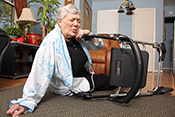 Photo: ©iStock/ Imagesbybarbara (12/22/2016)
In one of the latest findings to be reported from a major study on high blood pressure treatment that was funded by the National Institutes of Health and involved VA researchers, fear of falling was not associated with low blood pressure or with blood pressure medication use in older adults. While participants with more concern about falling were found to be taking more medicine to combat high blood pressure, the study did not find a link between actual low blood pressure due to medication use and fear of falling. Fear of falling is common in older adults with high blood pressure who take medication to manage the condition. Many do not wish to increase their dose because they fear medication-induced low blood pressure will increase their risk of falling. The researchers point out that it is important to address patients’ fear of falling, in addition to actual fall risk. (Journal of the American Geriatrics Society, November 2016)
|
Virtual training for staff helps prevent pressure ulcers
 Photo: ©iStock/ Johnny Greig (12/22/2016)
A new training program decreased the rate of pressure ulcers in VA. The Virtual Breakthrough Series (VBS) is a teleconferencing and email-based training program that uses personalized coaching and group education to help staff implement care changes to prevent pressure ulcers in patients. After the project was implemented, the pressure ulcer rate dropped from 1.2 to 0.9 per 1,000 bed days of care. VBS has previously been used to prevent catheter-associated urinary tract infections and to prevent falls. The researchers say that together, these studies show that VBS could be a powerful tool to improve the quality and safety of care in VA. (Journal of Nursing Care and Quality, online Nov. 29, 2016)
|
Veterans show no health effects of uranium exposure 25 years later
 Photo courtesy of www.gulflink.osd.mil (12/22/2016)
Gulf War Veterans wounded in depleted uranium friendly-fire incidents showed no uranium-related health effects 25 years after exposure. Veterans with embedded uranium fragments had elevated urine uranium concentrations, while those who had been exposed to uranium through inhalation had lower urine uranium concentrations. Although these Veterans did not show any negative health effects, metal fragments still in their bodies continue to expose them to uranium radiation, and dangerous concentration thresholds may still be reached. The researchers recommend continued health surveillance for this group. (Environmental Research, January 2017)
|
AspireAssist device leads to greater weight loss
(12/14/2016)
Patients equipped with the AspireAssist System, a tube placed in the stomach that allows stomach contents to be drawn out, lost more weight than patients who received only lifestyle counseling. In a year-long study in obese patients, patients who received both lifestyle counseling and the AspireAssist lost an average of 12.1 percent of their body weight, compared with a 3.5 percent loss for patients who only received counseling. This treatment could prove effective for long-term treatment of obesity, according to the study authors. It should be noted that the company that makes the device funded the study, which involved the San Diego VA and numerous university sites, and was involved with analyzing the data and preparing the manuscript. (American Journal of Gastroenterology, Dec. 6, 2016)
|
HIV increases risk for lung cancer
(12/14/2016)
HIV infection could contribute to the development of lung cancer, according to a study of participants in the Veterans Aging Cohort Study. Chronic inflammation and a dysfunctional immune system, both associated with HIV, are two factors that could increase the cancer risk, say the researchers. The study also showed that patients with lower T-cell counts were more likely to develop lung cancer. These findings could be used to target lung cancer prevention to this high-risk group, say the researchers. (The Lancet HIV, Dec. 2, 2016)
|
TeleMOVE is an effective weight-loss program
(12/14/2016)
A VA San Diego Healthcare System study found that participants in a VA telehealth weight-loss program lost more weight than those in the in-person program. Participants in the new TeleMOVE program lost an average of 8.6 pounds during the 90-day program, while those who attended the MOVE! in-person weight-loss classes lost an average of 4.5 pounds over the course of eight classes. Participants who adhered to the program lost more weight than those who missed sessions, regardless of which program they were in. (Obesity Research & Clinical Practice, Dec. 5, 2016)
|
Can neurocognitive function predict suicide?
 Photo: ©iStock/efks (12/08/2016)
A study of Army administrative data found an association between decreased neurocognitive functioning and suicide in soldiers. Researchers found that lower scores on a computerized test of neurocognitive functioning—including problems in decision-making, problem-solving, verbal fluency, and memory—were linked to suicide attempts or death and suicidal thoughts in the following 12 months. The study showed more suicide attempts in soldiers who were female, less educated, white non-Hispanic, and younger at the time of testing, and who had a mental health diagnosis before testing. The researchers say that neurocognitive testing may be a useful tool in predicting future risk of suicide. (Suicide & Life-Threatening Behavior, Nov. 1, 2016)
|
Military sexual trauma linked to mental health problems in transgender Veterans
(12/08/2016)
Military sexual trauma (MST) is associated with mental health problems in transgender Veterans. A study of 332 transgender Veterans who served in Iraq and Afghanistan found that MST was associated with likelihood of PTSD and personality disorder for both men and women, and with bipolar disorder and depressive disorder for women. Fifteen percent of the Veterans included in the study had experienced MST. The researchers conclude that medical forms should include gender identity in addition to biological gender, and that MST treatment should be culturally competent. (Journal of Traumatic Stress, December 2016)
|
Nanoparticle may aid in bladder cancer diagnosis, treatment
 (Photo courtesy of Pan lab) (12/08/2016)
Researchers have developed a nanoparticle that promises to help in the diagnosis and treatment of bladder cancer. The particle, called PLZ4-nanoporphyrin (PNP), emits fluorescent light when exposed to infrared light. By coating PNP with a molecule specific to bladder cancer, researchers were able to identify cancer cells with the light and diagnose the condition in mice. PNP was also shown to be able to release chemotherapy drugs, as well as photodynamic and photothermal treatment agents, slower and more effectively than other methods. While this new technique of bladder cancer diagnosis and treatment has been shown to work so far only in mice, the researchers believe it could easily be adapted to individualized medicine in a clinical setting. (Biomaterials, October 2016)
|
Educational intervention targets racial gaps in use of knee replacements
(12/01/2016)
African American patients who were shown an informational video about knee replacement surgery were 85 percent more likely than those who did not view the video to undergo the surgery, according to a study by researchers at the Philadelphia VA Medical Center and their partners. African Americans are significantly less likely than whites to have knee replacement surgery to relieve pain from arthritis, largely due to lack of knowledge about the treatment. The rate at which doctors recommended knee replacement was higher for those who viewed the video, but this result was not statistically significant. The researchers say that this low-cost, patient-centered intervention could increase use of an effective orthopedic procedure among minority patients. (JAMA Surgery, Nov. 23, 2016)
|
Telehealth versus in-person therapy for chronic pain
(12/01/2016)
Video teleconferencing can be just as effective as in-person treatment for patients in acceptance and commitment therapy (ACT), a psychological approach that can be used to help people deal with chronic pain. This study found that Veterans receiving the therapy both in person and by video teleconferencing showed significant improvements in pain interference, pain severity, mental and physical health-related quality of life, pain acceptance, activity level, depression, and pain-related anxiety. The results suggest that teleconferencing is an acceptable way to deliver the therapy, although more participants in the teleconferencing group withdrew from the treatment than in the in-person group. (Journal of Pain, Nov. 9, 2016)
|
Pedestrian pathway roughness thresholds for wheelchair user safety and comfort
 Photo: ©iStock/ands456 (12/01/2016)
Researchers at the Human Engineering Research Laboratories, a program of VA and the University of Pittsburgh, studied what level of roughness was acceptable for pedestrian pathways to avoid harmful vibrations and discomfort for wheelchair users. The researchers looked at previous studies on possible health effects of vibrations and engineering studies of wheel displacement when rolling over various surfaces, as well as surveys of wheelchair users about surfaces that cause discomfort. They found that a pathway roughness index threshold of < 50 millimeters per meter for a 100-meter-long surface and ?100 mm/m for a 3-meter-long surface would protect wheelchair users against discomfort and possible health risks. Finding these thresholds is important because current standards are not clear, according to the researchers. (>Assistive Technology, Sept. 2, 2016)
|
Blood pressure variability leads to vascular problems
(11/18/2016)
High blood pressure variability is linked to vascular problems in non-elderly people with diabetes. Variability in systolic blood pressure could be a sign of blood flow instability. A study of more than 200,000 patients tracked for more than three years in the VA health care system found that patients with the highest variability in systolic blood pressure had a 19 percent higher risk of microvascular complications than those with less varied blood pressure. Neuropathy (nerve damage) was 30 percent more likely, and retinopathy (disease of the retina that leads to vision problems) was 17 percent more likely for this group. (Journal of Diabetes and its Complications, Sept. 14, 2016)
|
Quality of care for diabetes and cardiovascular disease
(11/18/2016)
A recent study found that quality of care for diabetes and cardiovascular disease in the VA health care system was comparable between physicians and advanced-practice providers, although a majority of patients did not meet measures of proper disease risk-factor control. Advanced-practice providers include nurse practitioners and physician assistants. Regardless of provider type, there is a need within VA to improve risk-factor control in patients with diabetes and cardiovascular disease, say the researchers. (American Heart Journal, November 2016)
|
The hippocampus' role in memory
(11/17/2016)
A VA San Diego Healthcare System study suggests that the hippocampus is particularly important for linking and ordering events in memory. Patients with brain injury involving the hippocampus remembered fewer details than controls about events right after they occured. However, injured patients and controls remembered about the same amount of details when questioned one month after the event. The patients with hippocampal damage had no trouble remembering spatial details such as locations, but they were noticeably worse than controls at remembering details related to time and event sequence. (Proceedings of the National Academy of Sciences of the United States of America, Nov. 7, 2016)
|
Statins decrease progression of liver disease
(11/10/2016)
Statins, drugs frequently prescribed to treat high cholesterol, may slow the progression of liver disease in patients with both HIV and hepatitis C, according to a study of VA electronic medical records. Infection with both HIV and hepatitis C carries increased risk of cirrhosis, hepatocellular carcinoma, and death. This study showed that patients with these diseases who were also on statins had a 32-percent decreased risk of developing cirrhosis, possibly due to statins' anti-inflammatory properties. (AIDS, Oct. 23, 2016)
|
Racial differences in knee replacement surgeries
(11/10/2016)
Black Veterans were less likely than white Veterans to undergo knee replacement surgery, according to data from the VA Musculoskeletal Disorders Cohort. Over a 10-year period, rates of knee replacements were much lower for black than white veterans. Hispanic Veterans had the same rates of knee replacement as white Veterans. This study shows the importance of developing ways to reduce racial differences in Veteran health care usage, say the researchers. (Arthritis Care & Research, Oct. 27, 2016)
|
Heart rate variability as a predictor of PTSD
(11/02/2016)
Lower pre-deployment heart rate variability (HRV) can predict higher post-deployment PTSD symptom severity, according to a study of 343 Army National Guard soldiers. The results suggest that people with lower HRV, meaning fewer changes in the time between heart beats, are at higher risk for PTSD. This may be because lower HRV is associated with a reduced ability of the body to adapt to changing social or environmental demands. One caveat: The results were significant only in soldiers who scored above a cut-off score on a PTSD symptom test pre-deployment. (Biological Psychology, Oct. 20, 2016)
|
Internet-based smoking cessation programs
(11/02/2016)
Internet-based smoking cessation programs may be an effective way to reduce smoking in Veterans, found a Durham VA Medical Center study. Veterans offered telehealth programs to help them quit smoking had about the same quit rates as those participating in smoking cessation programs in the clinic. Reach of the internet intervention was significantly higher than the in-person program: 50 percent of those assigned to the internet group registered for a smoking cessation program, while only 19 percent of those in the in-person group attended a clinic-based session. Results suggest that using electronic medical records to identify smokers and offering novel interventions—such as online programs—to help them quit can significantly reduce smoking in the Veteran population. (Journal of Substance Abuse Treatment, October 2016)
|
Antibiotic prescription trends
(11/02/2016)
Antibiotic prescription decreased for physicians and dentists but increased for nurse practitioners and physician assistants—so-called midlevel providers—over a six-year period, according to a recent study. Over-prescribing of antibiotics can lead to drug-resistant bacteria. Midlevel providers were particularly likely to prescribe broad-spectrum antibiotics, which are a major part of the problem. The researchers recommend efforts to reverse the trend. (Journal of the American Pharmacists Association, Oct. 8, 2016)
|
Depression risk factors among lung cancer patients
(10/27/2016)
The main risk factors for depression among patients with lung cancer are younger age, female sex, low income, not being married, and being a smoker, found a study involving 15 VA medical centers. Researchers suggest that these risk factors should be monitored closely in this population. Patients with depression in this group had worse health-related quality of life, vitality, cancer-specific symptoms, and social support, although the study showed increased mortality only among patients with more lung cancer symptoms or less social support. (Lung Cancer, October 2016)
|
New technique to test Alzheimer's disease drugs
(10/27/2016)
Researchers at the Edith Nourse Rogers Memorial Veterans Hospital in Bedford, Massachusetts, have demonstrated a new way to test Alzheimer's disease drugs in lab models. They used stem cells from patients' blood to create 3D cell cultures of brain tissue, and were able to measure drug penetration on the sample. Modeling Alzheimer's disease in the lab is hard because of the extremely complex anatomy of the brain, but new drugs need to be tested this way before they are used in humans. This new approach with 3D cell cultures could allow scientists to test drugs more accurately than in traditional 2D cultures by more closely modeling the biology of the brain. (PLOS ONE, Sept. 29, 2016)
|
Liver transplant outcomes after circulatory death
(10/27/2016)
Liver transplants from younger donors after circulatory death had better outcomes than those from older donors after brain death, found researchers with the University of Wisconsin and William S. Middleton Memorial Veterans Hospital. Liver donation after circulatory death is generally considered to have worse outcomes than donation after brain death. However, this study showed that livers from circulatory death donors younger than 50 fared better than those from brain death donors older than 60. The researchers suggest that more liver donations after circulatory death should be accepted, which could lead to shorter transplant wait times. (Liver Transplantion, September 2016)
|
Personal stories more engaging for hypertension management
(10/17/2016)
African-American Veterans felt more engaged when viewing interventions about hypertension management that included personal stories from other Veterans, compared with information-only interventions. The study included 618 African-American Veterans with uncontrolled hypertension from three VA medical centers. One group was shown a DVD of information about hypertension, while another was shown a DVD featuring other African-American Veterans telling stories about successfully managing their hypertension. The Veterans who watched real patients tell their stories were more emotionally engaged than the other group and more likely to report intentions to change their behavior, showing that personal stories may be an effective tool to teach patients how to manage their condition. (Patient Education and Counseling, September 2016)
|
No objective benefits of yoga or aerobic exercise on sleep in midlife women
(10/17/2016)
A study found no objective effects of yoga and aerobic exercise on sleep in menopausal women with hot flashes. Although yoga and exercise have been suggested as useful for midlife women experiencing sleep disturbances, researchers found no significant differences in sleep patterns between those who practiced yoga or exercise and those who did not. The researchers used actigraphy—the continuous measurement of movement to track periods of sleep and wakefulness. While some women reported small sleep improvement after yoga or exercise, these effects could not be objectively measured. (Journal of Clinical Sleep Medicine, Sept. 9, 2016)
|
PTSD therapies are still effective in presence of TBI
(10/17/2016)
Both prolonged exposure (PE) and cognitive processing therapy (CPT) are effective treatments for Veterans with PTSD regardless of traumatic brain injury (TBI) status, according to a Salem (Virginia) VA Medical Center study. PE therapy involves emotionally reliving trauma in a safe and controlled manner. CPT focuses on evaluating and changing upsetting thoughts. Some clinicians have been reluctant to use PE for patients with both PTSD and TBI out of fear that they would be less able to tolerate the therapy or that cognitive limitations would make the therapy less effective. A previous study showed that Veterans with PTSD and TBI could benefit from PE. The current study showed that the presence or absence of traumatic brain injury did not change the effectiveness of either therapy and that PE provided greater PTSD symptom reduction than CPT. The researchers note important limitations to this study, including that it was not a randomized trial and the sample size was small. (Journal of Traumatic Stress, October 2016)
|
Aortic aneurysm repair
(10/10/2016)
Two procedures to repair aneurysms (widening of an artery that could rupture and cause internal bleeding) in the aorta have similar health and cost outcomes, according to a multicenter VA study. One procedure involves open surgery to repair the aorta. In the other, called endovascular repair, a surgeon uses X-rays to thread a stent through the arteries to the damaged part of the aorta. Researchers found that survival, quality of life, and costs were not significantly different between these two procedures. Selection of either procedure can be guided by patient and physician preference, say the researchers. (JAMA Surgery, Sept. 14, 2016)
|
Disclosing adverse surgical events
(10/10/2016)
Fully disclosing adverse effects to patients after surgery benefits both patients and surgeons. To study how often surgeons fully shared details with patients and their family, investigators surveyed surgeons at three VA medical centers. They found that after a negative event, most surgeons were likely to explain why the event happened, express regret and concern for the patient's welfare, disclose the event within 24 hours, and discuss steps taken to treat any subsequent problems. Fewer surgeons were likely to apologize to patients or discuss whether the event was preventable and how recurrences could be prevented. Surgeons who were less likely to disclose details were more likely to experience negative effects such as anxiety. The researchers believe better understanding surgeons' attitudes and experiences can help ensure full and open disclosure to patients and their families. (JAMA Surgery, July 20, 2016)
|
New device for self-administered pain relief after upper-limb injury
(10/10/2016)
Patient-controlled analgesia (PCA) allows patients to manage their own pain while being treated in hospitals. However, Veterans and service members with limb dysfunction or loss are often not able to use these devices. This problem led to the design of a new PCA adapter for patients with severe upper-limb injuries. The new device features a large surface area that fits around traditional PCA equipment, allowing for easier use. Initial case studies show that patients and clinicians were happy with the device, which could improve treatment and functional independence of Veterans and service members with upper-limb injuries. (Military Medicine, August 2016)
|
 Photo for illustrative purposes only. ©iStock/Geber86
Photo for illustrative purposes only. ©iStock/Geber86 Photo: ©iStock/PeopleImages
Photo: ©iStock/PeopleImages Illustration: ©iStock/wildpixel
Illustration: ©iStock/wildpixel Photo for illustrative purposes only. ©iStock/ljubaphoto
Photo for illustrative purposes only. ©iStock/ljubaphoto Illustration ©iStock/kh_art
Illustration ©iStock/kh_art Photo: ©iStock/solidcolours
Photo: ©iStock/solidcolours Photo: iStock/Toa55
Photo: iStock/Toa55 Photo: iStock/dra_schwartz
Photo: iStock/dra_schwartz Photo: iStock/KatarzynaBialasiewicz
Photo: iStock/KatarzynaBialasiewicz Photo: ©iStock/3alexd
Photo: ©iStock/3alexd Photo: ©iStock/Gio_tto
Photo: ©iStock/Gio_tto Illustration: ©iStock/Nerthuz
Illustration: ©iStock/Nerthuz Photo by Jeff Bowen
Photo by Jeff Bowen Photo for illustrative purposes only. ©iStock/monkeybusinessimages
Photo for illustrative purposes only. ©iStock/monkeybusinessimages Photo: ©iStock/wenht
Photo: ©iStock/wenht Photo by Jerry Daliege
Photo by Jerry Daliege Photo: ©iStock/PeopleImages
Photo: ©iStock/PeopleImages Photo: ©iStock/imaginima
Photo: ©iStock/imaginima Photo: ©iStock/DNY59
Photo: ©iStock/DNY59 Photo: ©iStock/lbodvar
Photo: ©iStock/lbodvar Photo: ©iStock/asiseeit
Photo: ©iStock/asiseeit  Photo: ©iStock/Wand_Prapan
Photo: ©iStock/Wand_Prapan Photo: ©iStock/happyphoton
Photo: ©iStock/happyphoton Photo: ©iStock/gece33
Photo: ©iStock/gece33 Photo: ©iStock/BlackJack3D
Photo: ©iStock/BlackJack3D Photo by Robert Turtil
Photo by Robert Turtil ©iStock/bagi1998
©iStock/bagi1998 Photo: ©iStock/kasto80
Photo: ©iStock/kasto80 Brain illustration: ©iStock/cosmin4000
Brain illustration: ©iStock/cosmin4000 Photo for illustrative purposes only. ©iStock/PeopleImages
Photo for illustrative purposes only. ©iStock/PeopleImages Photo for illustrative purposes only. ©iStock/gilaxia
Photo for illustrative purposes only. ©iStock/gilaxia Photo: ©iStock/Hotaik Sung
Photo: ©iStock/Hotaik Sung Photo: ©iStock/Tashi-Delek
Photo: ©iStock/Tashi-Delek Photo for illustrative purposes only. ©iStock/Chalffy
Photo for illustrative purposes only. ©iStock/Chalffy Photo: ©iStock/JanIngeskogheim
Photo: ©iStock/JanIngeskogheim Photo: ©iStock/Henrik5000w
Photo: ©iStock/Henrik5000w Photo: ©iStock/LPETTET
Photo: ©iStock/LPETTET Photo: ©iStock/jxfzsy
Photo: ©iStock/jxfzsy Photo: ©iStock/JacobStudio
Photo: ©iStock/JacobStudio Photo: ©iStock/vm
Photo: ©iStock/vm Photo: ©iStock/Vasyl Dolmatov
Photo: ©iStock/Vasyl Dolmatov Photo for illustrative purposes only. ©iStock fergusowen
Photo for illustrative purposes only. ©iStock fergusowen Photo: ©iStock/Wavebreakmedia
Photo: ©iStock/Wavebreakmedia Photo by Derrick Morin
Photo by Derrick Morin Photo for illustrative purposes only. ©iStock/BraunS
Photo for illustrative purposes only. ©iStock/BraunS Photo for illustrative purposes only. ©iStock/laflor
Photo for illustrative purposes only. ©iStock/laflor Photo for illustrative purposes only. ©iStock/PeopleImages
Photo for illustrative purposes only. ©iStock/PeopleImages Illustration: ©iStock/goa_novi
Illustration: ©iStock/goa_novi U.S. Army, via Wikimedia Commons
U.S. Army, via Wikimedia Commons ©iStock/domoyega
©iStock/domoyega ©iStock/SeventyFour
©iStock/SeventyFour ©iStock/MladenZivkovic
©iStock/MladenZivkovic Photo for illustrative purposes only. ©iStock/South_agency
Photo for illustrative purposes only. ©iStock/South_agency Photo: ©iStock/PeopleImages
Photo: ©iStock/PeopleImages Photo: ©iStock/vchal
Photo: ©iStock/vchal Photo: ©iStock/RomoloTavani
Photo: ©iStock/RomoloTavani Photo: ©iStock/stevecoleimages
Photo: ©iStock/stevecoleimages Photo for illustrative purposes only. ©iStock/jacoblund
Photo for illustrative purposes only. ©iStock/jacoblund Photo for illustrative purposes only. ©iStock/KatarzynaBialasiewicz
Photo for illustrative purposes only. ©iStock/KatarzynaBialasiewicz Photo: ©iStock/VladimirSorokin
Photo: ©iStock/VladimirSorokin Photo for illustrative purposes only. ©iStock/Wavebreakmedia
Photo for illustrative purposes only. ©iStock/Wavebreakmedia Photo: ©iStock/solidcolours
Photo: ©iStock/solidcolours Photo for illustrative purposes only. ©iStock/ClarkandCompany
Photo for illustrative purposes only. ©iStock/ClarkandCompany Photo: ©iStock/LeoPatrizi
Photo: ©iStock/LeoPatrizi Photo: ©iStock/Natali_Mis
Photo: ©iStock/Natali_Mis Photo by Robert Turtil, for illustrative purposes only.
Photo by Robert Turtil, for illustrative purposes only. Photo for illustrative purposes only. ©iStock/FatCamera
Photo for illustrative purposes only. ©iStock/FatCamera Photo: ©iStock/Ivcandy
Photo: ©iStock/Ivcandy Photo: ©iStock/courtneyk
Photo: ©iStock/courtneyk Photo: ©iStock/dusanpetkovic
Photo: ©iStock/dusanpetkovic Photo: ©iStock/davidperks
Photo: ©iStock/davidperks Photo: ©iStock/D-Keine
Photo: ©iStock/D-Keine Photo: ©iStock/Ivan-balvan
Photo: ©iStock/Ivan-balvan Photo for illustrative purposes only. ©iStock/laflor
Photo for illustrative purposes only. ©iStock/laflor Photo: ©iStock/Sasha_Suzi
Photo: ©iStock/Sasha_Suzi Photo: ©iStock/theasis
Photo: ©iStock/theasis Image courtesy of Dr. Albert Leung
Image courtesy of Dr. Albert Leung Photo by Robert Turtil
Photo by Robert Turtil Photo: ©iStock/Dr_Microbe
Photo: ©iStock/Dr_Microbe Photo for illustrative purposes only. ©Stock/Tempura
Photo for illustrative purposes only. ©Stock/Tempura Photo: ©iStock/porpeller
Photo: ©iStock/porpeller Photo: ©iStock/Donghero
Photo: ©iStock/Donghero Photo by Jerry Daliege
Photo by Jerry Daliege Photo: ©iStock/KarenMassier
Photo: ©iStock/KarenMassier Photo: ©iStock/amesy
Photo: ©iStock/amesy Photo: ©iStock/chameleonseye
Photo: ©iStock/chameleonseye Photo for illustrative purposes only. ©iStock/XiXinXing
Photo for illustrative purposes only. ©iStock/XiXinXing Photo: ©iStock/efks
Photo: ©iStock/efks Photo for illustrative purposes only. ©iStock/seb_ra
Photo for illustrative purposes only. ©iStock/seb_ra Photo: ©iStock/kali9
Photo: ©iStock/kali9 Photo: ©iStock/wildpixel
Photo: ©iStock/wildpixel Photo: ©iStock/kieferpix
Photo: ©iStock/kieferpix Photo by Petty Officer 1st Class Holly L. Herline/USN
Photo by Petty Officer 1st Class Holly L. Herline/USN Photo: ©iStock/kupicoo
Photo: ©iStock/kupicoo Photo: ©iStock/digihelion
Photo: ©iStock/digihelion Photo: ©iStock/porpelle
Photo: ©iStock/porpelle Photo: Mitch Mirkin
Photo: Mitch Mirkin Photo for illustrative purposes only: ©iStock/kali9
Photo for illustrative purposes only: ©iStock/kali9 Photo: ©iStock/sercan samanci
Photo: ©iStock/sercan samanci Photo for illustrative purposes only: ©iStock/debibishop
Photo for illustrative purposes only: ©iStock/debibishop Photo: ©iStock/Evgeny Gromov
Photo: ©iStock/Evgeny Gromov Photo: ©iStock/kitzcorner
Photo: ©iStock/kitzcorner Photo: ©iStock/tinors
Photo: ©iStock/tinors Photo courtesy of www.xenex.com
Photo courtesy of www.xenex.com ©iStock/Duka82
©iStock/Duka82 Adapted from JN article
Adapted from JN article Photo: ©iStock/NanoStockk
Photo: ©iStock/NanoStockk Photo: ©iStock/RomaRiolen
Photo: ©iStock/RomaRiolen Photo: ©iStock/jhorrocks
Photo: ©iStock/jhorrocks Photo: ©iStock/evryka23
Photo: ©iStock/evryka23 Photo for illustrative purposes only. ©iStock/RapidEye
Photo for illustrative purposes only. ©iStock/RapidEye Photo for illustrative purposes only. ©iStock/Wavebreakmedia
Photo for illustrative purposes only. ©iStock/Wavebreakmedia Photo: ©iStock/Dr._Microbe
Photo: ©iStock/Dr._Microbe Photo for illustrative purposes only. ©iStock/Steve Debenport
Photo for illustrative purposes only. ©iStock/Steve Debenport Photo for illustrative purposes only. ©iStock/GlobalStock
Photo for illustrative purposes only. ©iStock/GlobalStock Photo: ©iStock/Natali_Mis
Photo: ©iStock/Natali_Mis Photo: ©iStock/wildpixel
Photo: ©iStock/wildpixel Photo: ©iStock/AndreyPopov
Photo: ©iStock/AndreyPopov Photo: ©iStock/PeopleImages
Photo: ©iStock/PeopleImages Photo: Christopher Pacheco
Photo: Christopher Pacheco Photo: ©iStock/JTSorrell
Photo: ©iStock/JTSorrell Photo: ©iStock/yodiyim
Photo: ©iStock/yodiyim Photo: ©iStock/jamesbenet
Photo: ©iStock/jamesbenet Photo: USMC
Photo: USMC Photo for illustrative purposes only. ©iStock/Lyashik
Photo for illustrative purposes only. ©iStock/Lyashik Photo for illustrative purposes only. ©iStock/juanmonino
Photo for illustrative purposes only. ©iStock/juanmonino Photo by Cpl. Manuel Serrano/USMC
Photo by Cpl. Manuel Serrano/USMC Photo courtesy of Tampa VAMC
Photo courtesy of Tampa VAMC Image courtesy of study authors
Image courtesy of study authors ©iStock/Highwaystarz-Photography
©iStock/Highwaystarz-Photography Photo:©iStock/Dusan Vidar
Photo:©iStock/Dusan Vidar Photo: ©Stock/artenex
Photo: ©Stock/artenex Photo:©iStock/onairjiw
Photo:©iStock/onairjiw Photo for illustrative purposes only. ©iStock/g-stockstudio
Photo for illustrative purposes only. ©iStock/g-stockstudio Photo ©iStock/adventtr
Photo ©iStock/adventtr Photo:©iStock/Nicolesy
Photo:©iStock/Nicolesy Photo:©iStock/Hailshadow
Photo:©iStock/Hailshadow Photo:©iStock/Rpsycho
Photo:©iStock/Rpsycho Photo: Wikimedia Commons
Photo: Wikimedia Commons Photo: ©iStock/laflor
Photo: ©iStock/laflor Photo: ©iStock/OcusFocus
Photo: ©iStock/OcusFocus Photo: ©Stock/Ondroo
Photo: ©Stock/Ondroo Photo: ©Stock/fluxfoto
Photo: ©Stock/fluxfoto Photo: ©Stock/portishead1
Photo: ©Stock/portishead1 Photo for illustrative purposes only. ©iStock/kieferpix
Photo for illustrative purposes only. ©iStock/kieferpix Photo: ©iStock/marrio31
Photo: ©iStock/marrio31 Photo ©iStock/KentWeakley
Photo ©iStock/KentWeakley Photo ©iStock/D-Keine
Photo ©iStock/D-Keine Image from Bone Research via Creative Commons
Image from Bone Research via Creative Commons Photo: ©iStock/PeopleImages
Photo: ©iStock/PeopleImages Photo by Mitch Mirkin
Photo by Mitch Mirkin Photo for illustrative purposes only. ©iStock/Vadimguzhva
Photo for illustrative purposes only. ©iStock/Vadimguzhva Photo: ©iStock/Darwin Brandis
Photo: ©iStock/Darwin Brandis Photo: ©iStock/CheshireCat
Photo: ©iStock/CheshireCat Photo by Master Sgt. Mark C. Olsen
Photo by Master Sgt. Mark C. Olsen Photo: ©iStock/yodiyim
Photo: ©iStock/yodiyim Photo: ©iStock/shironosov
Photo: ©iStock/shironosov Photo courtesy of xenex.com
Photo courtesy of xenex.com Photo: ©iStock/ands456
Photo: ©iStock/ands456 Photo for illustrative purposes only. ©iStock/Halfpoint
Photo for illustrative purposes only. ©iStock/Halfpoint Photo for illustrative purposes only. ©iStock/domoyega
Photo for illustrative purposes only. ©iStock/domoyega Photo: ©iStock/domoyega
Photo: ©iStock/domoyega  Photo: ©iStock/LPETTET
Photo: ©iStock/LPETTET Photo: ©iStock/jamesbenet
Photo: ©iStock/jamesbenet Photo: ©iStock/dra_schwartz
Photo: ©iStock/dra_schwartz Photo: ©iStock/cherrybeans
Photo: ©iStock/cherrybeans Photo: ©iStock/Cecile_Arcurs
Photo: ©iStock/Cecile_Arcurs Photo: ©iStock/Thomas_EyeDesign
Photo: ©iStock/Thomas_EyeDesign Photo: ©iStock/solidcolours
Photo: ©iStock/solidcolours Photo: ©iStock/porpeller
Photo: ©iStock/porpeller Photo: ©iStock/nicolas
Photo: ©iStock/nicolas Photo: ©iStock/Morrhigan
Photo: ©iStock/Morrhigan Photo: ©iStock/RoBeDeRo
Photo: ©iStock/RoBeDeRo Photo: ©iStock/Martin Prescott
Photo: ©iStock/Martin Prescott Photo: ©iStock/selvanegra
Photo: ©iStock/selvanegra Photo: ©iStock/fstop123
Photo: ©iStock/fstop123 Photo by Sgt. Richard Blumenstein/USMC
Photo by Sgt. Richard Blumenstein/USMC  Photo: ©iStock/choja
Photo: ©iStock/choja Photo: ©iStock/thomasandreas
Photo: ©iStock/thomasandreas Photo for illustrative purposes only. ©iStock/KatarzynaBialasiewicz
Photo for illustrative purposes only. ©iStock/KatarzynaBialasiewicz Photo: ©iStock/kalus
Photo: ©iStock/kalus Photo: ©iStock/mixetto
Photo: ©iStock/mixetto Photo by Scott R. Galvin
Photo by Scott R. Galvin Photo: ©iStock/sdominick
Photo: ©iStock/sdominick Photo courtesy of Bedford VAMC
Photo courtesy of Bedford VAMC Photo: ©iStock/designer491
Photo: ©iStock/designer491 Photo for illustrative purposes only. ©iStock/Photawa
Photo for illustrative purposes only. ©iStock/Photawa Photo: ©iStock/adventtr
Photo: ©iStock/adventtr Photo: ©iStock/Mark_Hubsky
Photo: ©iStock/Mark_Hubsky Photo: ©iStock/lolostock
Photo: ©iStock/lolostock Photo for illustrative purposes only. ©iStock/Marjan_Apostolovic
Photo for illustrative purposes only. ©iStock/Marjan_Apostolovic Photo: ©iStock/kali9
Photo: ©iStock/kali9 Photo: ©iStock/PeopleImages
Photo: ©iStock/PeopleImages
 Photo: ©iStock/malgorzata tatarynowicz
Photo: ©iStock/malgorzata tatarynowicz Photo: ©iStock/ viola83181
Photo: ©iStock/ viola83181 Photo: ©iStock/bowdenimages
Photo: ©iStock/bowdenimages Photo: ©iStock/eyenigelen
Photo: ©iStock/eyenigelen Photo: ©iStock/andesr
Photo: ©iStock/andesr Photo: ©iStock/pixologicstudio
Photo: ©iStock/pixologicstudio Coast Guard photo by Petty Officer 3rd Class Eric D. Woodall
Coast Guard photo by Petty Officer 3rd Class Eric D. Woodall Photo for illustrative purposes only. ©iStock/shironosov
Photo for illustrative purposes only. ©iStock/shironosov Photo for illustrative purposes only. ©iStock
Photo for illustrative purposes only. ©iStock Photo for illustrative purposes only. ©iStock/Marjan_Apostolovic
Photo for illustrative purposes only. ©iStock/Marjan_Apostolovic Photo: U.S. Army
Photo: U.S. Army  Photo: ©iStock/defun
Photo: ©iStock/defun For illustrative purposes only. Photo: ©iStock/digitalskillet
For illustrative purposes only. Photo: ©iStock/digitalskillet Photo: ©iStock/LPETTET
Photo: ©iStock/LPETTET Photo: ©iStock/WanjaJacob
Photo: ©iStock/WanjaJacob Photo: ©iStock/meen_na
Photo: ©iStock/meen_na Photo: ©iStock/Raycat
Photo: ©iStock/Raycat Photo: ©iStock/zilli
Photo: ©iStock/zilli Photo: ©iStock/Hailshadow
Photo: ©iStock/Hailshadow Photo: ©iStock/solidcolours
Photo: ©iStock/solidcolours Photo: ©iStock/ballero
Photo: ©iStock/ballero Army photo by Staff Sgt. Jennifer Bunn. For illustrative purposes only.
Army photo by Staff Sgt. Jennifer Bunn. For illustrative purposes only. Photo for illustrative purposes only. ©iStock/digitalskillet
Photo for illustrative purposes only. ©iStock/digitalskillet Photo: ©iStock/yodiyim
Photo: ©iStock/yodiyim Photo: ©iStock/monkeybusinessimages
Photo: ©iStock/monkeybusinessimages Photo: ©iStock/OGphoto
Photo: ©iStock/OGphoto Photo: ©iStock/Nikada
Photo: ©iStock/Nikada Photo for illustrative purposes only. ©iStock/Squaredpixels
Photo for illustrative purposes only. ©iStock/Squaredpixels Photo: ©iStock/knape
Photo: ©iStock/knape Photo: ©iStock/Steve Debenport
Photo: ©iStock/Steve Debenport Photo: ©iStock/ChrisChrisW
Photo: ©iStock/ChrisChrisW Photo for illustrative purposes only. ©iStock/Marjan_Apostolovic
Photo for illustrative purposes only. ©iStock/Marjan_Apostolovic Photo: ©iStock/Tinpixels
Photo: ©iStock/Tinpixels Photo: ©iStock/trekandshoot
Photo: ©iStock/trekandshoot Photo: ©iStock/Barmaleeva
Photo: ©iStock/Barmaleeva Photo: ©iStock/ksass
Photo: ©iStock/ksass Photo: ©princessdlaf
Photo: ©princessdlaf Photo by Kevin Walsh
Photo by Kevin Walsh Photo: ©iStock/kevinruss
Photo: ©iStock/kevinruss Photo: ©iStock/sudok1
Photo: ©iStock/sudok1 Photo: ©iStock/vitanovski
Photo: ©iStock/vitanovski Photo: ©iStock/vadimguzhva
Photo: ©iStock/vadimguzhva Photo: ©iStock/Solange_Z
Photo: ©iStock/Solange_Z Photo: ©iStock/michaeljung
Photo: ©iStock/michaeljung Photo: ©iStock/spanteldotru
Photo: ©iStock/spanteldotru Photo: ©istock/beerkoff
Photo: ©istock/beerkoff Photo: ©istock/selvanegra
Photo: ©istock/selvanegra Photo: Tech. Sgt. H. Deffner, U.S. Army
Photo: Tech. Sgt. H. Deffner, U.S. Army Photo for illustrative purposes only. ©iStock/bowdenimages
Photo for illustrative purposes only. ©iStock/bowdenimages Photo for illustrative purposes only. ©iStock/lovro77
Photo for illustrative purposes only. ©iStock/lovro77 Photo: ©iStock/vitanovski
Photo: ©iStock/vitanovski Photo: ©iStock/BVDC
Photo: ©iStock/BVDC DoD photo by Lance Cpl. Immanuel Johnson
DoD photo by Lance Cpl. Immanuel Johnson ©iStock/bagi1998
©iStock/bagi1998 Photo: ©iStock/Scharvik
Photo: ©iStock/Scharvik Photo: ©iStock/spanteldotru
Photo: ©iStock/spanteldotru Photo: ©iStock/luchsche
Photo: ©iStock/luchsche Photo: Jason Miller
Photo: Jason Miller Photo: ©iStock/sturti
Photo: ©iStock/sturti Photo: ©iStock/RapidEye
Photo: ©iStock/RapidEye Photo by April Eilers
Photo by April Eilers Photo for illustrative purposes only. ©iStock/Highwaystarz-Photography
Photo for illustrative purposes only. ©iStock/Highwaystarz-Photography Photo: ©iStock/LeoPatrizi
Photo: ©iStock/LeoPatrizi Photo: Staff Sgt. William Tremblay/USA
Photo: Staff Sgt. William Tremblay/USA Photo: ©iStock/Eva-Katalin
Photo: ©iStock/Eva-Katalin Courtesy of EOS Surfaces
Courtesy of EOS Surfaces Photo: ©iStock/emesilva
Photo: ©iStock/emesilva Photo: ©iStock/jarun011
Photo: ©iStock/jarun011 Photo: Ames Laboratory, U.S. Dept. of Energy
Photo: Ames Laboratory, U.S. Dept. of Energy Photo: ©iStock/yodiyim
Photo: ©iStock/yodiyim Photo by Mitch Mirkin
Photo by Mitch Mirkin ©iStock/gilaxia
©iStock/gilaxia ©Stock/marekuliasz
©Stock/marekuliasz ©Stock/sshepard
©Stock/sshepard ©Stock/stockdevil
©Stock/stockdevil ©iStock/sudok1
©iStock/sudok1 ©iStock/ChesiireCat
©iStock/ChesiireCat ©iStock/blueringmedia
©iStock/blueringmedia Photo: ©iStock/Kwangmoozaa
Photo: ©iStock/Kwangmoozaa A Veteran receives an explanation of the Wii-Fit from Dr. Kalpana Padala at the Central Arkansas Healthcare System. (Photo by Jeff Bowen)
A Veteran receives an explanation of the Wii-Fit from Dr. Kalpana Padala at the Central Arkansas Healthcare System. (Photo by Jeff Bowen) Photo: ©iStock/kali9
Photo: ©iStock/kali9 ©iStock/Sutthaburawonk
©iStock/Sutthaburawonk ©iStock/Steve Debenport
©iStock/Steve Debenport ©iStock/Image Source
©iStock/Image Source ©iStock/Scharvik
©iStock/Scharvik ©iStock/javi_indy
©iStock/javi_indy ©iStock/monkeybusinessimages
©iStock/monkeybusinessimages Photo: ©iStock/MikeyGen73
Photo: ©iStock/MikeyGen73 Photo: ©iStock/FikMik
Photo: ©iStock/FikMik Photo: ©iStock/AlexRaths
Photo: ©iStock/AlexRaths
 Photo: ©iStock/yodiyim
Photo: ©iStock/yodiyim Photo: ©iStock/simarik
Photo: ©iStock/simarik Photo: ©iStock/lentolo
Photo: ©iStock/lentolo Photo: ©iStock/FatCamera
Photo: ©iStock/FatCamera Photo: Airman 1st Class Christopher Griffin/USAF
Photo: Airman 1st Class Christopher Griffin/USAF Photo: ©iStock/selvanegra
Photo: ©iStock/selvanegra Photo: ©iStock/bloodstone
Photo: ©iStock/bloodstone Photo: ©iStock/PeopleImages
Photo: ©iStock/PeopleImages Photo ©iStock/stock colors
Photo ©iStock/stock colors Photo ©iStock/shironosov
Photo ©iStock/shironosov Photo ©iStock/sturti
Photo ©iStock/sturti Photo: ©iStock/Wavebreak
Photo: ©iStock/Wavebreak Photo courtesy of Australian Army
Photo courtesy of Australian Army Photo: ©iStock/ Imagesbybarbara
Photo: ©iStock/ Imagesbybarbara Photo: ©iStock/ Johnny Greig
Photo: ©iStock/ Johnny Greig Photo courtesy of www.gulflink.osd.mil
Photo courtesy of www.gulflink.osd.mil
 Photo: ©iStock/efks
Photo: ©iStock/efks (Photo courtesy of Pan lab)
(Photo courtesy of Pan lab) Photo: ©iStock/ands456
Photo: ©iStock/ands456











